- Explore Australia
- Photography Tips
- Travel Resources

- Northern Territory
- Travel Smart

When is the Best time to visit Darwin?
The best time to visit darwin in tropical australia.
When is the best time to visit Darwin in tropical Australia? With so much to see and do in Darwin and the Top End, finding the best time to visit is key to getting the most out of your visit.
Located in the far north of Australia, Darwin is the capital city of the Northern Territory and affectionately known as the Top End.
Darwin enjoys a balmy tropical climate. Discover why you should visit Darwin, and when is the best time to visit.
Why you should visit Darwin
If you’re looking for somewhere different, Darwin is the opposite destination for the icy-cold winters of the southern states of Australia.
A laid-back city, Darwin is about as culturally diverse as you can get. It boasts the best winter weather in Australia and, is the gateway to some of the most unique cultural destinations.
With UNESCO World Heritage listed sites on our doorstep, the Territory has an extraordinarily beautiful, rugged and untamed landscape. It is also home to the world’s longest living culture, traditional rock paintings, an abundance of wildlife and predatory crocodiles lording over our waterways.
So when is the best time of the year to visit Darwin?
In short, the best time of the year to travel to the Northern Territory capital, is winter. Mid-June through to the end of August or, if you don’t mind slightly higher temperatures throughout the day.
While the southern states are rugging up for winter, Darwin temperatures average between 18-30 degrees Celsius. With little to no humidity or rain during this part of the year, it is considered perfect weather!
Effectively, we have only two seasons in our weather cycle each year – a ‘wet’ and a ‘dry’ season. Hot and not-so-hot. It’s simple for wardrobe choices.
The Dry season in Darwin

The ‘dry’ season is the weather all Top-Enders live for.
Legend has it that the first dragonfly sighted, heralds the end of the ‘wet’ and celebrates the incoming ‘dry’ season.
Darwin locals watch for the indicators of oncoming temperate weather and are quick to claim the first sightings of dragonflies.
Just a bit of fun we have with our visitors but it’s true, one morning you’ll wake up to the cool weather change and hear us all exclaim ‘ahh, the ‘Dry’ is here’!
Strange as it may seem, it’s like flicking a switch. Almost instantly, the humidity is gone, the temperatures are mild and the cool ocean breezes create the true tropical living that we all love.
Dry Season: May – September
The ‘dry’ season falls between May and September. It’s a time when the Top End of Australia experiences low humidity and almost no rainfall.
Expect beautiful balmy winter days 18 – 30 degrees, clear blue skies, warm tropical nights and beautiful sunny days.
During the ‘dry’ season many waterholes and creeks dry up completely, and once lush grasslands of the Top End, turn dry and brown.
Bush fires are common in the Top End late in the ‘dry’ and through the ‘build up’. The fires are often started as a continuing a practice going back many thousands of years of land management and to drive animals so they can be caught for food.
The Build Up – the ‘in-between’ season
In the Top-End, the annual weather cycle is a little more than just wet and dry . The period in-between is called ‘ the build-up ‘.
‘Build-up’ Season October – December
The build-up usually occurs a few months before the wet season presenting with high humidity, dark thunderous clouds and during this time, it rarely rains.
Usually the build-up starts around October and runs though into December or until the monsoon rains begin to fall.
The Wet season in Darwin

‘Wet’ season October – April
The ‘wet’ is when the rains come. Warm, moist northwest winds bring high humidity, spectacular storms and monsoonal rains to the Top End.
Expect close hot, humid days averaging 25 – 34 degrees with humidity often over 80%. The humidity builds-up, and the air is hot and humid with heavy dark thunderous clouds.
Spectacular lightening displays are seen almost daily the lead to torrential downpours of the monsoon rains. Once a storm hits, temperatures drop magically but then shortly after the humidity builds up again … until the next storm.
If you can stand a little humidity, visiting the Top End at this time of year can be very rewarding. The waterfalls are magnificent, giant waterlilies bloom and rock pools are at the perfect temperature to swim. It is the time of year that birds and wildlife are active and many nest or continue their migration journeys.
Best time to visit Darwin
For visitors, travelling to the Darwin and the Top-End is best during the start of the dry season but the other seasons are just as spectacular.
April – May – June – early dry season
It’s still warm but not too steamy. The waterways are full of water and haven’t started to dry out. There’s great fishing during the ‘run-off’ resulting from the late rains during the ‘wet’ season and there’s an abundance of birds and other wildlife moving around. It’s a great time for photographers, bird-watchers and wildlife lovers. Make sure you go out to Fogg Dam for an amazing show of birds.
August – September – October – late dry season
Temperatures are starting to warm up during the day but the nights are still cooler. The Mindil Markets and Deck Chair Cinema is still on so that you can enjoy the balmy tropical evenings. Sunsets overlooking the beaches are gorgeous and August in particular, is the start of the Darwin festival. It’s the right time to head into Litchfield Park and other National Parks as most of the roads have opened after the wet and everything is lush and green. It’s a great time to visit the Top End.
Like most Territorians, I enjoy the excitement of the wet season with its spectacular lightening storms and refreshing downpours. In my opinion, the wet is when the Top End is at it’s best! Travelling to Darwin or the Top End during this time will give you some season advantages. Yes, it is a little humid, but there are some amazing sights to see that can’t be seen at other times of the year and photographers come out in droves!
The wetlands are full and often overflowing, waterfalls are spectacular and at their best. Many birds migrate from the northern hemisphere in the build-up of the wet season and when the rains start waterbirds head to the wetlands to breed.
It’s a unique place ‘our Territory’!
Pin this for later …

If you’d like to read more about Darwin and the Top End … click here
- Escape to Kakadu – steeped in Culture
- Why you must visit Litchfield National Park
- Darwin to Kakadu – Do the Top End in 6 days
- Top Things to do in Darwin
- Best Pubs to spend Beer O’Clock in Darwin
- Australian Travel Tips – Things to know before you go
Be adventurous, visit Darwin and enjoy our Top End like a local. Have you been to the Top-End yet? Which season will you choose to visit?
Related articles more from author.

Off the Beaten Track Day Trips from Darwin

Things to do in Katherine

Escape to Kakadu National Park
Leave a reply cancel reply.
Log in to leave a comment
This site uses Akismet to reduce spam. Learn how your comment data is processed .

A travel website sharing Australian travel adventures, jaw-dropping photos and no-nonsense travel tips and advice.
(c) 2021 Aussie Mob | Travel & Photography Blog
Popular Articles
Explore outback queensland, roadtrip to the best top end national parks, popular topics.
- Northern Territory 35
- Australia 21
- Photography 19
- Queensland 18
- Roadtrips 13
- Travel Smart 9
Stay in Touch
Enjoying my content .
Get the latest about our latest adventures, new travel ideas and inspiration, photography tips and other cool stuff. No spam ever, I promise.
You must be logged in to post a comment.

Australia Recommends 2024

Come and Say G'day

G'day, the short film

Discover your Australia

Travel videos

Deals and offers

Australian Capital Territory

New South Wales

Northern Territory

South Australia

Western Australia

External Territories

The Whitsundays

Mornington Peninsula

Port Douglas

Ningaloo Reef

Airlie Beach

Kangaroo Island

Rottnest Island

Hamilton Island

Lord Howe Island

Tiwi Islands

Phillip Island

Bruny Island

Margaret River

Barossa Valley

The Grampians

Hunter Valley

McLaren Vale

Glass House Mountains

Alice Springs

Uluru and Kata Tjuta

The Kimberley

Flinders Ranges

Kakadu National Park

Eyre Peninsula

Karijini National Park

Great Barrier Reef

Blue Mountains

Daintree Rainforest

Great Ocean Road

Purnululu National Park

Cradle Mountain-Lake St Clair National Park

Litchfield National Park

Aboriginal experiences

Arts and culture

Festivals and events

Food and drink

Adventure and sports

Walks and hikes

Road trips and drives

Beaches and islands

Nature and national parks

Eco-friendly travel

Health and wellness

Family travel

Family destinations

Family road trips

Backpacking

Work and holiday

Beginner's guide

Accessible travel

Planning tips

Trip planner

Australian budget guide

Itinerary planner

Find a travel agent

Find accommodation

Find transport

Visitor information centres
Deals and travel packages

Visa and entry requirements FAQ

Customs and biosecurity

Working Holiday Maker visas

Facts about Australia

Experiences that will make you feel like an Aussie

People and culture

Health and safety FAQ

Cities, states & territories

Iconic places and attractions

When is the best time to visit Australia?

Seasonal travel

Events and festivals

School holidays

Public holidays
How to get to Australia's most iconic cities

How long do I need for my trip to Australia?

How to travel around Australia

Guide to driving in Australia

How to hire a car or campervan

How to plan a family road trip

How to plan an outback road trip

Darwin, Northern Territory
Guide to Darwin
Aboriginal name: Gulumerrdgen (pronounced Golom-merrd-gen)
- Share Share on Facebook Share on Messenger Share on Twitter Share on WhatsApp Copy Link
- Getting to Darwin
- When to visit
- Accessibility
With everything from Asian food markets and crocodile encounters to open-air movies and sunset cruises, Darwin is as easy going as it is exciting.
If balmy nights, colourful characters and outdoor adventures are on your bucket list, you'll want to visit Darwin, located in the Northern Territory. Along with its crocodiles and cruises, you'll find rich Aboriginal cultures here, evident through the vibrant Aboriginal art that fills the city's galleries, museums and streetscapes. The city's proximity to Asia means you'll also find strong Asian influences, especially in the energetic food scene and buzzing night markets.
The Larrakia people are the Traditional Custodians of Darwin/Gulumerrdgen. The Larrakia people observe seven seasons throughout the year, and each season brings changes in weather, plants and animals. You can connect with First Nations culture, art and food on a range of Aboriginal experiences in Darwin .
- Traditional name: Gulumerrdgen (pronounced Golom-merrd-gen)
- Indigenous Peoples: Larrakia people
- Traditional languages: Larrakia language
- How to say g’day in Larrakia: Darrandirra (Durran-dirra), Miledma (Mil-ed-ma) or Batji-way (Barchi-way)
Fly into Darwin International Airport on either an international flight, or from any Australian state or territory.
- Darwin International Airport (DRW) is 7km (4.5mi) from the city and services international and domestic arrivals
- Darwin is home to great road trips, but given its distance from other major cities, it may be best to hire a car after arriving on a flight
- Hire cars, taxis, rideshares and shuttle services are available at Darwin Airport
Getting around Darwin is a breeze as it’s the smallest of Australia’s capital cities. With easy walking and cycling paths, many of Darwin’s attractions can be reached on foot. Darwin also has clean and reliable buses that stop at popular tourist spots.
There are two distinct seasons in Darwin. The dry season is the most popular time to visit, with many of the city’s events and festivals happening during this time. During the wet season, you will witness lush greenery and spectacular evening storms, and you’ll avoid the crowds at the city’s many attractions.
It's important to note that some tours do not operate during the wet season, so be sure to check in advance if you're planning to come at this time.
- High season: Dry season (May to October)
- Low season: Wet season (November to July)
- Don’t miss: Mindil Beach Sunset Markets (April to October)
Darwin is home to a host of accessible experiences and accommodation options.
- Arrival: Accessible assistance is available at Darwin Airport for those needing baggage or movement support throughout the airport.
- Getting around: Public buses in Darwin have low floors and extendable ramps for passengers with limited mobility.
- Accessible experience highlights: Darwin has a rich and diverse history, so be sure to visit the city’s accessible museums and galleries . If you’re looking for more of a thrill, try your hand at wheelchair-friendly barramundi fishing .
- Helpful resources: Search for accommodation and explore itineraries on this guide to accessible travel in the Northern Territory.

15 places to Come and Say G'day in 2024
Where to eat and drink.

Top places to eat and drink in Darwin

6 of Darwin’s best bars and pubs

Darwin's best cheap eats
Trip essentials.

Where to stay

Weather in Darwin

Getting around

Destinations near Darwin

The Tiwi Islands

Arnhem Land
Trips and itineraries.

3 days in Darwin

3 days on board The Ghan train

From Darwin to Adelaide: 14 days of nature, wine and Aboriginal cultures

Ultimate 6-day Kakadu family road trip
Explore another city.

We use cookies on this site to enhance your user experience. Find out more . By clicking any link on this page you are giving your consent for us to set cookies.
Acknowledgement of Country

We acknowledge the Traditional Aboriginal and Torres Strait Islander Owners of the land, sea and waters of the Australian continent, and recognise their custodianship of culture and Country for over 60,000 years.
- New Zealand (English)
- United States (English)
- Canada (English)
- United Kingdom (English)
- India (English)
- Malaysia (English)
- Singapore (English)
- Indonesia (Bahasa Indonesia)
- Deutschland (Deutsch)
- France (Français)
- Italia (Italiano)
- 中国大陆 (简体中文)
*Product Disclaimer: Tourism Australia is not the owner, operator, advertiser or promoter of the listed products and services. Information on listed products and services, including Covid-safe accreditations, are provided by the third-party operator on their website or as published on Australian Tourism Data Warehouse where applicable. Rates are indicative based on the minimum and maximum available prices of products and services. Please visit the operator’s website for further information. All prices quoted are in Australian dollars (AUD). Tourism Australia makes no representations whatsoever about any other websites which you may access through its websites such as australia.com. Some websites which are linked to the Tourism Australia website are independent from Tourism Australia and are not under the control of Tourism Australia. Tourism Australia does not endorse or accept any responsibility for the use of websites which are owned or operated by third parties and makes no representation or warranty in relation to the standard, class or fitness for purpose of any services, nor does it endorse or in any respect warrant any products or services by virtue of any information, material or content linked from or to this site.
We are reader supported. We may earn a commission when you buy through our links.

The Best & The Worst Time to Visit Darwin
Located inside the tropical embrace of Australia’s Northern Territory, Darwin is a metropolis that captivates with its specific combination of natural beauty, cultural richness, and all-around available electricity. As you think about embarking on a journey to this eye-catching destination, your timing will have a great impact on your enjoyment.
Darwin’s weather comprises two major seasons. May to September experiences a dry season with blue skies that is more fascinating for outdoor activities making it the peak season for visitations.
The October to April season is characterized by wet weather including heavy rainfall, occasional cyclones, and high humidity making the exploration of the city risky and challenging.
Whether you seek the fun of outdoor adventures, cultural festivities, or the silence of serene landscapes, knowledge of the temporal nuances could be your compass to unlocking the entire spectrum of Darwin’s appeal.
When is the Best Time to Visit Darwin
When is the worst time to visit darwin, cheapest time to visit darwin, off-season: least busy time to visit darwin, most expensive time to visit darwin, hottest months in darwin, coldest months in darwin, month-by-month weather in darwin.
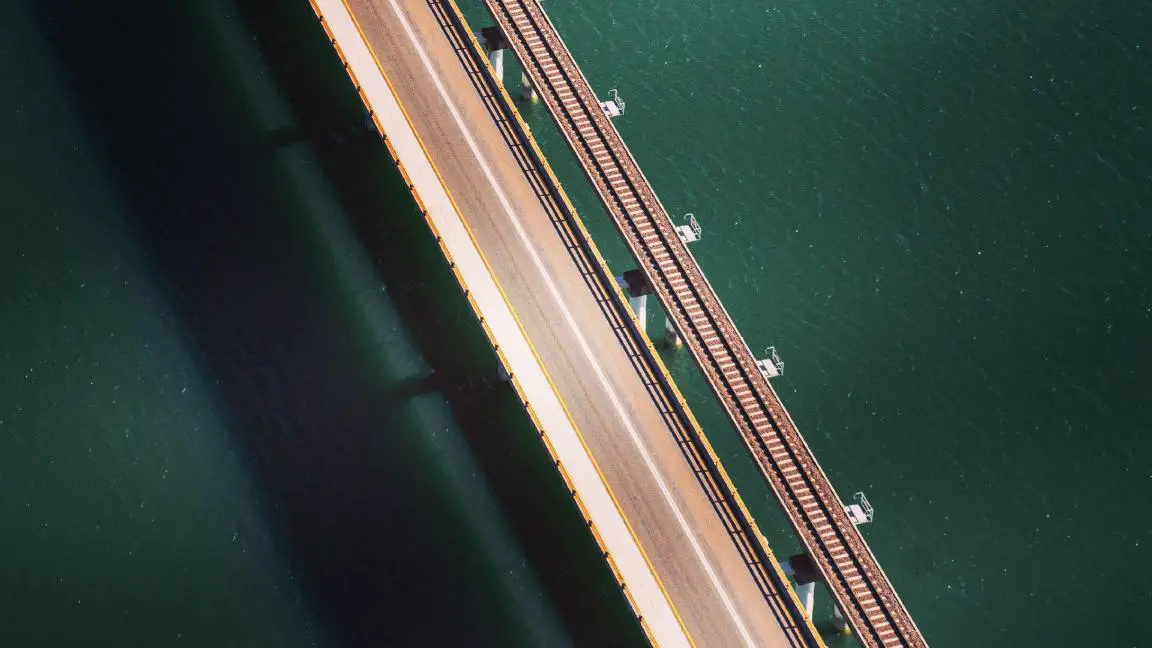
Darwin boasts a fascinating combination of vibrant subculture and breathtaking landscapes. The best time to enjoy her charm is at some stage in the dry season, from May to September.
These months provide delightful weather, characterized by clean skies, balmy temperatures, and minimum rainfall. The town comes alive with a plethora of outside sports, gala, and activities.
May marks the beginning of the dry season, with temperatures starting from 24°C to 32°C (seventy five°F to 90°F).
It’s the best time to explore the town’s attractions, embark on nature trails, and witness the lovely sunsets over the Timor Sea.
As June kicks in, the climate becomes cooler, with temperatures averaging between 21°C to 31°C (70°F to 88°F).
This duration is best for indulging in outside adventures like hiking in Litchfield National Park or taking a cruise along the Adelaide River to witness the famous leaping crocodiles.
July and August make the peak of Darwin’s visitor season. The weather remains pleasantly dry, with temperatures ranging from 20°C to 31°C (68°F to 88°F).
These months host diverse cultural festivals, together with the Darwin Festival, showcasing music, arts, and culinary delights from the region.
September marks the end of the dry season, with temperatures starting from 24°C to 33°C (75°F to 91°F).
It’s a high-quality time to visit Kakadu National Park and witness the breathtaking landscapes of their full glory before humidity and rainfall start to boom.
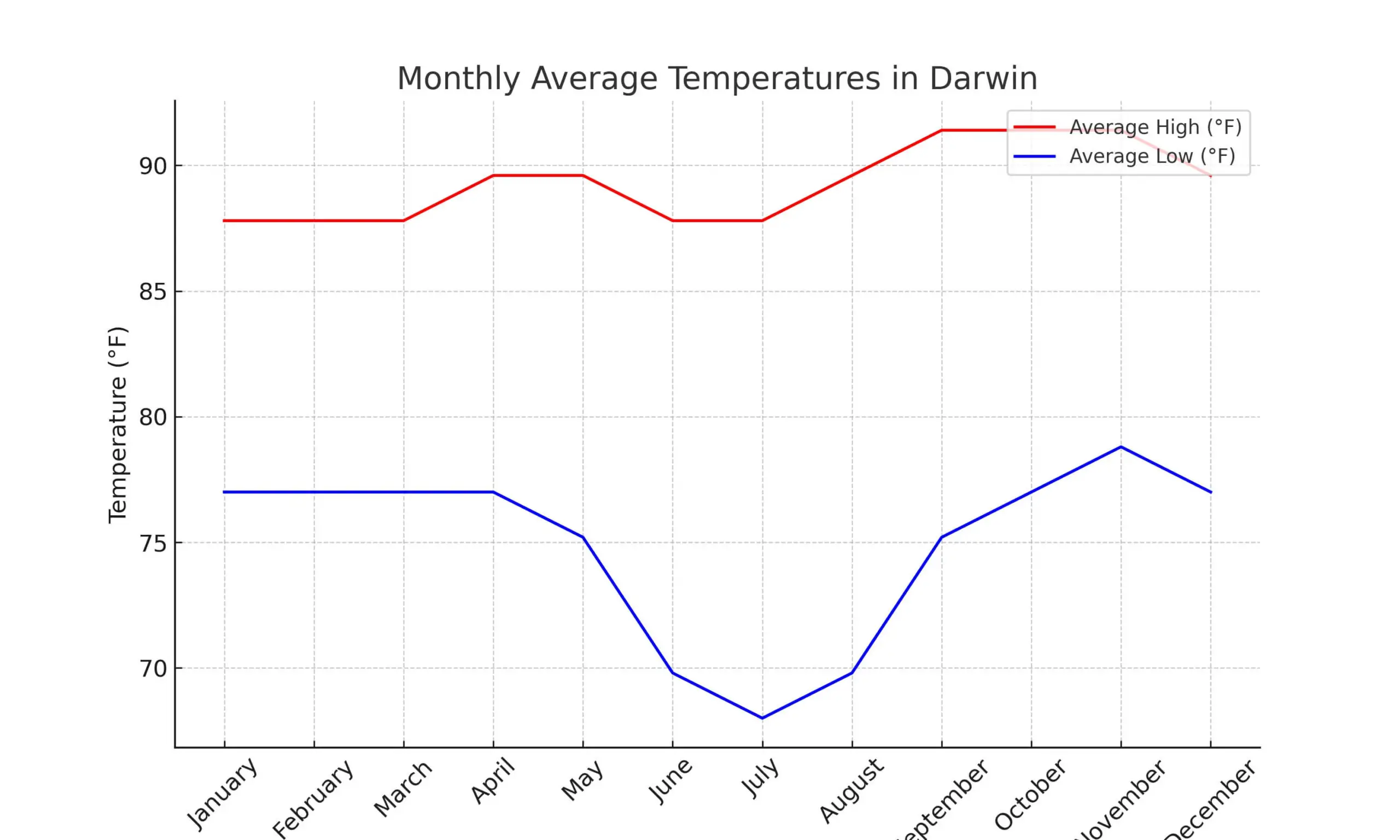
October to April represents the wet season in Darwin. Characterized by high humidity, heavy rainfall, and occasional cyclones, this time is regularly considered less favorable for travelers.
From October to December, temperatures change drastically, averaging between 25°C to 33°C (77°F to 91°F).
The humidity may be stifling, making outside sports much less enjoyable.
January to March is the peak of the moist season, marked by extreme rainfall and humidity.
Temperatures range from 24°C to 32°C (75°F to 90°F), but the humidity could make it sense much hotter.
Flash floods and avenue closures are common at some point in this period, restricting outdoor activities.
April signals the transition from the wet to the dry season. While temperatures vary from 24°C to 32°C (75°F to 90°F), heavy rainfall persists, impacting outside activities.
However, toward the end of April, the climate starts to improve, making it a barely higher time to visit as compared to earlier in the wet season.
The moist season, extending from October to April emerges as a haven for budget-friendly travelers seeking reasonable options. Accommodation rates take a massive dip, offering options of lower-priced alternatives throughout the metropolis.
Airlines, acknowledging decreased calls, often sell discounted fares, rendering travel to Darwin greater financially available, making the season more affordable to visit.
However, it’s vital to weigh those cost advantages against the backdrop of boundaries imposed by heavy rainfall and pervasive humidity in the course of this period.
The primary purpose of visiting Darwin would be her outdoor activities which will be limited during this period making your stay less productive and fascinating.
The wet season, specifically from January to March, unveils Darwin at its quietest. This period experiences a high decline in tourist footfall, remodeling attractions into serene havens and making accommodations more affordable.
The crowds offer an intimate engagement with Darwin’s essence, allowing traffic a deeper and greater non-public connection with the city’s treasures.
However, embracing this off-season allure entails a readiness to navigate the well-known moist and humid conditions.
The pinnacle of the dry season, especially in July and August, stands as Darwin’s more expensive time for travelers.
The lodges and tour packages, driven through renowned activities like the Darwin Festival, always escalates fees.
This busy duration witnesses a flurry of visitors, creating a crowded ecosystem that magnifies the attraction of Darwin’s cultural festivities, albeit at a much higher cost.
The scorching months of October and November are mostly referred to as Darwin’s zenith in temperature, boasting hovering highs of 33°C (91°F).
These months unravel a series of extreme warmth alleviated by the oppressive humidity, creating a harsh climate for outside endeavors.
The environment pulses with a sultry power, beckoning locals and traffic to seek refuge in shaded spots or indulge in aquatic escapes on the town’s lovely waterfronts.
While Darwin keeps a highly constant temperature range throughout the 12 months, the cooler months usually occur throughout June and July.
During this era, the temperatures range between 21°C to 22°C (70°F to 72°F), presenting a reprieve from the extra intense heat of the tropical climate.
The city’s atmosphere takes a refreshing turn because the mild temperatures invite locals and site visitors alike to explore outdoor sights, bask in strolls along the waterfront, or find pleasure in al fresco eating studies.
It’s a lovely time for outside activities, whether or not it is venturing into the nearby countrywide parks or taking inside the city’s cultural offerings without the sweltering heat that characterizes other components of the year.
A table showing Darwin’s weather month by month.

Ultimate Darwin Itinerary (Kakadu NP, Litchfield NP, Nitmiluk & More)
By Author Jurga
Posted on Last updated: November 11, 2023
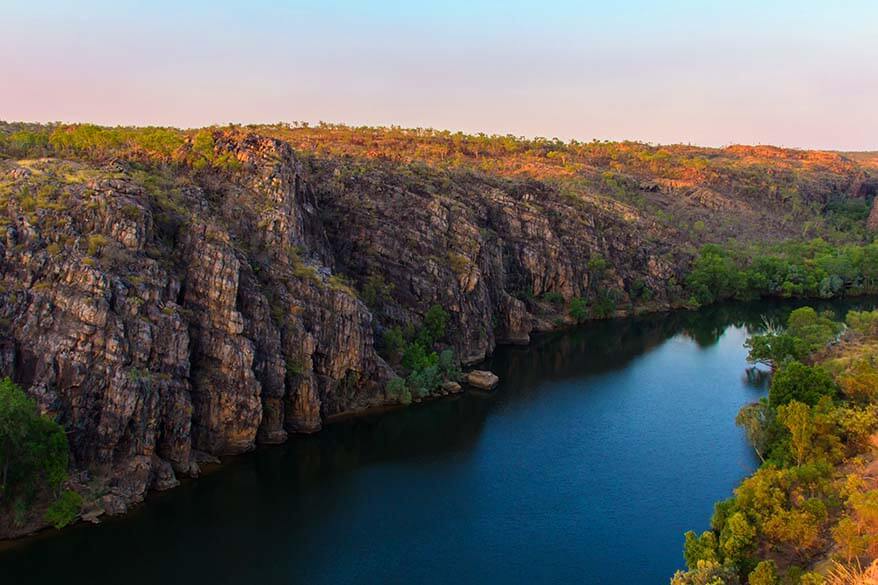
Are you planning to visit Darwin in Northern Australia and are looking for ideas on how to plan the best Darwin itinerary ? This article, written by someone who lived in Darwin for several years, should help you plan the best trip to the Darwin area.
This 7-day Darwin itinerary includes all the highlights of the Top End in the Northern Territory. This itinerary covers Darwin, Kakadu National Park, Katherine Gorge, Litchfield National Park, but also many other amazing places that will make your Darwin trip more memorable.
To make your trip planning easier, we created a map indicating all the places mentioned in this article. You can find it at the bottom of this article.
If you have less time in the Darwin area, you can also just choose to visit the main highlights. In that case, you can also use our tips to create your own custom itinerary for the Darwin area in Australia’s Top End. At the bottom of this article, you can find our suggestions on how to best plan your Darwin itinerary for 3, 4, or 5 days .
Our guest writer Daniel from Destinationless Travel lived in Darwin for two years and knows the area around Darwin as a local. He took every opportunity to explore the Northern Territory and in this itinerary, he shares all the best places to see near Darwin and the best way to do it . Furthermore, this Darwin trip itinerary is filled with insider tips and practical information for travelers visiting the Darwin area for the first time. Find out!
Darwin Trip Itinerary – OVERVIEW
- Darwin Trip Itinerary with Local Tips
- Day 1 – Darwin City
- Day 2 – Litchfield NP
- Day 3 – Edith Falls & Katherine Gorge
- Day 4 – Kakadu NP: Gunlom Falls & Maguk
- Day 5 – Kakadu NP: Ubirr, Cahills Crossing, Bowali Visitor Centeru
Day 6 – Jumping Crocs Cruise, Humpty Doo
Day 7 – back to darwin & tiwi islands day trip.
- Map of this Darwin area itinerary
- Darwin itinerary suggestions for 3, 4, or 5 days
- Practical tips
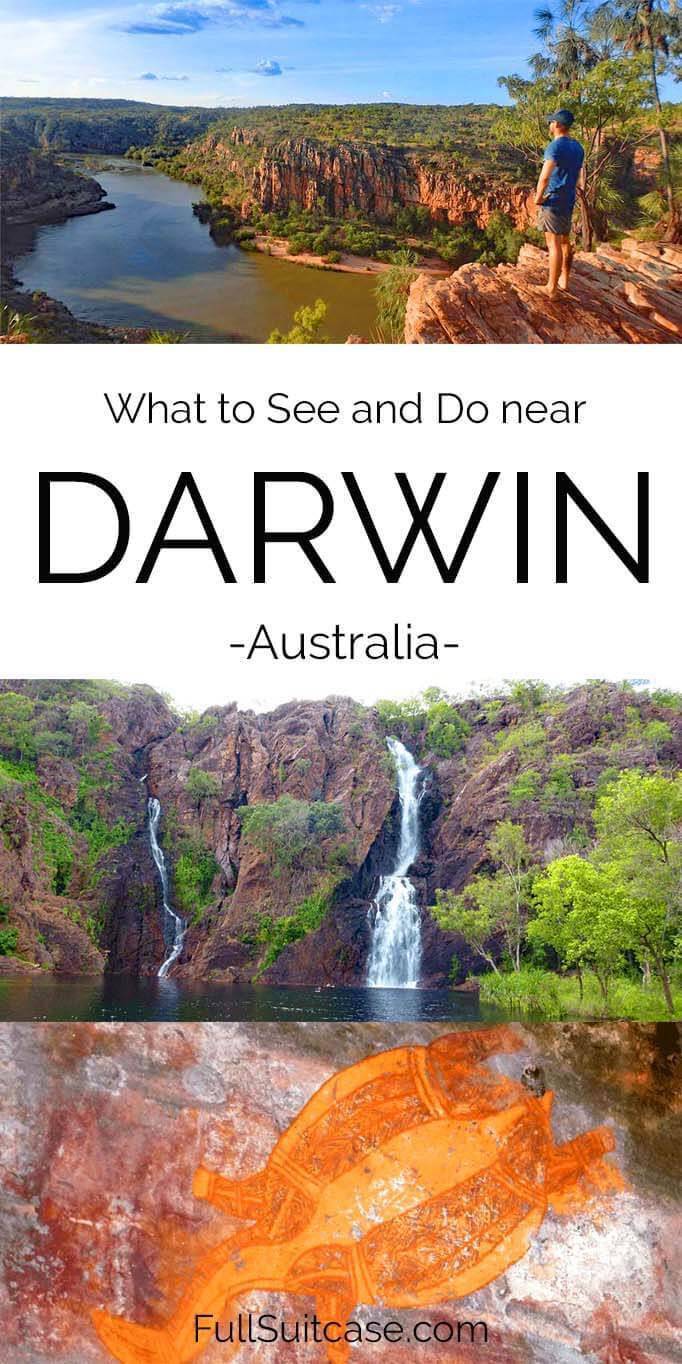
Darwin Itinerary with Tips by a Local
Darwin, Australia’s “top end,” is one of the most interesting and exciting places to explore in the entire country – well, in my opinion at least. I may be biased as Darwin is where I called home for two years and in that time, I grew to know and love this tropical paradise.
It isn’t just the city of Darwin that is impressive though. It is all of the nearby national parks, wildlife, culture, and just overall unique experiences that make visiting Darwin really special.
When I was living in Darwin, I got out and visited nearly all of the attractions in the area. And while they all were fun, there are a few that stand out above the rest. There are certain experiences that I think everyone must include in their trip itinerary when visiting Australia’s top end.
So, in this 7-day Darwin self-drive road trip itinerary, I’ve outlined the absolute best places to see and things to do when visiting Darwin and the surrounding area. You can also find lots of practical tips on how to best plan your trip, including where to stay and how to get around the Darwin area. Take a look!
TIP: If you rather not drive, there are quite a few other possibilities to explore the Top End. You can join one of the multi-day tours from Darwin or simply book day trips to the most popular places that you really should see in the Darwin area. In fact, the best places mentioned in this itinerary, are really easy to visit as a day trip from Darwin. Here you can find the best Darwin day trips . Take a look!
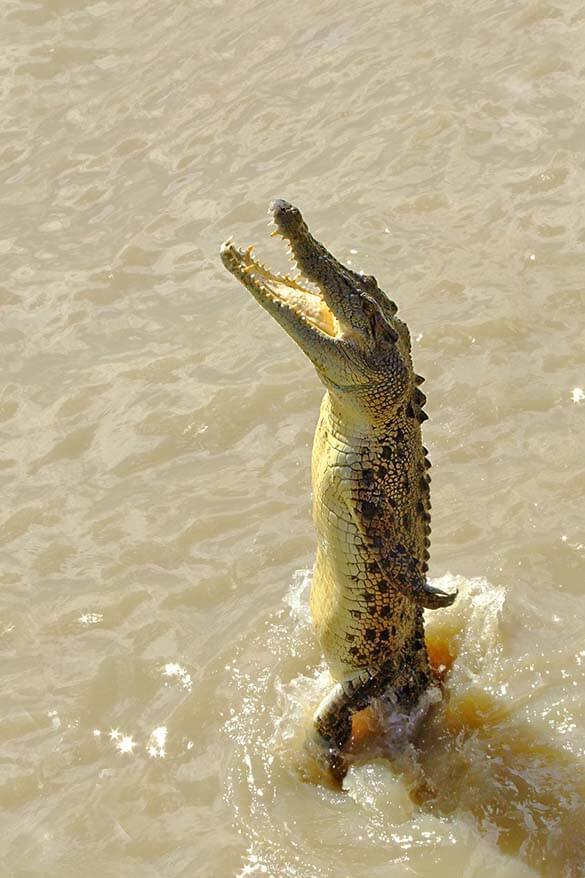
Here’s our suggested Darwin itinerary:
Day 1 – Explore Darwin City
I suggest spending your first day in the Darwin area exploring Darwin city itself. Although small, Darwin is the capital city of the Northern Territory and is rich in history, culture, and offers a big variety of things to do. The vibe in the city is relaxed, the weather is warm, and the charm is undeniable – chances are that you will love Darwin!
In all honesty, one day might not be enough to see Darwin, but with our tips below, you are sure to cover the main highlights. If you do have extra time to spare, turn this 7-day Darwin area itinerary into 8 or 9 days by extending your stay in the city. You can easily keep yourself entertained with all of the things to do in Darwin or simply just by relaxing poolside, swimming at the waterfront, enjoying live music at a local pub, or going fishing!
Anyway, if you have just one day in Darwin, make sure to check off the following activities. In my opinion, these are an absolute must. Find out!
Darwin City Tour
The easiest way to really get to know Darwin quickly is on a half-day city tour . Since Darwin isn’t huge, you can easily get around to some of the best sights in only a few hours. And with a guide, you’ll learn all about Darwin’s interesting history and the challenges the city has overcome.
Below is a list of some of the main places you should see in Darwin:
- Museum of the Northern Territory . This FREE museum in the scenic location in the Fannie Bay in Darwin has it all: from aboriginal art, an exhibit on Cyclone Tracy, to heaps of Australian wildlife and a giant stuffed crocodile ‘Sweetheart’. This 5-meter crocodile was responsible for a series of attacks on boats in the seventies and is considered to be the most famous crocodile in Australia.
- Cullen Bay Marina . Nice waterfront area with some bars and restaurants. It’s is a nice place to go for lunch.
- Darwin Military Museum . Good place to get to know more of Darwin’s history, especially around the WWII.
- Doctor’s Gully . This is a peculiar attraction in Darwin – at high tide, hundreds of fish gather in the area for feeding at Aquascene . If you want to hand-feed wild fish, this is your chance! Just make sure to check the feeding times (tide-dependent) before you go.
- George Brown Darwin Botanic Gardens . These botanical gardens have a great display of plants from Northern Australia and other tropical areas from all over the world. It’s a nice tranquil place to spend an hour or two when in Darwin.
- WWII Tunnels . A visit to these oil storage tunnels gives a good insight into Darwin’s strategic position in WWII. It’s a unique place in the Darwin area – something you probably wouldn’t even expect to find in Australia.
The organized tours usually cover all the musts, but you can also explore Darwin on your own using the Hop-On Hop-Off city bus .
Alternatively, pick up your rental car immediately upon arrival in Darwin and just drive to all the main landmarks of the city yourself (parking in Darwin is usually not a problem).
YOU MAY ALSO LIKE: How to See the Best of Sydney in 1 Day
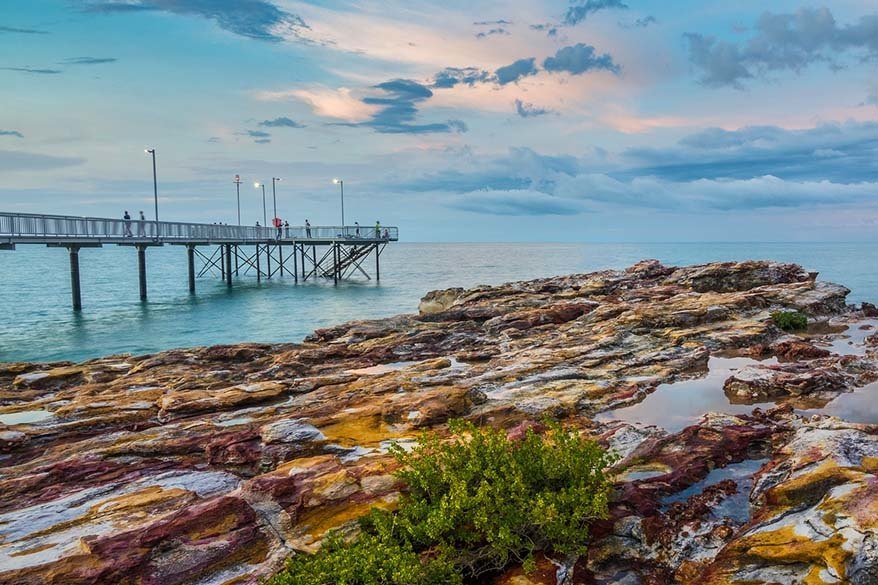
Crocosaurus Cove and Swimming with the Crocs
After you’re done exploring Darwin it’s time to hit up Mitchell Street right in the city center. Here, you can grab a bite to eat before going to Crocosaurus Cove , a wildlife experience right in the heart of the city.
At Crocosaurus Cove, you can find the world’s largest display of Australian reptiles, visit a turtle sanctuary, or interact with baby crocodiles. Of course, you can also see big crocodiles and attend a scheduled feeding.
The main highlight of any visit to Darwin’s Crocodile Cove is the Cage of Death. That’s right, you can jump in a cage in the water with saltwater crocodiles – the most dangerous breed in the entire world! Would you dare?!
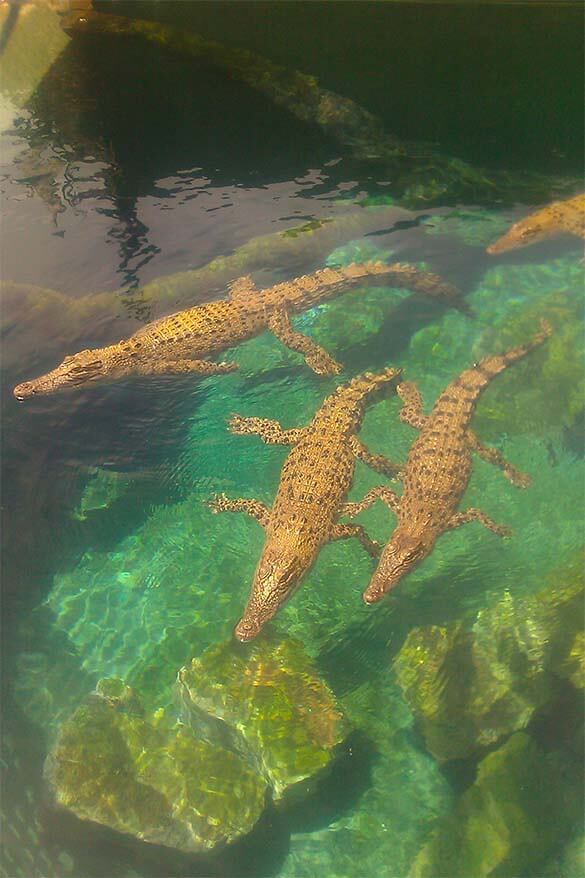
Sunset at Mindil Beach or a Sunset Cruise
Darwin is famous for the most amazing sunsets. Practically every night as the sun goes down the sky glows! You have two choices for enjoying the sunset: either go to the Mindil Markets or join a sunset cruise.
On Thursday and Sunday nights during the months of April to October, you can head to Mindil Beach. Here, they have markets where you can buy a bite to eat or go shopping before watching the sunset on the sand. If you’re in town on the right day, going to the Mindil Markets is a must. Don’t miss!
If you’re not in Darwin when the Mindil Markets are on, go on a sunset cruise instead! Some cruises offer dinner whereas some are more about views or having a couple of drinks. It doesn’t matter which cruise you choose though, they all offer the best seats around for watching the magical Darwin sunset! You can book a Darwin sunset cruise here.

Where to Stay in Darwin City
For your first night, I advise staying somewhere centrally located in Darwin. There are many different accommodation options to choose from in the city. However, there are three really nice hotels that offer an excellent price/quality ratio that I particularly recommend. Take a look!
Budget . H on Smith Hotel is a really nice hotel walking distance from everything in the city center. They have nice modern rooms, a beautiful outdoor pool, and a good restaurant.
Mid-range. Mantra on the Esplanade is located right on Darwin Harbor and offers amazing sea views. It is only a 2-minute walk from Mitchell Street and has a large outdoor pool.
Luxury. Mindil Beach Casino and Resort is set on a private beach a bit outside the city center. This 5-star resort is one of the most luxurious hotels in Darwin and is a perfect place to see the gorgeous sunsets of Mindil Beach. And it’s quite affordable too!
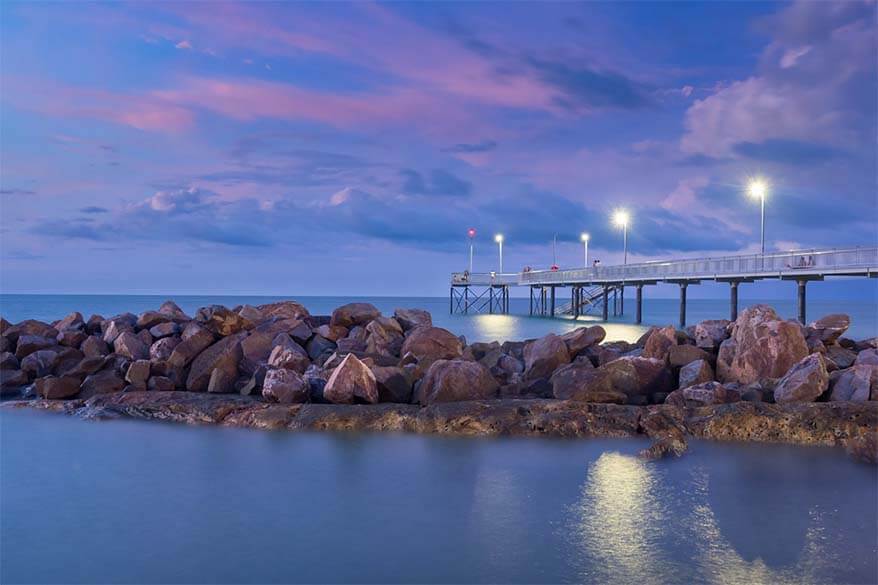
Day 2 – Berry Springs and Litchfield National Park
If not done yet, pick up your rental vehicle for the rest of this trip in Australia’s Top End. You’re going to need a car if you want to get around to the best places near Darwin without a tour. For more information about renting a car for a Darwin trip, please see the practical tips section at the bottom of this article.
Berry Springs
Only about a 40-minute drive from Darwin is Berry Springs Waterhole . This is your first swimming spot of the day!
I personally always really enjoy Berry Springs as it is a natural warm water spring in the tropics. It isn’t somewhere you need to spend a lot of time, but it is free, it is fun, and it’s what traveling in Northern Australia is about.
Berry Springs is well worth a stop on your way out of the city when driving toward Litchfield National Park.
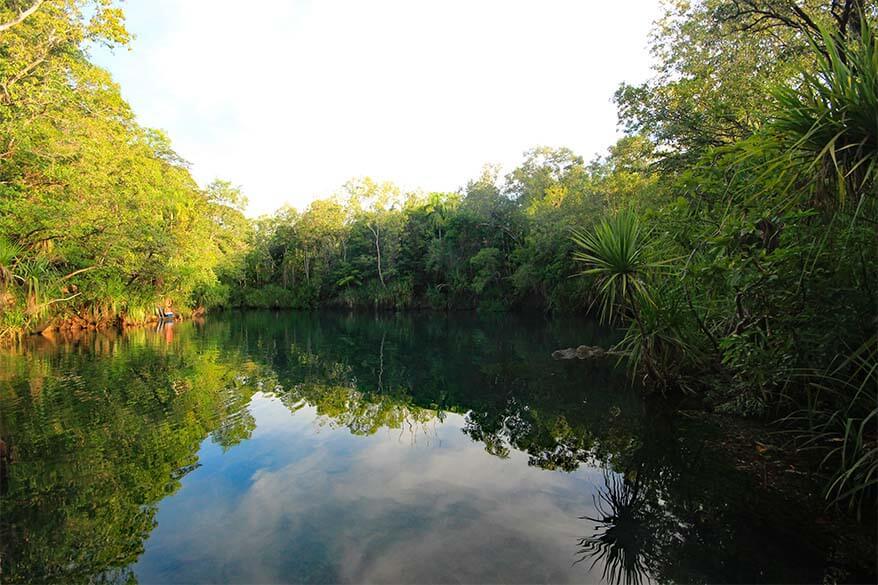
Litchfield National Park
You’ll spend the majority of this day in Litchfield National Park . Located only about an hour from Darwin, this national park has tons of waterfalls to explore and is a must-do on any Darwin trip!
In fact, many people who just visit Darwin city, go on a day trip out to Litchfield returning back to Darwin in the evening . That’s a good option for those who rather base themselves in the city and not worry about renting a car or driving in the Australian Outback. But if you are doing a self-drive trip in Darwin area, Litchfield is on your way out to many other amazing places, as you’ll see further in this Australia’s Top End itinerary.
There is a lot to see and do in Litchfield National Park . The good thing is that you can see most of the highlights in a day. Below is a list of the nicest places you really shouldn’t miss in Litchfield National Park:
Wangi Falls . This massive waterfall is beautiful! You can swim in the bottom plunge pool or take a short (but steep) hike up to the top for a view of the park.
Florence Falls . This is my personal favorite place in Litchfield! Florence falls is not one, but two waterfalls going into one pool that is perfect for swimming. The falls are located at the end of a short walk through the park. The walk is nothing short of stunning.
Buley Rock Pools (Buley Rockhole) . These pools are perfect for relaxing and a great place to cool off during the day. Buley Rock Pools are open all year round.
Magnetic Termite Mounds . Have you ever seen termite mounds as tall as yourself? Well, if you haven’t, be sure to stop here in the park and see some! It is just a quick stop but it’s totally worth it and it’s an interesting place to see. Some termite hills are over 12 feet high!
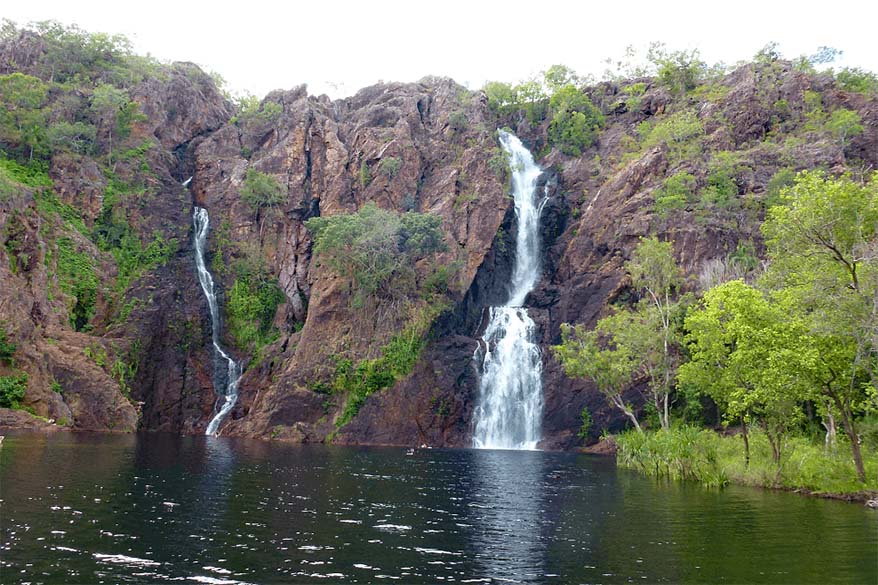
Where to Stay near Litchfield NP
if you want to stay inside Litchfield National Park, you’ll have to camp. Alternatively, stay in a hotel in Batchelor town, which is just on the outskirts of Litchfield NP. You can also opt to drive back to Darwin and stay there. This just means you’ll have a little more driving to do.
Camping in Litchfield . You can actually camp inside Litchfield National Park. There are paid campgrounds at both Florence Falls and Wangi Falls. They cost $6.60 per person and have bathroom faculties and as well as fire pits for cooking. The campsites are first come first serve and you just pay the ranger in cash.
Accommodation in Batchelor. In Batchelor, I recommend staying at the Batchelor Butterfly Farm . It is a small family-run bed and breakfast right in Batchelor town. They offer home-cooked meals and have a beautiful garden complete with plenty of butterflies! It is a fun place to stay that offers good value for your money.
There are several other accommodation options in Batchelor , but the choice is really limited. So if you are exploring the Darwin area on a self-drive trip and want to save some driving, make sure to book your lodging in advance!
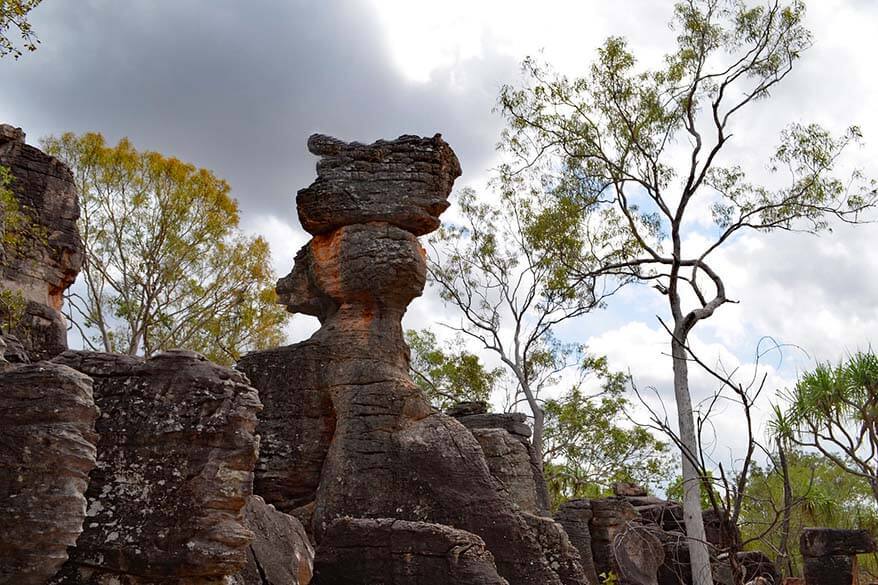
Day 3 – Drive to Katherine, Edith Falls, and Katherine Gorge
Katherine is a town many people miss when they visit Darwin and the Northern Territory (which is unfortunate.) It is small, but there are actually a couple of awesome attractions. In fact, when I lived in Darwin, I visited Katherine on several occasions and absolutely loved it!
Good to know: Just as Litchfield, Katherine Gorge and Edith Falls can be visited as a day trip from Darwin .
Edith Falls
Your first stop of the day should be Edith Falls . Edith Falls is on the way between Batchelor and Katherine. From Batchelor, the drive to Edith Falls should take you about 2 hours, and then from there, it’s a 40-minute drive to Katherine.
At Edith Falls you can explore the different levels of plunge pools. Spend an hour or two here before heading towards the town of Katherine. In Katherine, you can stop for lunch before visiting the Katherine Gorge.
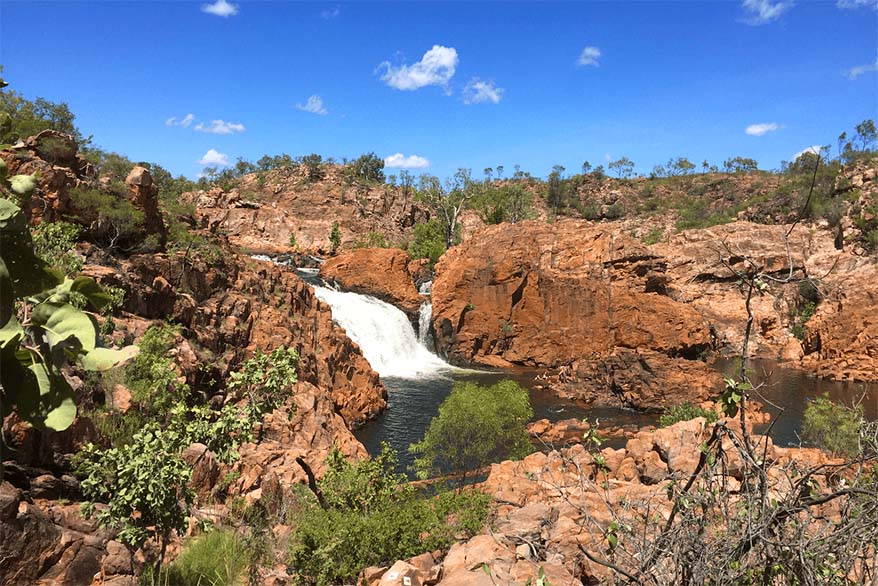
Katherine Gorge – Nitmiluk Gorge
The Katherine Gorge (also known as Nitmiluk Gorge ) is the biggest attraction in Katherine. This deep, water-filled gorge has been featured in many different movies due to its large dramatic cliff faces.
The best way to enjoy the Katherine Gorge is on a boat cruise. The gorge itself is full of crocodiles so it’s not recommended to go swimming here! But from the safety of a boat, you can see the full scale and beauty of the Katherine Gorge.
Nitmiluk Tours offers a range of different boat cruises at Katherine Gorge. Most tours go for 2-3 hours allowing you to spend your afternoon here before heading back to Katherine town for dinner. Alternatively, you can opt for the sunset dinner boat cruise.
TIP: Katherine Gorge cruises are very popular, so be sure to research and book in advance so you don’t miss out! You can find a few options for the Nitimiluk Gorge boat cruise here and otherwise, look online.
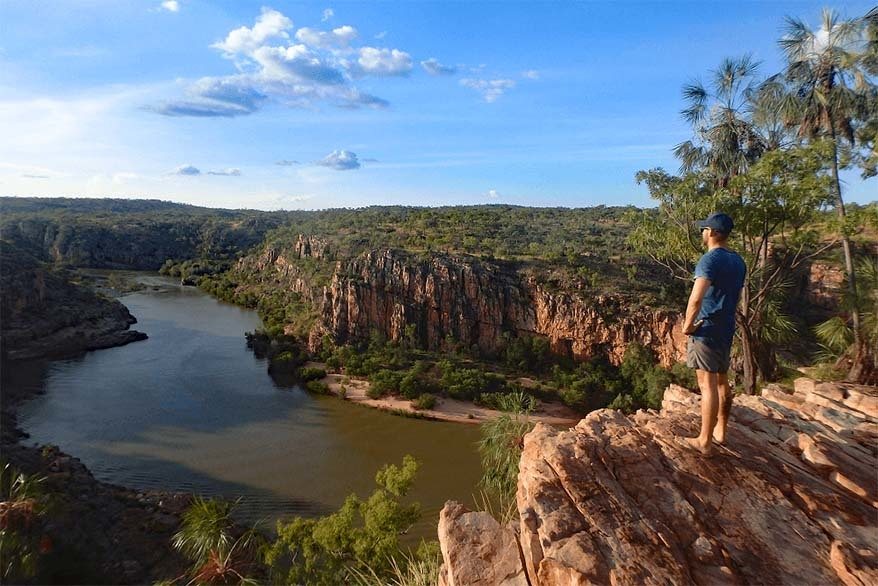
Katherine Hot Springs
If you still have some time when you get back to Katherine town, I recommend going for a swim in Katherine Hot Springs. The water is lovely and warm – it’s a great place to end your day in the Katherine area.
Where to Stay in Katherine
There are several accommodation options in Katherine, most in the lower to the mid-budget range. There is also one really nice luxury accommodation that will make you want to stay longer. Take a look.
Pine Tree Motel. A great budget Motel right in the middle of town. It’s not fancy but has a pool and everything else you could need.
Katherine River Lodge . A simple motel with big rooms that can accommodate 4 people. It has a swimming pool, a restaurant, and kids’ play area.
Knotts Crossing Resort . Good mid-range accommodation in Katherine town center. It offers cottages and rooms for different group sizes, has a pool and a restaurant.
Cicada Lodge . Located about 20km from town and just next to Katherine Gorge, this lodge is simply stunning. This is also the only luxury lodging option in Katherine. It’s all about getting out into the stunning landscape and enjoying beautiful sunsets surrounded by nature! If you can afford it, this is by far the nicest place to stay near Katherine. It’s one of those hotels that make your entire trip so much more memorable.
TIP: While finding a place to stay in Katherine shouldn’t be a problem, it’s still Australian Outback and options are rather limited. Therefore we do recommend booking Katherine accommodation in advance.
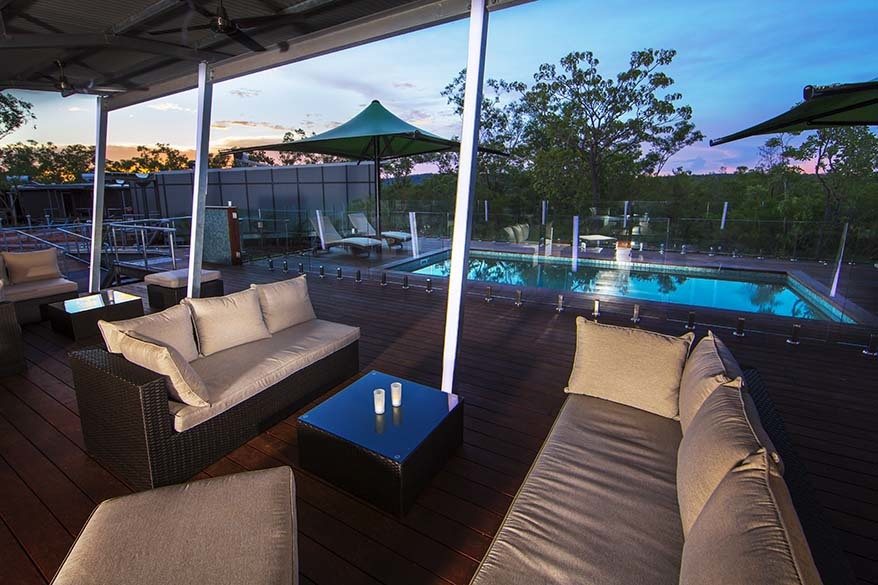
Day 4 – Kakadu National Park: Gunlom Falls and Maguk
Kakadu National Park is one of my absolute favorite parks in all of Australia. It is beautiful and full of culture to learn about. This is an absolute must-visit place in the Top End!
While you could easily spend a week in Kakadu (I have visited for several days on numerous occasions and never got bored), below you can find the very best spots for the sake of this shorter itinerary. If you have more time to spare, I recommend extending your stay in Kakadu, so that you can really take your time enjoying everything it has to offer.
TIP: Be sure to have breakfast before you leave and stop at a grocery store in Katherine in case you plan on camping and cooking your own food for the next two days. Even if you are not camping, you’ll want to take a picnic lunch with you.
Gunlom Falls – Gunlom Waterfall Creek
From Katherine, it will take about 3.5 hours to get to Gunlom Falls . This drive, although long, is gorgeous and much of it is spent driving through Kakadu National Park.
Gunlom Falls is a huge waterfall and while swimming in the bottom plunge pool is nice, the highlight of these falls is climbing to the top! At the top, you’ll find a natural “infinity pool” where you can swim and enjoy the views!
At the bottom of Gunlom Falls, there are picnic facilities, so you can have a picnic lunch here as well.
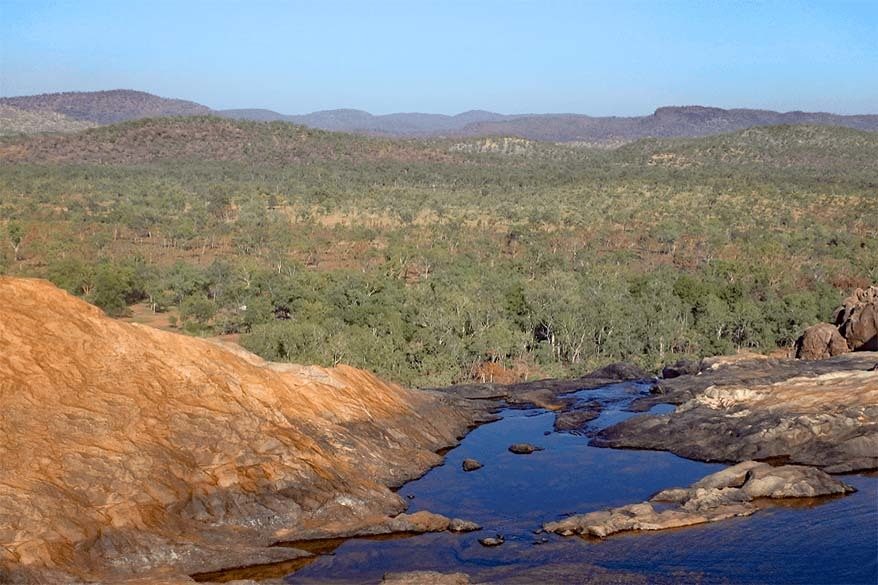
Barramundi Gorge – Maguk
Maguk (also known as Barramundi Gorge ) is your last stop for the day. From Gunlom Falls it’ll take about 2.5 hours to get to Maguk. Yes, there is a lot of driving today but it is totally worth it.
Maguk offers plenty of natural pools and underwater caves to explore. There is also a waterfall. It’s a really beautiful swimming hole and a great place to relax.
Where to Stay in Kakadu National Park
I love camping at Maguk. This means no more driving for the day and you can relax in the natural pools (also take a dip in the pools the next morning). Maguk campground costs just a few AUD and is a first come first serve basis. You’ll find toilet facilities, picnic tables, and fire pits.
If you are not camping, then the best place to stay is Cooinda Lodge Kakadu , which is just a 1-hour drive from Maguk. If it’s fully booked, try Jabiru town, which is about 1.5-hour drive. In Jabiru there are two accommodation options – Mercure Kakadu Crocodile and Kakadu Lodge .
TIP: Make sure to book your Kakadu NP lodging well in advance because they often book up!

*Optional Additional Day . You can turn this 7-day itinerary into 8 days by adding on one extra day in Kakadu National Park. You’ll definitely need a 4wd if you decide to do this! Drive out for 3 hours to Jim Jim Falls and then visit Twin Falls. If you are camping, you can spend the night here. Jim Jim Falls is one of my favorite falls in the park and stands at over 200m high! These places are beautiful to visit but are only open during certain weather conditions. Be sure to check that they are open before you go and be prepared for a few extra hours of driving!
Day 5 – Kakadu NP: Ubirr, Cahills Crossing, Bowali Visitor Center in Jabiru
Your second day in Kakadu National Park is less about waterfalls (by now you’ll have seen plenty of them) and more about culture! The indigenous culture in Kakadu is strong and worthwhile learning about. No trip to the Northern Territory is complete without educating yourself on the indigenous people who called Australia home long before anyone else did.
Ubirr Rock Art Sites
After breakfast head out to Ubirr. Depending on where you spend the night, the drive can be just 40 minutes (from Jabiru) or about 2 hours (from Maguk). You will pass through the small town of Jabiru on the way. Here you can stock up on fuel or groceries before continuing on to Ubirr.
Once you’re at Ubirr , park your vehicle and get on your walking shoes. The Ubirr Rock Art Sites Walk is a 1-kilometer trail that takes you past ancient rock art. Some of the rock art sites at Ubirr are some 40,000 years old, and you’ll find lots of informational panels along the way. You should also climb up 250m to a viewpoint over the Nadab floodplain – it is gorgeous.
TIP: If you want even more information on the artwork and history of the land, I recommend going on a guided ranger walk. You’ll need to check the official NP website in advance to make sure you know when the guided walk for that day takes place.
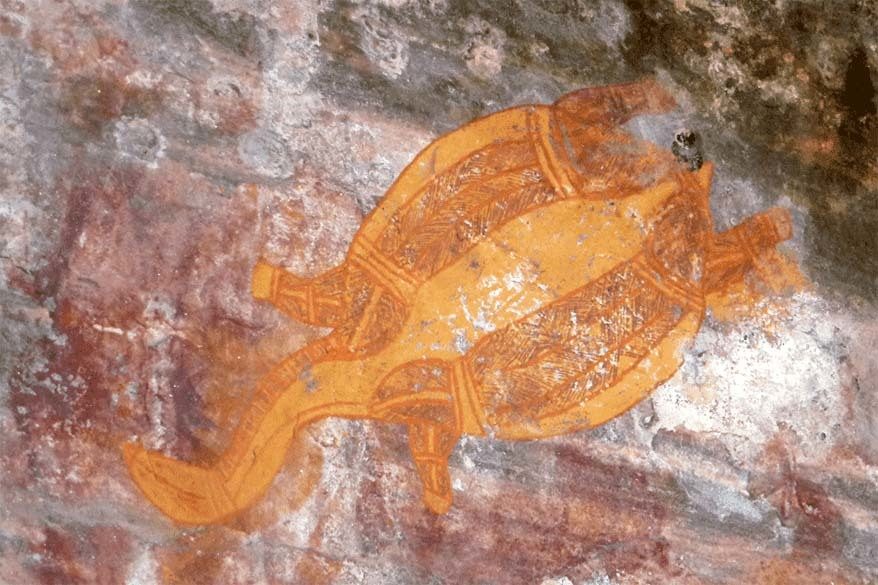
Cahills Crossing
Have you ever wanted to see a saltwater crocodile in the wild? Well, you are almost guaranteed to see one at Cahills Crossing . This is an actual river crossing for 4wd’s across a croc-infested river to Arnhem Land.
You cannot cross into Arnhem Land without a permit obtained by the Northern Land Council. However, you can walk along the river to a viewpoint and try to spot crocodiles.
This is actually the most crocodile populated area in Australia. Around 30 crocodiles live in this tiny area, so you’ll definitely get to see some.
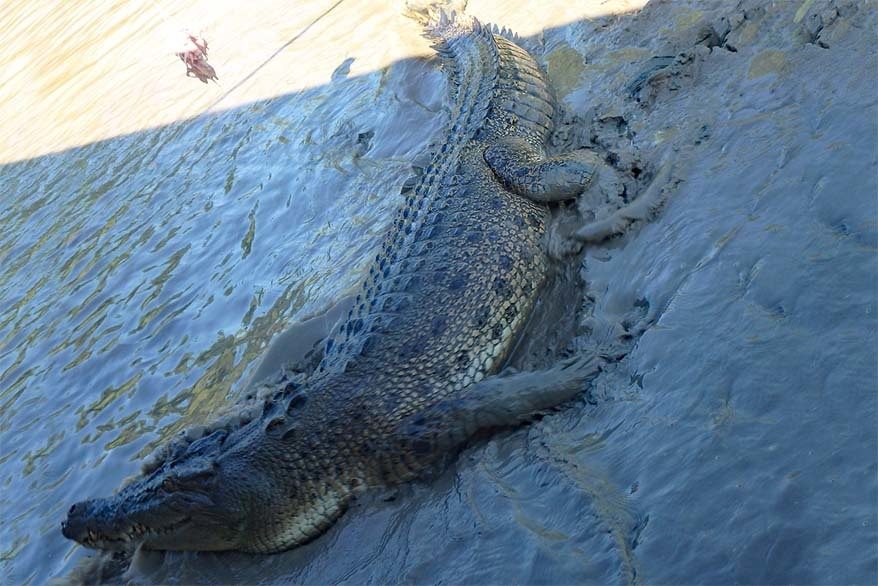
Bowali Visitor Center
After you’ve seen a few crocs, drive back to Jabiru and visit the Bowali Visitor Center . Here you can check out their many displays and learn more about Kakadu and the park. It is actually very interesting and you can easily spend an hour here.
This is your last attraction for the day so feel free to take your time!
Where to Stay in Jabiru
Tonight, it’s best to stay in Jabiru. This is the only “town” in Kakadu National Park. It is very small but there are hotels, restaurants, and small shops. Once again, you can choose to camp or stay in a hotel.
Camping. The Kakadu Lodge (which also has bungalows with shared- or private bathrooms) has over 200 campsites. This is a proper holiday park with many facilities and even a huge outdoor pool! After roughing it for a night this will definitely be a luxurious camping experience!
Hotel . The Mercure Kakadu Crocodile is a beautiful hotel offering a comfortable stay right in the heart of Jabiru. All rooms have air conditioning and there is a large pool on site along with a bar and restaurant.
TIP: While not easy to see everything in a day, it is possible to visit Kakadu National Park as a day trip from Darwin. Here is the best-rated and most complete Kakadu day trip I was able to find.
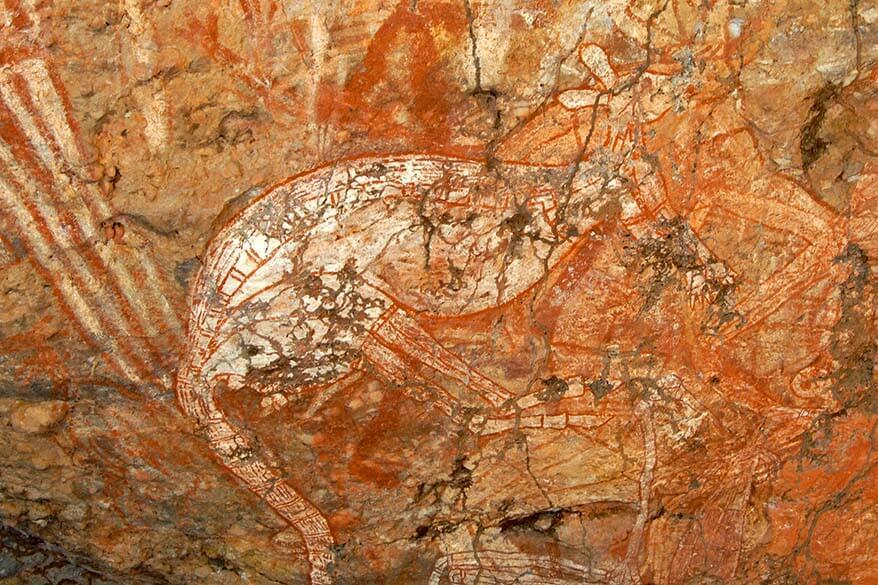
This morning you can relax and sleep in for a bit. The last couple of days have been busy, so enjoy a nice breakfast in Jabiru and maybe even a morning swim before hitting the road again!
Jumping Croc Cruise
Depart from Jabiru and head to Adelaide River. Here, you can jump on a boat for a “ jumping croc cruise !” From Jabiru to the departure points for the cruises, it is about a 2-hour drive along the Arnhem Highway.
But what is a jumping croc cruise? Well, it is a boat cruise out on a saltwater crocodile-infested river. The guide will use chicken to lure crocs up to the boat. The crocs use their tails and power to jump out of the water to get the chicken – it is amazing!
There is no other experience in the world where you can get so close to such a dangerous, yet amazing, creature. Seeing these crocodiles only feet away from the boat attack the chicken carcass is a unique experience I guarantee you’ll remember for a lifetime.
TIP: Be sure to book your jumping croc cruise in advance to avoid it filling up. There are a few different companies to choose from. Just be sure to book one later on in the day to allow yourself enough time to get there. If you are not driving, this is also something you can easily do with an organized day tour from Darwin .
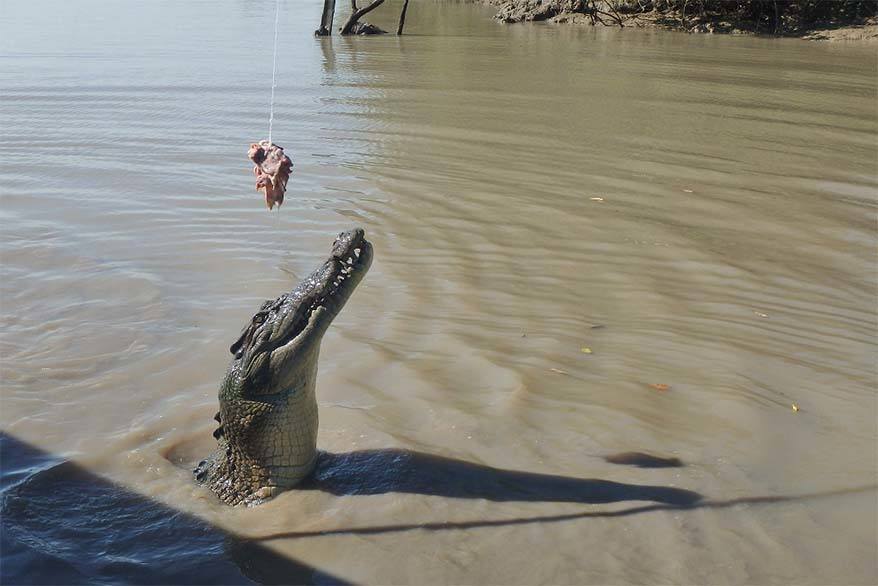
Humpty Doo Tavern
For dinner, make a short drive (+-30min) to the Humpty Doo Hotel and Pub . This iconic pub is known for serving the best buffalo, crocodile, and barramundi burgers around. Sounds weird right? Well, it might be, but they are delicious!
Also, if you ever wanted to have a conversation with a real-life “Crocodile Dundee-type”, then the pub is your chance to do so. Expect a crowd of locals who live in the Australian outback, live music, and maybe even dancing on tables!
Where to Stay
If you want to spend an evening with the locals in the Australian outback, then this is your chance. The Humpty Doo Pub is also a hotel, and although not the fanciest, it will do the trick for somewhere to rest your head for the night. There are also a few other lodging options nearby .
Otherwise, you can get back to Darwin and spend the night there. The Humpty Doo Hotel is only about a 30-minute drive from Darwin City Center and staying in town will give you the possibility to make a really special day trip on your last day of this itinerary (recommended). See below.
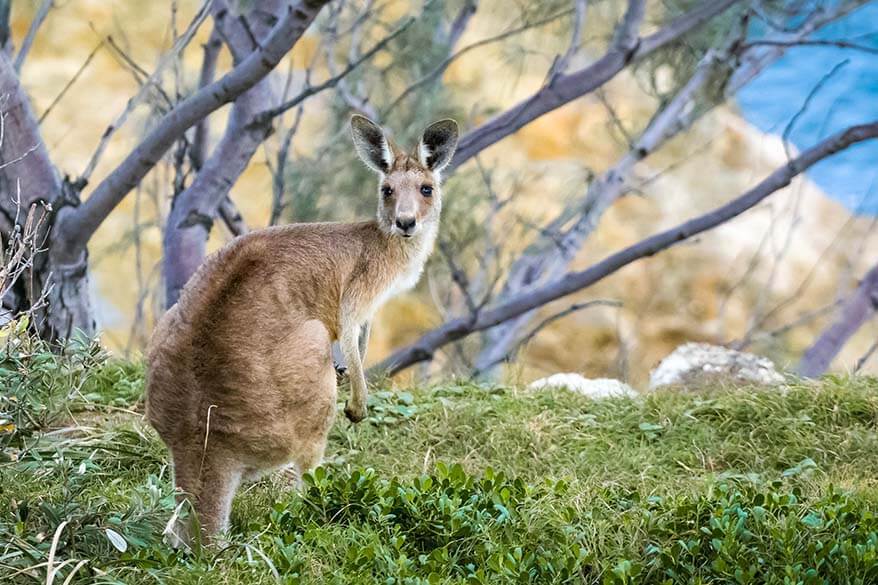
Today is the last day of this 7-day Darwin trip. If not done the previous night, it’s time to head back to the city. The short drive allows enough time to catch a flight or if you want, stay another night in Darwin and see some of the places you might have missed at the beginning of your trip.
If you have the whole day free, consider doing something really special and join this highly-rated Tiwi Islands cultural day tour . You’ll experience a traditional Tiwi welcome smoking ceremony, meet the locals, explore the art center, museum, and Catholic mission precinct with a local guide. You can even make your own Tiwi-style art piece or get some authentic souvenirs.
This is your chance to get to know the local Aboriginal culture and do something truly unique that will make your trip to Darwin unforgettable.
For places to stay in Darwin, please check our suggestions on day 1 of this itinerary.

Darwin Itinerary Map
To make your Darwin trip planning easier, I created this map indicating all the places mentioned in this article.
As you can see, it’s a circular trip, so it would also be possible to turn it around so that you start with Kakadu National Park and end in Litchfield (although, we do suggest leaving the best for last).
How to use this map: Use your computer mouse (or fingers) to zoom in or out. Click on the icons to get more information about each place. Click the arrow on the top left corner for the index. Click the star next to the map’s title to add it to your Google Maps account. To view the saved map on your smartphone or PC, open Google Maps, click the menu and go to ‘Your Places’/’Maps’. If you want to print the map or see it in a bigger window, click on ‘View larger map’ in the top right corner.
So, this is our suggested Darwin and Darwin area itinerary that covers all the best places in Australia’s Top End in one week. You will see wildlife, learn about indigenous culture, camp, swim under waterfalls, and of course, explore some of the Northern Territory’s most interesting towns.
It is a side of Australia that many people miss, but it is incredible and typically Australian. Darwin area is well worth a trip if you want to experience the more local and traditional side of Australia. I hope you’ll enjoy Darwin just as much as I did!
Below, you can find some Darwin itinerary suggestions for a shorter trip – take a look!
Darwin Area Itinerary Suggestions for 3, 4, or 5 Days
While we suggest spending at least one week in Darwin in order to see all the main highlights of Australia’s Top End, we understand that not everyone has that much time. Therefore we also have some suggestions for shorter trips if you have less time in Darwin. Take a look!
If you have three days in Darwin , visit Darwin city, Litchfield NP, and take a day trip to either Kakadu or Katherine Gorge.
With four days in Darwin , do all of the above: visit Darwin and take day trips to Litchfield, Kakadu, and Katherine Gorge. It’s probably easiest to just base yourself in the city and take day trips (unless you’re ok with full sightseeing days AND doing lots of driving yourself).
If you have five days in Darwin , you can pretty much follow our itinerary suggestions from day 1 to day 5 and drive back to Darwin from Jabiru.
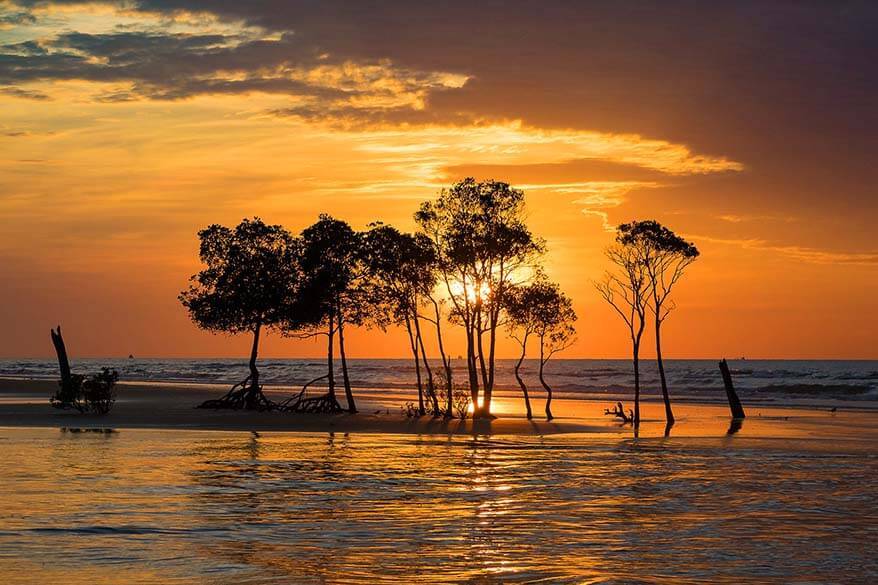
Practical Tips for Your Darwin Trip
The best time to visit Darwin is the dry season from April/May until September/October. If you are planning to travel in the rainy season, you should know that some roads may get inaccessible.
You will need a rental car if you decide to visit the Darwin area on a self-drive road trip instead of taking organized tours. You can find some of the best deals for car rental here .
It’s best to rent a 4wd as many of the roads inside the National Parks are gravel and suitable for 4wd cars only. The biggest part of this itinerary is on paved roads, but there are also some parts, like for example, Gunlom Falls and Maguk that are best visited in a 4wd.
Some car rental companies offer to rent camping equipment (sleeping bags, mats, and a tent) as well. If you want to save on accommodation, this could be a good idea and you’ll have plenty of opportunities to camp! Alternatively, hire a 4wd with a pop-up tent on the top – it would be perfect for this trip! If you don’t camp, don’t worry. As you can see, there are accommodation options for each place mentioned in this itinerary.
TIP: Make sure your rental vehicle is allowed on gravel roads if you are planning to drive them. Cars that aren’t allowed, have signs on them offering rewards (around $100) to people who can take a photo and report you to the rental company!
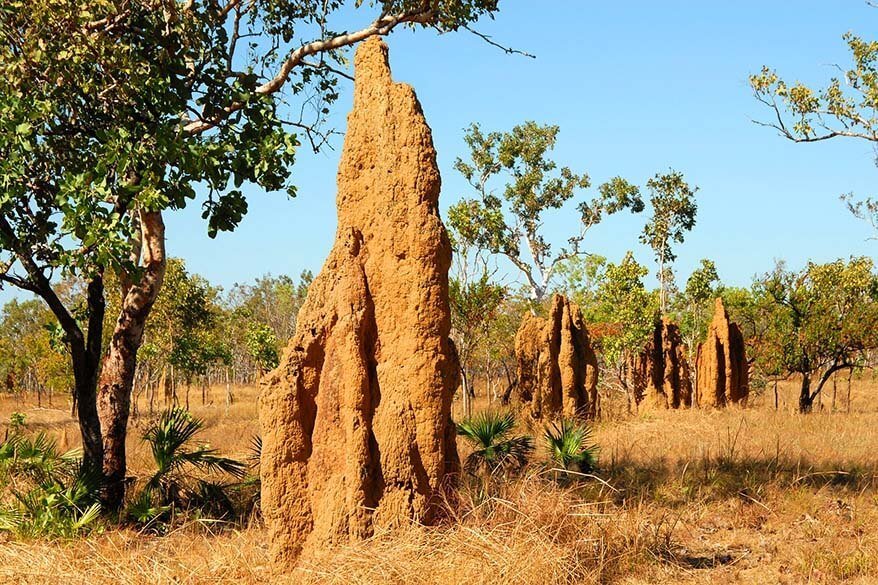
Thanks again to our guest writer Daniel for these wonderful tips for visiting the Darwin area. Even though we have visited Australia twice, we still haven’t been to the Top End. This article left me googling flights to Darwin…
About the author. Daniel is a professional photographer, skydiver, and travel blogger. He uses travel as a way to fulfill his need for adventure and excitement. Daniel is now a full-time traveler exploring the world continually and enjoying the journey along the way. With his partner Bailey, the two write about all of their travels on their blog, Destinationless Travel !
TIP: If you are visiting Australia, make sure to check our tips for planning Australia trip , as well as our Australia itinerary , and articles about some of our favorite places including the Red Center , Kangaroo Island , Sydney , Melbourne , and Hobart (Tasmania), to name just a few. Check it out!
READ ALSO: Best Stops on the Great Ocean Road, Australia
If you found this post helpful, don’t forget to bookmark it and share it with your friends. Are you on Pinterest? Pin this image!
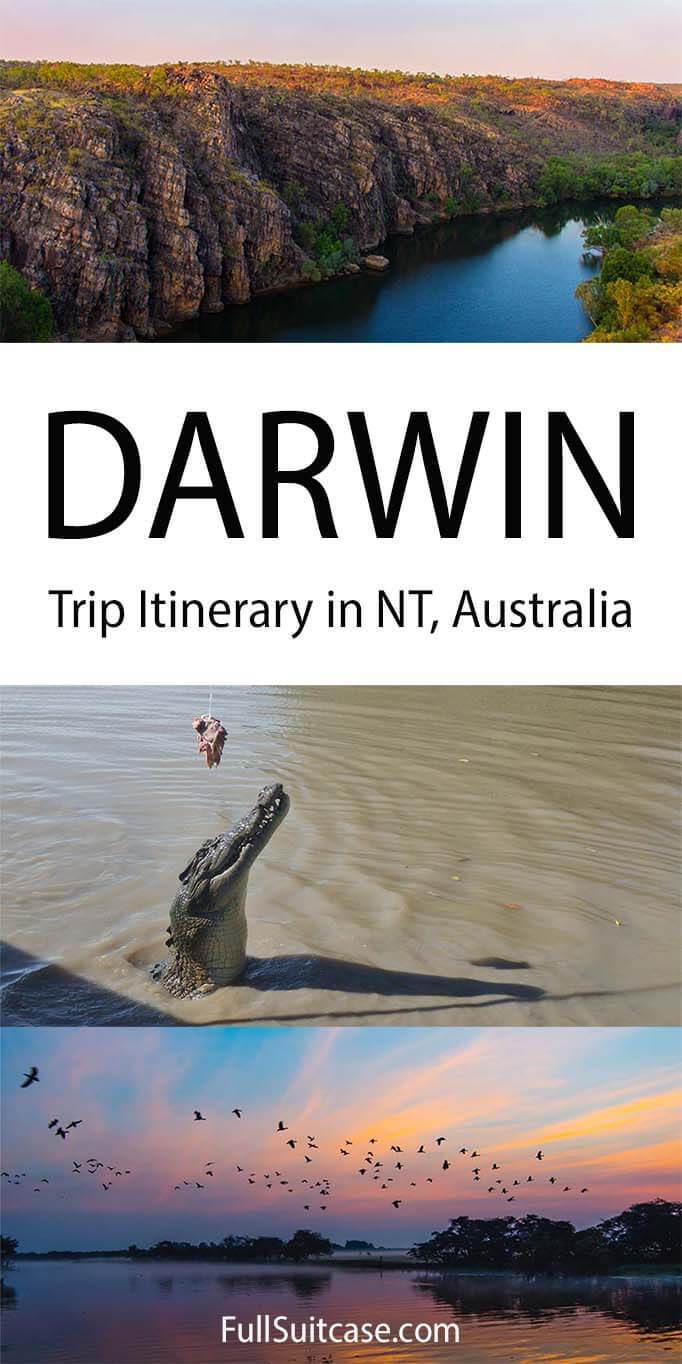
This site uses Akismet to reduce spam. Learn how your comment data is processed .
Peter Midtvik
Friday 21st of July 2023
Looking at the 7 day itinery I would like to do that by a tour company who do you sugest I contact that I get exactly the itinery. It is very good information Plan going September.Await your reply as to my enq Regards Pete
Saturday 22nd of July 2023
Hi Peter, our blog is meant to help people plan their own trips. I'm afraid I can't help you much with group trips, but I'm sure there are plenty. Take a look on Viator, there are quite a few multi-day trips in this part of Australia. Maybe you'll find something that suits your travel dates and interests. Here is just one highly-rated tour example and there are many more. You can search for Darwin and then filter by multi-day trips to see what's available. Hope this helps.
Tuesday 18th of July 2023
This is a great resource. It doesn't mention park passes though which you need if you are a non-resident of NT. You need one pass from Parks Australia for Kakadu and as of 3 April 2023, another from the NT government for Litchfield and Katherine Gorge.
Thanks for the info, Glen.
Tuesday 15th of October 2019
Great article. I have done recently a road trip from Perth to Broom, Darwin and, Cairns. Beautiful places - recommended.
Thank you, Lenka. Yes, traveling in Australia is always a special experience and especially a bit off the main routes up North. Happy travels!
Best Time To Visit Darwin
Top hotel collections.

Backpacker Hostels
Near Airport
What is the best time to visit Darwin?
it is the 'dry season' in Darwin from April/May to September/October. It brings along itself a beautiful weather with warm days and clear skies which definitely makes it the best time to visit.
Weather in Darwin

Upcoming Darwin Weather
Monthly weather in darwin, related posts.
Best Time to Visit Australia
Things To Do In Darwin

Darwin Military Museum

Darwin Harbour

Mindil Beach

Litchfield National Park

Charles Darwin National Park

Mindil Beach Sunset Markets
Nearby Places

Darwin Photos

+ 32 photos
Browse Package Collections
Nearby destinations for packages.
Great Barrier Reef
Browse Hotel Collections
By hotel type.
Best Resorts In Darwin
Backpacker Hostels In Darwin
Hostels In Darwin
Motels In Darwin
Campsites In Darwin
Bed And Breakfast In Darwin
By Budget Category
Cheap Hotels In Darwin
Best Luxury Hotels In Darwin
By Star Category
5 Star Hotels In Darwin
3 Star Hotels In Darwin
With Specific Facilities
Cabins In Darwin
Pet Friendly Hotels In Darwin
Near Landmarks
Hotels At Darwin Airport
Darwin Hotels Near Airport
Similar Places

Get the best offers on Travel Packages
Compare package quotes from top travel agents
- India (+91)
*Final prices will be shared by our partner agents based on your requirements.
Log in to your account
Welcome to holidify.
Forget Password?
Share this page

Climate - Darwin (Australia)

Darwin - Climate data
Darwin - weather by month.
Best time to visit Darwin, NT
- Post last modified: December 8, 2023

Darwin may always be hot — daytime temperatures hit the 30s year round — but you can choose between sun-baked and soaked. Do like most and visit during the dry season from May to October when the skies are enchantingly blue. Or, if you chase good deals and want to see the waterfalls cascading at their highest flow rate, come during the wet season between November and April.
May – October (dry season)
May through October is the peak travel season in Darwin, characterised by sunny days and an upbeat vibe. Now the city brims with energy, best displayed at flavourful Mindil Beach Sunset Market, which draws big crowds with its wide array of stalls selling all from food and drinks to arts and crafts on Thursdays and Sundays.
Should you decide to visit during this period, book your accommodation as soon as you can. Although Darwin hotels recognise the appeal of the dry and charge premiums (sometimes as steep as Jim Jim Falls), they regularly sell out.
November – April (wet season)
If you don’t let the signature high humidity, heavy rains or frequent storms deter you, the wet season can be a beautiful time to visit Darwin. Embrace the absence of tourist hordes as you tour the city centre, relax in the waterfront precinct and marvel at cascading waterfalls and rivers filling up in the great national parks, including Litchfield and Kakadu.
While Mindil Beach Sunset Market is in hibernation, less touristy Parap Village Markets — 10 minutes’ ride from the CBD — braves the weather and runs every Saturday morning year round. Make your way over to savour yummy tastes of Asia and Australia and stock up on the fresh produce of the season.
More Darwin
Best things to do in Darwin
Where to stay in Darwin
Share this straya guide Share this content
- Opens in a new window
You are using an outdated browser that we're unable to support. Please upgrade your browser to improve your experience on this website.
- (08) 8927 5500

- Trip Advisor
What's the best time of year to visit Darwin?
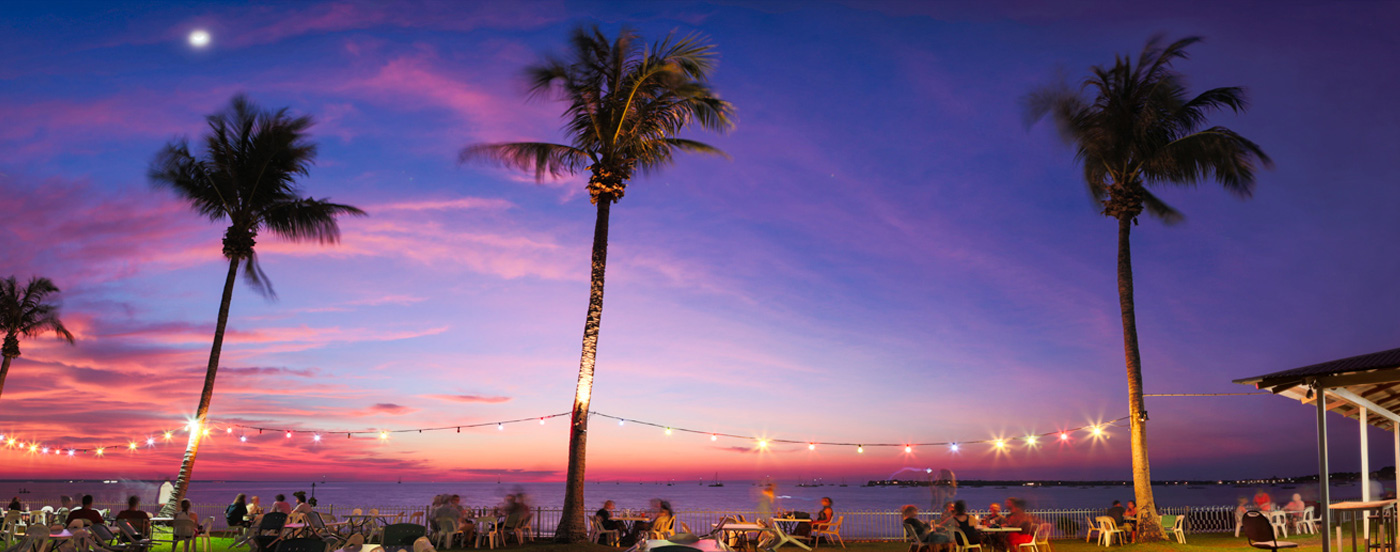
Best time to visit Darwin...
Unlike southern parts of Australia, Darwin and the rest of the Northern Territory’s Top End (including the Kakadu , Arnhem Land and Katherine regions) don’t have the traditional four seasons. Here in the tropical north there are just two main seasons – the wet and the dry – and what you’ll be able to see and do during each season is as markedly different as the climate during each. If you’re thinking about visiting Darwin, we’ve pulled together a guide to help you get a better handle on the best time to head to the Territory’s tropical capital city.
Darwin in the dry
Jun-Aug (most popular)
During the dry season, Darwin is buzzing with the throng of tourists that flock to the Top End when the weather is at it’s coolest and most predictable. Locals and visitors alike make the most of the perfect climate by taking just about every activity they can to the outdoors, including cinemas, concerts, dining and even yoga.
The world-famous Mindil Beach Sunset Markets are open for the dry, and visitors are spoiled for choice with a jam-packed calendar of events setting the town alight, including music and art festivals, sporting competitions, and outdoor food and wine festivals.
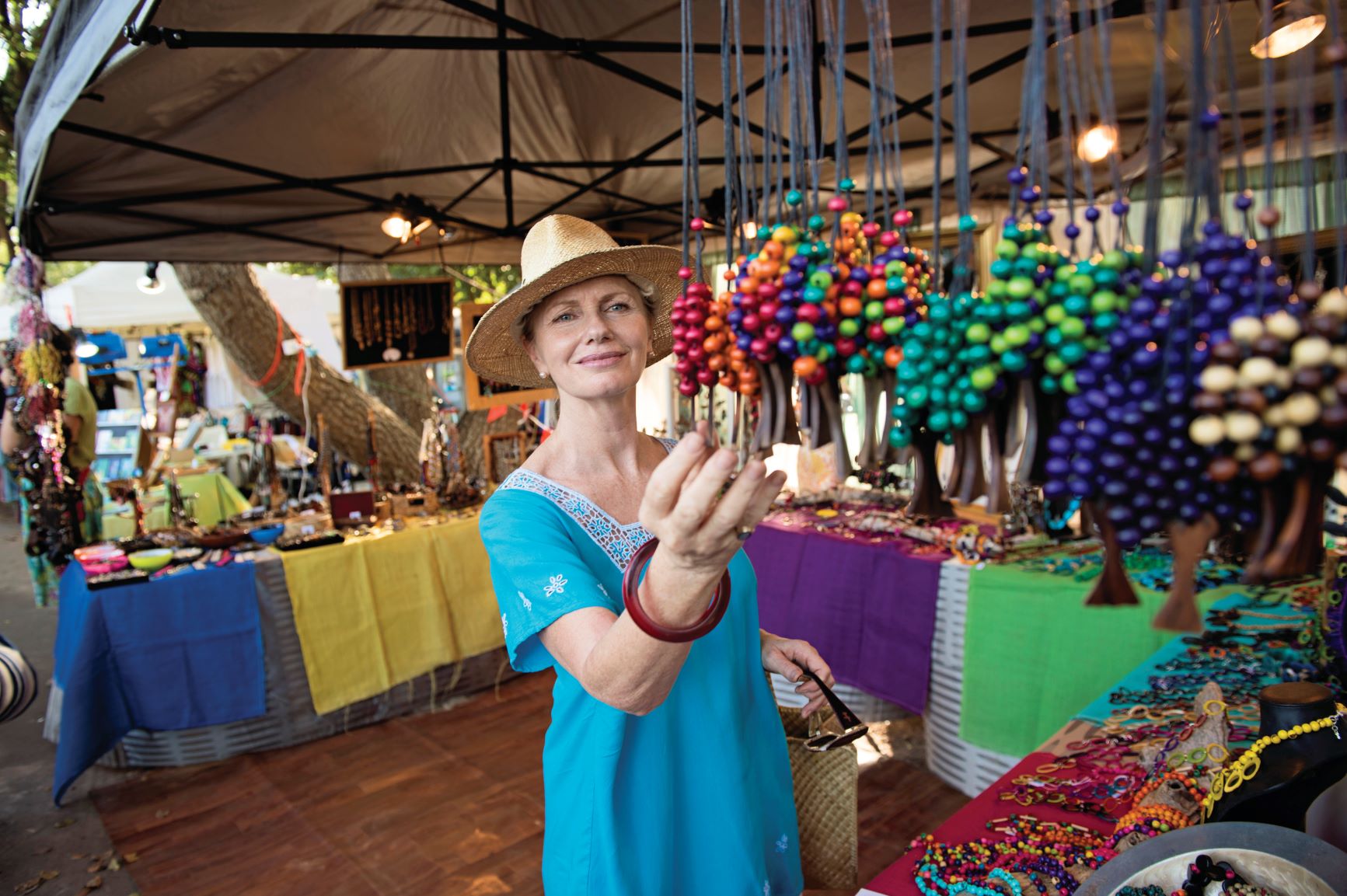
One of Darwin’s most spectacular natural attractions is at its best in the dry season; the fiery sunsets that wash the sky from cotton candy hues of pink, purple and blue to jewel tones of magenta, orange and red.
Because this is the city’s busiest and most popular time, you’ll need to book your accommodation, flights and tours early to beat the crowds, and you’ll be paying top dollar.
Darwin in the wet
Darwin is a totally different place in the wet season; to the introvert’s delight, there are fewer visitors because the weather is hotter, less predictable and more humid. With lower visitor numbers come lower prices and less pressure to book travel in advance, so if your traveller style is more laid-back, this could certainly work for you.
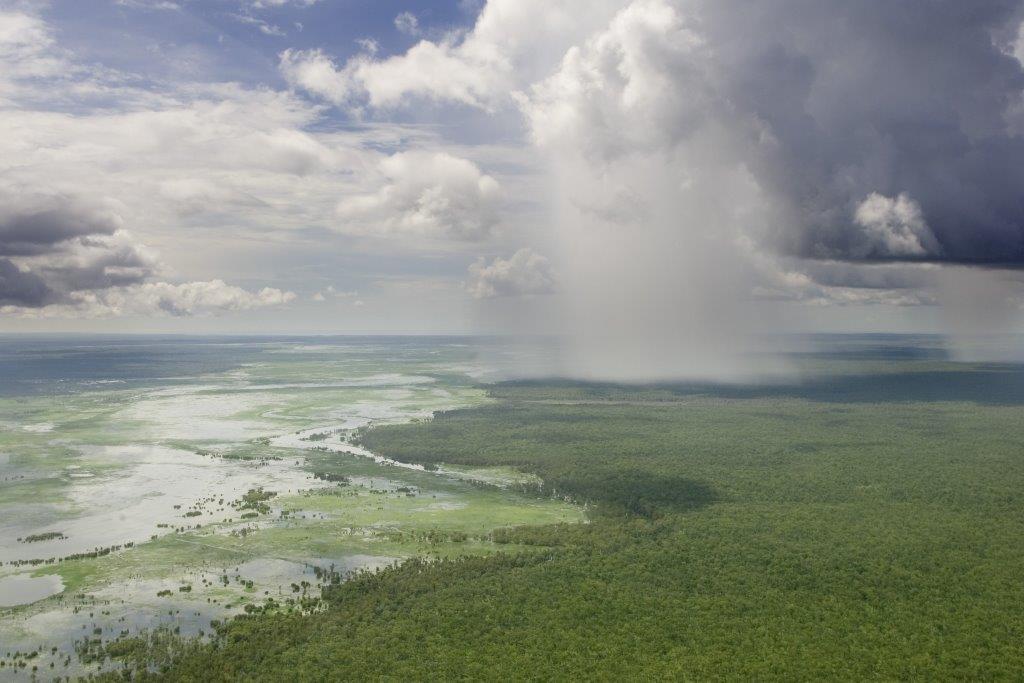
During the wet, people take to the indoors (or at least to their verandas with a cold drink in hand) to watch the electrifying tropical storms roll in across the seaside city’s spectacular harbour. These soaking rains bring with them new life, so expect to see the city’s tropical gardens at their most vibrant.
Shoulder seasons
Apr-May and Sept-Oct
The transitional months between the wet and the dry are referred to as shoulder seasons, with the transition from dry to wet season particularly hot and humid. This particular season is called the ‘build up’ where the humidity escalates to extremely high levels, but relief is some weeks away until the refreshing wet season rains arrive. April-May is not as humid as the build up and a good time to visit to avoid the crowds that come in the peak of the dry season.
If you’ve made your mind up about when you’d like to visit, have a look at our tours departing from Darwin to some of the Top End’s most famous attractions, including Kakadu, Arnhem Land, the Kimberley and Cobourg Peninsula. Watch the video below of you most popular tour, a 5 day tour of the Top End .
© 2014 Venture North | ABN: 34 142 533 113 | Privacy Policy | Terms & Conditions
Tourism Web Design by Dash
Climate and monthly weather forecast Darwin , Australia

The climate of Darwin
The best time to visit darwin, the worst time to visit darwin, spring weather in darwin, summer weather in darwin, autumn weather in darwin, winter weather in darwin, weather in january, weather in february, weather in march, weather in april, weather in may, weather in june, weather in july, weather in august, weather in september, weather in october, weather in november, weather in december, frequently asked questions.
- Average temperature
- Average pressure
- Average wind speed
- Average humidity
- Average rainfall
- Average rainfall days
- Average sea temperature
- Average daylight
- Average sunshine
- Average sunshine days
- Average UV index
- Average cloud cover
- Average visibility
What is the most humid month in Darwin?
What is the wettest month in darwin, how much does it rain in darwin, what is the month with the least sunshine in darwin, when is the lowest uv index in darwin, what is the least humid month in darwin, what is the driest month in darwin, what is the month with the shortest days in darwin, what is the month with the most sunshine in darwin, what are the coldest months in darwin, what month is the sea coldest in darwin, what is the warmest month in darwin, what is the month with the highest uv index in darwin, when is the sea warmest in darwin, when are the longest days in darwin, is there daylight saving time (dst) in darwin, average temperature darwin, australia.
- Average high temperature in January : 30.8°C
- Average high temperature in February : 30.8°C
- Average high temperature in March : 31.2°C
- Average high temperature in April : 31.3°C
- Average high temperature in May : 30.6°C
- Average high temperature in June : 29.5°C
- Average high temperature in July : 29.4°C
- Average high temperature in August : 30.2°C
- Average high temperature in September : 31.7°C
- Average high temperature in October : 32.7°C
- Average high temperature in November : 33.3°C
- Average high temperature in December : 32.5°C
The warmest month (with the highest average high temperature) is November (33.3°C). The month with the lowest average high temperature is July (29.4°C).
- Average low temperature in January : 27.3°C
- Average low temperature in February : 27.1°C
- Average low temperature in March : 26.8°C
- Average low temperature in April : 25.9°C
- Average low temperature in May : 24.2°C
- Average low temperature in June : 22.1°C
- Average low temperature in July : 21.7°C
- Average low temperature in August : 21.8°C
- Average low temperature in September : 24°C
- Average low temperature in October : 26.3°C
- Average low temperature in November : 27.6°C
- Average low temperature in December : 27.8°C
The month with the highest average low temperature is December (27.8°C). The coldest month (with the lowest average low temperature) is July (21.7°C).
Average pressure Darwin, Australia
- Average pressure in January : 1006.3mbar
- Average pressure in February : 1007.2mbar
- Average pressure in March : 1008mbar
- Average pressure in April : 1010mbar
- Average pressure in May : 1011.7mbar
- Average pressure in June : 1013mbar
- Average pressure in July : 1013.2mbar
- Average pressure in August : 1013.2mbar
- Average pressure in September : 1012.2mbar
- Average pressure in October : 1010.8mbar
- Average pressure in November : 1008.8mbar
- Average pressure in December : 1007mbar
The months with the highest atmospheric pressure are July and August (1013.2mbar). The month with the lowest atmospheric pressure is January (1006.3mbar).
Average wind speed Darwin, Australia
- Average wind speed in January : 15.3km/h
- Average wind speed in February : 14.2km/h
- Average wind speed in March : 11.4km/h
- Average wind speed in April : 10.9km/h
- Average wind speed in May : 14.2km/h
- Average wind speed in June : 14.5km/h
- Average wind speed in July : 13.1km/h
- Average wind speed in August : 11.2km/h
- Average wind speed in September : 9.9km/h
- Average wind speed in October : 10.3km/h
- Average wind speed in November : 10km/h
- Average wind speed in December : 11.3km/h
The windiest month (with the highest average wind speed) is January (15.3km/h). The calmest month (with the lowest average wind speed) is September (9.9km/h).
Average humidity Darwin, Australia
- Average humidity in January : 78%
- Average humidity in February : 78%
- Average humidity in March : 76%
- Average humidity in April : 71%
- Average humidity in May : 64%
- Average humidity in June : 57%
- Average humidity in July : 58%
- Average humidity in August : 59%
- Average humidity in September : 64%
- Average humidity in October : 66%
- Average humidity in November : 68%
- Average humidity in December : 72%
The months with the highest relative humidity are January and February (78%). The month with the lowest relative humidity is June (57%).
Average rainfall Darwin, Australia
- Average rainfall in January : 340mm
- Average rainfall in February : 225mm
- Average rainfall in March : 219mm
- Average rainfall in April : 105mm
- Average rainfall in May : 25mm
- Average rainfall in June : 2mm
- Average rainfall in July : 2mm
- Average rainfall in August : 2mm
- Average rainfall in September : 14mm
- Average rainfall in October : 52mm
- Average rainfall in November : 92mm
- Average rainfall in December : 204mm
The wettest month (with the highest rainfall) is January (340mm). The driest months (with the least rainfall) are June , July and August (2mm).
Average rainfall days Darwin, Australia
- Average rainfall days in January : 28.3 days
- Average rainfall days in February : 25.8 days
- Average rainfall days in March : 27.8 days
- Average rainfall days in April : 20.7 days
- Average rainfall days in May : 10.1 days
- Average rainfall days in June : 1.9 days
- Average rainfall days in July : 2.3 days
- Average rainfall days in August : 2.3 days
- Average rainfall days in September : 7.4 days
- Average rainfall days in October : 14.6 days
- Average rainfall days in November : 22.9 days
- Average rainfall days in December : 27.7 days
The month with the highest number of rainy days is January (28.3 days). The month with the least rainy days is June (1.9 days).
Average sea temperature Darwin, Australia
- Average sea temperature in January : 30.7°C
- Average sea temperature in February : 30.2°C
- Average sea temperature in March : 30.3°C
- Average sea temperature in April : 30.3°C
- Average sea temperature in May : 29.1°C
- Average sea temperature in June : 26.8°C
- Average sea temperature in July : 25.8°C
- Average sea temperature in August : 26.4°C
- Average sea temperature in September : 27.8°C
- Average sea temperature in October : 29.6°C
- Average sea temperature in November : 31°C
- Average sea temperature in December : 31.5°C
The best month for swimming (with the highest average sea temperature) is December (31.5°C). The coldest month (with the lowest average sea temperature) is July (25.8°C).
Average daylight / Average sunshine Darwin, Australia
- Average daylight in January : 12h and 5min
- Average daylight in February : 12h and 3min
- Average daylight in March : 12h and 1min
- Average daylight in April : 11h and 5min
- Average daylight in May : 11h and 3min
- Average daylight in June : 11h and 2min
- Average daylight in July : 11h and 3min
- Average daylight in August : 11h and 4min
- Average daylight in September : 12h and 0min
- Average daylight in October : 12h and 2min
- Average daylight in November : 12h and 4min
- Average daylight in December : 12h and 5min
The month with the longest days is December (Average daylight: 12h and 48min). The month with the shortest days is June (Average daylight: 11h and 24min).
- Average sunshine in January : 7h and 3min
- Average sunshine in February : 7h and 5min
- Average sunshine in March : 8h and 2min
- Average sunshine in April : 9h and 0min
- Average sunshine in May : 9h and 4min
- Average sunshine in June : 9h and 5min
- Average sunshine in July : 9h and 5min
- Average sunshine in August : 9h and 5min
- Average sunshine in September : 9h and 5min
- Average sunshine in October : 9h and 4min
- Average sunshine in November : 9h and 2min
- Average sunshine in December : 8h and 2min
The months with the most sunshine are June and August (Average sunshine: 9h and 54min). The month with the least sunshine is January (Average sunshine: 7h and 30min).
Average sunshine days Darwin, Australia
- Average sunshine days in January : 1.4 days
- Average sunshine days in February : 0.9 days
- Average sunshine days in March : 1.8 days
- Average sunshine days in April : 7.2 days
- Average sunshine days in May : 19.2 days
- Average sunshine days in June : 27.4 days
- Average sunshine days in July : 28.4 days
- Average sunshine days in August : 27.9 days
- Average sunshine days in September : 20.3 days
- Average sunshine days in October : 13.3 days
- Average sunshine days in November : 5.5 days
- Average sunshine days in December : 2.3 days
The month with the most sunshine days is July (28.4 days). The month with the least sunshine days is February (0.9 days).
Average UV index Darwin, Australia
- Average UV index in January : 7
- Average UV index in February : 7
- Average UV index in March : 7
- Average UV index in April : 7
- Average UV index in May : 7
- Average UV index in June : 7
- Average UV index in July : 7
- Average UV index in August : 7
- Average UV index in September : 7
- Average UV index in October : 7
- Average UV index in November : 8
- Average UV index in December : 7
The month with the highest UV index is November (UV index 8). The months with the lowest UV index are January , February , March , April , May , June , July , August , September , October and December (UV index 7).
Average cloud cover Darwin, Australia
- Average cloud cover in January : 47
- Average cloud cover in February : 42
- Average cloud cover in March : 36
- Average cloud cover in April : 29
- Average cloud cover in May : 20
- Average cloud cover in June : 11
- Average cloud cover in July : 11
- Average cloud cover in August : 9
- Average cloud cover in September : 13
- Average cloud cover in October : 19
- Average cloud cover in November : 26
- Average cloud cover in December : 37
The month with the most cloud cover is January (Cloud cover 47). The month with the least cloud cover is August (Cloud cover 9).
Average visibility Darwin, Australia
- Average visibility in January : 9km
- Average visibility in February : 9km
- Average visibility in March : 9km
- Average visibility in April : 10km
- Average visibility in May : 10km
- Average visibility in June : 10km
- Average visibility in July : 10km
- Average visibility in August : 10km
- Average visibility in September : 10km
- Average visibility in October : 10km
- Average visibility in November : 10km
- Average visibility in December : 9km
The months with the highest visibility are April , May , June , July , August , September , October and November (10km). The months with the lowest visibility are January , February , March and December (9km).
Darwin, Australia
Weather forecast for your location.

Best Time to go to Darwin
The best time to go to Darwin is typically during the dry season, from May to October. During this time, the days are warm and dry, with little to no rainfall and lower humidity than during summer. This time of year also compares favorably with southern Australia, which is in the grips of winter and is typically cold and often wet. The dry season months are also when some of the best events are held in Darwin, including the popular Darwin Fringe Festival and horse racing Darwin Cup. However, there are plenty of reasons to go to Darwin throughout the year, and we’ll look at all of these in this article.
Where is Darwin?
Darwin is located in the far north of Australia in the Northern Territory. Darwin is Australia’s most northern city, a state capital, and one of the most isolated cities. In fact, Darwin is closer to Timor-Leste and Indonesia than it is to the nearest Australian city. It’s situated between the Tropic of Capricorn and the Equator, enjoying a tropical climate throughout the year.
Best Time to go to Darwin for Good Weather
Darwin’s location in the Tropics means it enjoys a warm year-round climate. Rather than four seasons, the year is divided into a wet and dry season, which both run for an equal period. The wet season runs over the Australian summer, starts in November, and runs through April. The dry season runs over the Australian winter from May through October. So unless you’re a big fan of rainfall, heat, and high humidity, the best time to go to Darwin for weather is during the dry season. The following table demonstrates the stark difference between the wet and dry seasons.
Best Time to Visit Darwin for Events and Festivals
Often, coverage of when to visit a destination can be too focused on the weather and doesn’t consider what events are going on in and around a destination. If you time your trip right, being in a place for one of their big events or festivals can make a good trip a great trip. To help you decide on the best time to go to Darwin, we’ve included some of the biggest and best events in Darwin’s social and cultural calendar.
Australia Day – This annual holiday on 26th January is often celebrated with street parties. On the esplanade, there’s a military flyby and 21-gun salute. There’s also free access to various public facilities on the day, including pools.
Territory Day – Held on the 1st of July each year, this is often a raucous occasion to celebrate the Northern Territory achieving self-government in 1978. There are various events throughout Darwin and the Northern Territory, with fireworks on Mindil Beach providing a spectacular end to the day.

Mindil Beach Sunset Markets – Operating every Thursday and Sunday through the dry season, this is a great place to shop, eat, and see entertainment. There’s something here for all the family and a stunning sunset always accompanies it.
Darwin Fringe Festival – An annual event that runs for 10 days each July, it celebrates the rich arts and cultural scene of the North Territory. It features an eclectic set of performers that range from comedians to cabaret and from circus performers to magicians. This is a really magical time to visit the city.
Darwin Cup Festival – The Darwin Cup Festival is a series of racing meets that take place through July and August, culminating in the Darwin Cup race. The 8 race meetings that make up the festival are popular affairs with plenty of parties and entertainment included. Plus, of course, lots of high-quality racing.
With the Darwin Fringe Festival, Darwin Cup Festival, and Mindil Beach Sunset Markets all on during July, you can’t go wrong with a visit at this time. While it’s peak season and costs will undoubtedly be slightly higher, we think the cost is more than justified given the wealth of attractions available at this time.

Best Time to Visit Darwin for Kakudu National Park
Kakadu and nearby Litchfield National Park are two of the most popular reasons to visit Darwin and the Northern Territory. These two vast parks offer many amazing experiences, landscapes, and wildlife encounters. Choosing when to visit them isn’t as straightforward as just picking the time with the best weather, as there are pros and cons for both the dry season and the wet season. The final decision will come down to your preferences: what you want to see, what you want to do, and whether you’re prepared to deal with crowds or the rain.
Conventional wisdom tells you to visit Kakadu during the dry season from May through October. There will be little to no rainfall, warm and pleasant days, fewer bugs, and you can swim in some pools and at waterfalls. It all sounds very idyllic. However, on the flip side, the parks are exceptionally busy and, at some points, very crowded. You’ll also find that the landscape isn’t as spectacular later in the season, with the lush green colors fading and waterfalls slowing to a trickle.
The wet season, on the other hand, is a completely different experience. The parks are lush and green with thunderous waterfalls and few other tourists. However, such perfection comes at a cost in terms of rain, humidity, and bugs. A lot of bugs. There are also some issues with access after particularly heavy rainfall. If that doesn’t put you off, consider visiting in the wet season, as you’ll also benefit from a lower price for any tours and accommodation you book.
Our dedicated blog post has a more in-depth look at the best time to visit Kakadu .

Best Time to Visit Darwin for Cheap Flights and Accommodation
Darwin’s peak season coincides with the dry season and includes the Christmas School Holidays across December and January. Therefore, the cheapest times to visit are typically from February to early May and from September to November. Although these periods include the months of May, September, and October, which all fall into the dry season, these shoulder months are still significantly cheaper than the peak months of June, July, and August.
Related Content

Best Time to Visit Uluru

Best Time to go to Broome


Best Time to go to Cape York

Brisbane to Byron Bay Road Trip

Best Time to Visit Margaret River

Cairns to Cape Tribulation

Can you Drive to Australia?
Latest blog posts, can you drive to morocco.
You can drive to Morocco from the neighboring countries of Spain and Mauritania, but not Algeria, despite a nearly 2000 km long border between the two countries. Travel between Morocco and any of its neighbors comes with its fair share of challenges. At first glance, you could be mistaken for
10 Best National Parks in Western Australia
If you love solitude, amazing landscapes, and vast open spaces, you’re going to love Western Australia. This amazing land, and the northwest in particular, is often referred to as the ‘Last Frontier’. It’s a land of endless remote possibilities and nowhere showcases this better than the amazing array of national
17 Best Things to do in Vlore
The Albanian port city of Vlore is one of Albania’s spectacular coastal highlights. Situated at the northern end of the Albanian Riviera and overlooking the beautiful Bay of Vlore, the city is blessed with a wealth of attractions. The home of Albanian independence and the gateway to the Riviera, the
Can you Drive to Tuktoyaktuk?
You can drive to remote Tuktoyaktuk on the Arctic Ocean using the Inuvik-Tuktoyaktuk Highway, also known as the “Mackenzie Highway” or “Tuk Highway.” The road provides access to Tuktoyaktuk from Inuvik in the Northwest Territories. Inuvik is accessible from mainland Canada by using the Dempster Highway, which runs all the
Can you Drive to Gasparilla Island?
It’s possible to drive to beautiful Gasparilla Island from the nearby Florida mainland using a bridge known as the Boca Grande Causeway. The causeway connects the unincorporated community of Placida on the mainland to the northern tip of Gasparilla Island, allowing vehicles to access the island. There’s a $6 round
Weather & Climate
Top Destinations in the Northern Territory
Where to Stay
Top Things to Do in the Northern Territory
Things to Do in Darwin
Things to Do in Alice Springs
Things to Do at Uluru
Guide Kakadu National Park
Best Parks to Visit
Must-Try Food
Best Time to Visit
The Best Time to Visit the Northern Territory
:max_bytes(150000):strip_icc():format(webp)/IMG_2751-c8e99122470c4e26861511881ad3a6cd.jpg)
Posnov / Getty Images
Australia's outback paradise, the Northern Territory, is divided into two regions with distinct climates: The Red Centre in the heart of Australia and the Top End on the Timor Sea in the north. The best time to visit the Red Centre is in the transition seasons of fall (March to May) and spring (September to November) which offer pleasant weather and low crowd levels. The days are sunny and warm, perfect for sightseeing, while the nights are crisp and clear. The Top End is at its coolest and most accessible during the dry season from May to July. Visit in May or early June to avoid the crowds. If you want to visit both regions, the best time to visit the Northern Territory is from May to October, thanks to the lower humidity levels and the ability to access most parts of this incredible destination without the risk of flooding.
The biggest town in the Red Centre is Alice Springs, which experiences clear skies, low rainfall, and hot temperatures throughout most of the year. Further north, the capital city of Darwin has a wet season from November to April and a dry season from May to October. Read on for our full guide to the weather, events, and attractions of the Northern Territory .
Dangerous box jellyfish can be seen off the coast from October to May, so make sure to obey any warning signs at beaches during this time. Saltwater crocodiles also pose a threat in waterways in the Top End, so do your research before swimming.
Popular Events and Festivals
Most of the Northern Territory's big events take place in the dry season—especially the cooler months of June, July, and August—and range from internationally renowned arts festivals to quirky outback races. Accommodation for these events can book out months in advance, especially for the ones held in small communities, so we recommend planning ahead.
The Northern Territory also observes Australia's national public holidays including Australia Day (Jan. 26), Easter (mid-March or April), Anzac Day (April 25), May Day (May 1), Queen's Birthday (mid-June), Christmas, Boxing Day (Dec. 26), and New Year's Day.
The Ghan Railway (a luxury train between Adelaide, Alice Springs, and Darwin) has departures once a week from November to March, and twice a week from April to October.
The Weather in the Northern Territory
Daytime temperatures in the Northern Territory are generally on the higher side, although winter brings cold nights to the Red Centre. Average maximums hover around 90 F (32 C) in Darwin throughout the year, while Alice Springs has a larger range of fluctuation, from around 65 F (18 C) in winter to around 95 F (35 C) in summer.
The wet season can result in flooding and road closures in the Top End, making it a tricky time for tourists. It is also the time of the year with the highest humidity levels.
Peak Season in the Northern Territory
The whole Northern Territory experiences a boom in tourism in winter, as travelers make the most of the milder temperatures and the Australian school holidays. From late June to late July, popular destinations like Uluru and Kakadu can be crowded at these times, but there is still plenty of space to get away from it all.
Summer (December to February)
Summer is hot all over the Northern Territory, and hot and wet in the Top End. Some visitors to the Top End may enjoy the sunny mornings and the lack of fellow travelers, along with the incredible flowing waterfalls and vivid green foliage in the region's national parks. However, most will find that the monsoon rains and the humidity put a damper on their travel plans.
Average summer temperatures range from 75 to 90 F (24 to 32 C) in the Top End, with humidity over 80 percent. January is the wettest time, with around 17 inches of rainfall across 21 days out of the month. From October to December, dramatic storms hit the north coast.
Further south, in the Red Centre, summer temperatures range from 60 to 95 F (15 to 35 C) and the sun can be a little harsh for outdoor activities, while nights sometimes dip down to 35 F (2 C). Events are often held in the evenings to avoid the heat of the day.
Events to check out:
- Alice Springs Town Council Night Markets : This market is held in the Todd Mall on Thursday evenings from 5 p.m. once a month, with live entertainment, snacks, Aboriginal art, second-hand books, and boutique clothing and jewelry.
- Parap Village Markets : In Darwin, this event runs every Saturday morning year-round, with local food, fresh produce, clothing, jewelry, art, plants, and live music.
Fall (March to May)
The weather cools off a little in most of the Territory from March to May, although regular rain and high humidity continue in the Top End until the end of April. Average temperatures range from 50 to 80 F (10 to 27 C) in Alice Springs and highs drop down to the 70s and 80s in Darwin by May.
It is a great time to visit Alice Springs before the crowds arrive in June, and prices for accommodation and tours may be lower in Darwin through the tail end of the wet season.
- Alice Springs Cup Day: The biggest thoroughbred race day of the year happens in early May, with fashion and entertainment.
- Tiwi Islands Grand Final and Art Sale: On Bathurst Island, north of Darwin, the two local passions of art and football collide for one day in March, drawing visitors from all over Australia.
- Bass In The Grass : An all-ages music festival in Darwin since 2003 with international headliners.
Winter (June to August)
Winter is peak season across the Territory, as domestic and international travelers make the most of the cooler temperatures in Alice and clear skies in Darwin. Average temperatures in Alice Springs range from 40 to 65 F (4 to 18 C), with the occasional morning frost. In Darwin, the cool weather continues until July, with temperatures in the 60s and 70s. The dry season runs through winter.
Prices and crowds are higher across the board, but visitors will be rewarded with access to many parts of the Top End that are cut off during the wet season.
- Barunga Festival : This festival first took place in the remote Aboriginal community of Barunga (near Katherine) in 1985, and has grown into a three-day program of music, sport, traditional arts, and cultural activities open to visitors.
- Darwin Festival : With music, art, dance, and storytelling, this festival celebrates all the cultures of the Northern Territory.
- Finke Desert Race : A famous off-road two-day race for bikes, cars, buggies, and quads from Alice Springs.
- Run Larapinta : A four-day trail running race through some of Australia's most iconic landscapes near Alice Springs.
- Beer Can Regatta : A local favorite in Darwin since 1974, all are welcome to make a small boat out of cans, plastic bottles, or milk bottles and race them along the waterfront.
- Uluru Camel Cup : Two days of camel racing, Fashions on the Field, and an Outback Ball await at the Uluru Camel Cup.
Spring (September to November)
Days start to get warmer in the Red Centre—averaging around 55 to 85 F (13 to 29 C) in Alice Springs—bringing the occasional afternoon thunderstorm. If you're planning on getting outdoors in Central Australia, the spring weather is sunny but not too hot for hiking.
Up in the Top End, it's a different story. The two months preceding the start of the wet season at the end of November are known to Darwin locals as the build-up, as temperatures increase slowly but steadily until the rains roll in. Most attractions are still accessible, but the rising humidity can be uncomfortable for some.
- Parrtjima : A free light festival in Alice Springs in September, featuring Aboriginal artists.
- Desert Song Festival : 10 days of concerts and workshops that draw on the Aboriginal, African, classical, and Caribbean musical transitions of Central Australia.
- Darwin International Film Festival : An extensive calendar of events in September with a focus on local filmmakers and independent international cinema.
The Northern Territory can get extremely hot in the summer, so the best time to visit is between May and October when humidity and temperatures are low.
Uluru is the most famous attraction in the Northern Territory and the best time to visit is between May and September when the weather is cool and dry. However, you will find the most crowds between June and September, which makes May the optimum month to visit.
The wet season lasts from November to April, during which the region can experience monsoons and high levels of humidity.
Tourism Australia. "Weather in Alice Springs." Retrieved Feb. 8, 2021.
Tourism Australia. "Weather in Darwin." Retrieved Feb. 8, 2021.
Weather in the Northern Territory: Climate, Seasons, and Monthly Temperature
The Top 11 Destinations in Australia's Northern Territory
The Best Time to Visit the Great Barrier Reef
The Best Time to Visit Johannesburg
The Best Time to Visit the Maldives
Your Trip to Australia's Northern Territory
15 Top Things to Do in the Northern Territory
The Best Time to Visit the Dominican Republic
The Best Time to Visit the U.S. Virgin Islands
The Best Time to Visit Australia
The Best Time to Visit Cape Town
The Best Time to Visit the Galapagos Islands
Where to Stay in the Northern Territory
The 14 Best Parks to Visit in Australia's Northern Territory
5 Tropical Islands Americans Can Visit Without a Passport
July in Australia: Weather, What to Pack, and What to See
A first-timer’s guide to Darwin: Australia's tropical capital
Book your individual trip , stress-free with local travel experts
- roughguides.com
- a-first-timers-guide-to-darwin-australia
written by Shafik Meghji
updated 21.06.2019
Tucked away in the “Top End”, closer to Indonesia than Sydney, Darwin is the least known of Australia ’s regional capitals – stunningly remote, buffeted by extreme weather, and with an atmosphere like nowhere else in the country.
The gateway to Asia
Aboriginal culture, out on the town, bushwalking in litchfield, historic darwin, echoes of wwii, top end crocs.
Here’s our guide to Darwin – and what to expect on your first visit to this fast-growing, youthful, multicultural city.
Tailor-made travel itineraries for Australia, created by local experts

12 days / from 2900 USD
Explore Western Australia from Perth to Broome
Western Australia is the country's largest state, covering more than a third of Australia. This self drive itinerary allows you to explore sunny Perth, stunning national parks and waterfalls, the remote wild west outback, empty beaches and much more.
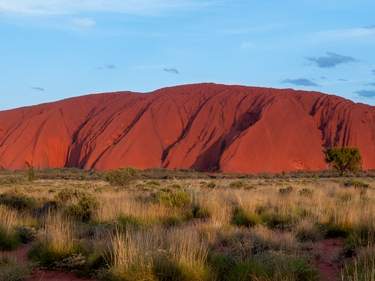
16 days / from 3300 USD
Explore South Australia and the Northern Territory
Explore South Australia and the Northern Territory on this self-drive adventure. Start in Adelaide and make your way over the Ayers Rock, Kings Canyon, and Alice Springs to the Kakadu National Park and ultimately Darwin.

23 days / from 4150 USD
Cross Western Australia to Darwin
Western Australia offers wonderfully remote outback experiences: from spectacular national parks to sandy deserts, pristine beaches to working cattle stations. This itinerary allows you to explore the way from Perth to Darwin in depth and at your own pace, in your own rental car.
Tailor-made trips for Australia
Thanks to its proximity to the continent, Darwin is known as “Australia’s gateway to Asia”, home to over 60 different nationalities out of a population of just 135,000.
Southeast Asian communities have a particularly strong presence, which is most notable in the city’s cuisine. In fact, laksa – a spicy, creamy noodle soup found across Southeast Asia – has arguably become Darwin’s favourite dish.
The best places to sample city’s culinary diversity are the Parap Village and Mindil Beach Sunset markets, where you can find everything from authentic Vietnamese pho to crocodile tail sushi.

Laksa © TonyNg/Shutterstock
More than 25% of the people in the Northern Territory are from aboriginal communities, a higher proportion than anywhere else in Australia. Some 80km off the coast of Darwin and connected by ferry services are Bathurst and Melville, jointly known as the Tiwi Islands.
The Tiwi people had only limited contact with mainland aboriginal societies until the nineteenth century, so they developed their own distinct language and culture.
You can visit the Tiwi Islands on a day trip from Darwin, but if you have more time available, travel 150km east of the city to Kakadu National Park . As well as a profusion of wildlife, the reserve has some eye-catching examples of ancient aboriginal rock art, some of it over 20,000 years old.

© EcoPrint/Shutterstock
Darwin’s nightlife is famously lively, and is at its most raucous in the pubs, bars and clubs strung along Mitchell Street in the city centre. For something a bit classier, head to The Pearl, a hip bistro tucked away off the pedestrianized Smith Street Mall with a great cocktail list – try the espresso martini.
Stokes Hill Wharf, which has undergone a major revamp, is another popular drinking spot, with an array of restaurants and bars overlooking a croc- and jellyfish-free lagoon and beach. And at sunset, the beachside Darwin Ski Club, north of the city centre, is hard to beat.

© RockyPlanetPhotography/Shutterstock
Located 100km south of Darwin and easily accessible as a daytrip – or better still an overnight stay – Litchfield National Park is a great place for a spot of bushwalking. The reserve is home to a series of dramatic waterfalls, innumerable giant termite mounds, and plenty of swimming holes to cool off in – though you should only swim in designated areas and steer well clear of any with crocodile warning signs.
Litchfield is also rich in birdlife: keep an eye out for spangled drongos, rainbow bee-eaters, and yellow orioles.

© Travelling.About/Shutterstock
Related articles from the blog

The capital of the Northern Territory has taken a bit of battering since it was founded in 1869: first by the Japanese air force during the Second World War and later by Cyclone Tracy, which devastated Darwin in 1974. Add in some ferocious termites and it’s easy to understand why Darwin today has modern look.
But some historic gems have survived in the city centre, if you know where to look. The highlight is Government House, a huge gothic pile surrounded by manicured gardens.
Also keep an eye out for the ruined Palmerston Town Hall, which is now used for open-air theatre performances, and Lyons Cottage, which was the first stone house in the city when it was built in 1925.

© Mixedbag Images/Shutterstock
Darwin played a prominent role in WWII, when frequent Japanese bombing raids gave rise to the nickname “Australia’s Pearl Harbour”. An invasion was an ever-present threat, which prompted the construction of Stuart Highway, the first reliable road link between the city and the rest of Australia.
Based in a former wartime command post, the Darwin Military Museum brings this period to life through its immersive, multimedia Defence of Darwin exhibition.

© EA Given/Shutterstock
There are almost as many saltwater crocodiles as people in the Top End, and the region was home to Rod Ansell, the man who inspired Crocodile Dundee . At Darwin’s Crocosaurus Cove you can view, feed or even be lowered in clear plastic containers into the enclosures of these giant reptiles, many of which grow to over six metres in length.
If you prefer to see them in the wild, however, visit the nearby Adelaide River, where several agencies offer “jumping croc” cruises during which the “salties” leap out of the water to snap at morsels dangled from gingerly-held fishing rods.

© SherSS/Shutterstock
Shafik Meghji co-authors The Rough Guide to Australia . He blogs at unmappedroutes.com and tweets @ShafikMeghji.
Top image © frenchiestravel/Shutterstock

Shafik is an award-winning travel writer, journalist and co-author of more than 40 Rough Guides to destinations across Latin America, Asia, Oceania, Europe and North Africa. A regular contributor to the Rough Guide to Everywhere podcast, he writes and takes photos for BBC Travel, Wanderlust and Atlas Obscura, among others. His new book, Crossed Off The Map: Travels in Bolivia, will be published in late 2021. Follow him @shafikmeghji on Twitter and Instagram .
- See & Do
Planning your own trip? Prepare for your trip
Use Rough Guides' trusted partners for great rates
Travel advice for Australia
From travel safety to visa requirements, discover the best tips for traveling to Australia
- Eating and drinking in Australia
- Getting around Australia: Transportation Tips
- Travel Health Australia
- Sports and Outdoor activities in Australia
- How to get to Australia
- Travel Tips Australia for planning and on the go
- Travelling with children in Australia
- Best time to visit Australia
Find even more inspiration for 77 here
Ready to travel and discover australia, get support from our local experts for stress-free planning & worry-free travels.
- Where to stay
- Itineraries
- Travel advice
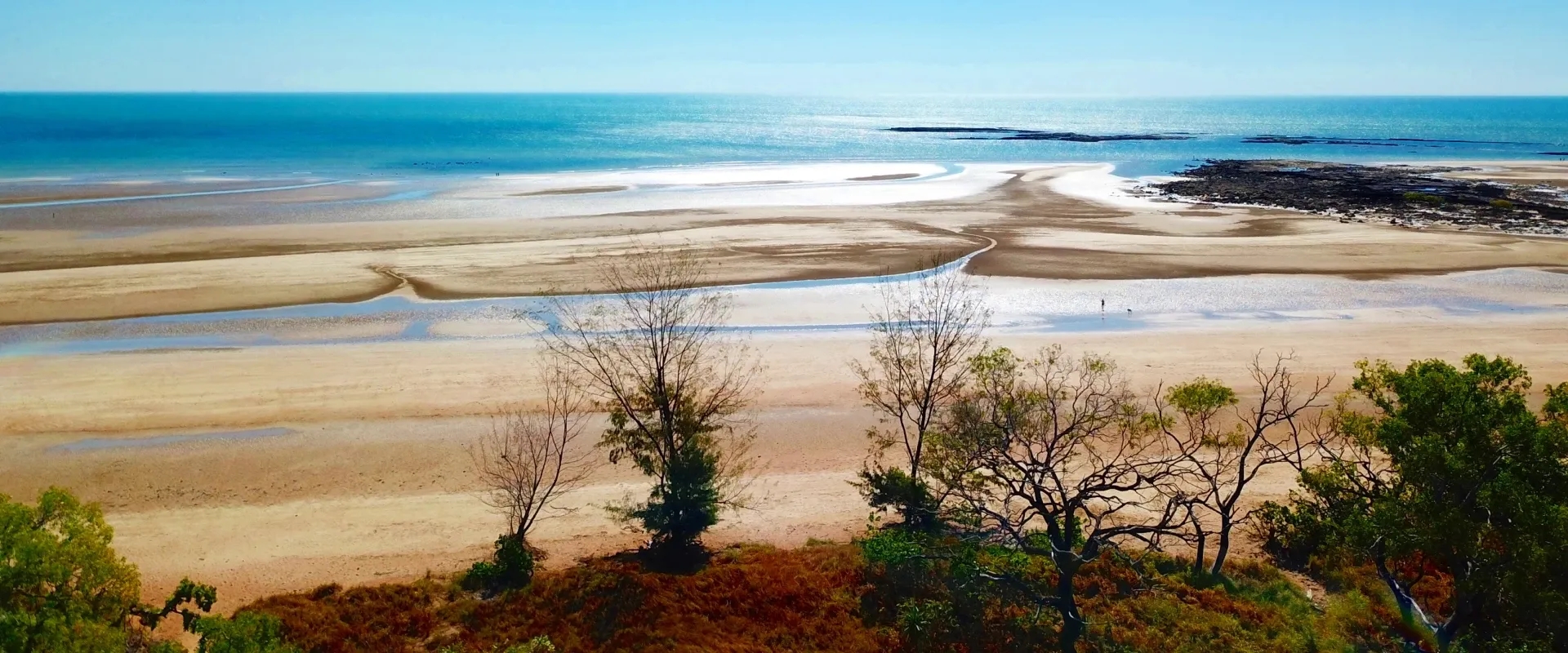
Darwin: The Aussie Capital That’s As Hot as It Is “Cool”
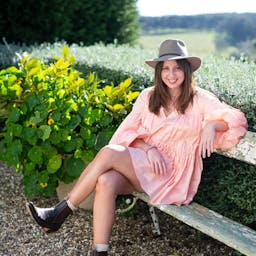
Alley Pascoe
January 9, 2024
There’s a reason they call this place the Top End. For one, Darwin is the northernmost capital city in Australia. And, also, it’s tops. Sitting at the tip of the country in the Northern Territory, the city has a real sense of being the last frontier. It’s a place of extremes: Darwin is the smallest, wettest, and hottest Australian capital. It’s as brutal as it is beautiful.
In October, the build up to the wet season starts and the humidity rises to unbearably sticky levels. Clouds loom, but the relief of rain is elusive. It teases us. That’s when something called “Mango Madness” sets in. Locals say the only known cure is a cold beer and a hot laksa. Luckily, Darwin has plenty of both on offer. Saddle up and come along for the ride.
60,000+ years of continuous culture

Australia’s First Nation community is made up of over 250 language groups. Together, they are one of the world’s oldest living cultures , with more than 60,000 years of rich history and knowledge.
The Larrakia —who refer to themselves as the Saltwater People due to their spiritual connection to the coastal land and sea—are one such group within the First Nation community and are the traditional owners of the Darwin area, which in total has a population of roughly 140,000. The Saltwater People call the city “Garramilla,” which means “white stone,” in a nod to the chalk-colored rock and cliffs of the harbor.
Larrakia culture is everywhere in Darwin. It’s off Casuarina Beach at low tide when you can see Nungalinya (Old Man Rock), which the Larrakia people consider to be their ancestral elder. It’s in the mural on Bennett Street in the Central Business District, which was painted by senior Larrakia artist Denise Quall, welcoming visitors to her Mother’s Country with family totems. And it’s in the kangaroo tail, a delicacy eaten by Aboriginal people for millennia, that’s for sale at the local supermarket ready for a feast.
That’s the spirit
There’s a festival for everyone in Darwin. From May to October, the city makes the most of the perfect weather in the dry season and puts on a show. The Darwin Fringe Festival in July champions emerging artists, with 300 performers putting on 100 shows. The Darwin Aboriginal Art Fair in August is a celebration of First Nations creativity and talent. And the Darwin Street Art Festival , which takes place in August and September, is behind the impressive street art scene in Darwin, with murals on every major street in the city.
Also in August, the beloved Darwin Festival unleashes a flurry of music, theatre, dance, cabaret, and comedy gigs. The festival was initially founded to bring people together in the wake of Cyclone Tracy back in 1974, and it has grown every year since. Now, it’s internationally renowned as one of Australia’s best arts events, and in 2023, it welcomed 160,000 visitors from across Australia and beyond.
A gallery a day
The art scene in Darwin is a real mix of old and new. The region is home to many acclaimed artists and established art centers, as well as some exciting fresh talent.
Laundry Gallery , for one, ain’t your grandmother’s gallery. Opened in late 2022, it’s introducing Aboriginal art to a younger, cooler crowd, thanks to owners Nina Fitzgerald and Laura Shellie. Located in a retro ‘70s laundromat in a trendy corner of Parap on the northern outskirts of the city, the gallery’s tagline is, “Old stories, new spin.” Each month, the multi-disciplinary arts hub showcases a new collection of Blak excellence , from hand-carved and painted spears to woven bags made from ghost nets (discarded fishing nets found on the coast) and bright prints of troopies (Toyota Land Cruiser vehicles).
Along with the new kids on the block, Darwin is also home to some classic galleries, including the Museum and Gallery of the Northern Territory (MAGNT). Each year, the cultural institution houses the finalists and winners of the National Aboriginal and Torres Strait Islander Art Awards (NATSIAAs) in an exhibition not to be missed. The Northern Centre for Contemporary Art in Parap and Paul Johnstone Gallery in the city are also worth a visit.
Would you like chili with that?

Laksa—the spicy coconut noodle soup—may have originated in Southeast Asia, but it has found a thriving home in Darwin. Every local has a hot take on the best laksa in town; favorites include the legendary Mary’s Laksa at the Parap Village Markets, the local’s secret takeaway shop at Hibiscus Shopping Centre in suburban Leanyer, and the award-winning Chok’s Place on Smith Street in the city center. Regardless of where the laksa is from, you can spot a Darwin local by how much chili (spelled chilli in Australia) they ask for—the spicier the better in these parts.
Darwinians love laksa so much, they have a month-long festival dedicated to the dish. Fittingly named, the Darwin Laksa Festival is held annually in October and includes food tours, eating competitions, and an awards ceremony where the “People’s Choice” and “Golden Bowl” (judged by an expert panel to be the best laksa of the year) winners are crowned. During the festival, local eateries serve up laksa-inspired dishes, such as the (questionable) laksagna, the (unfortunate) laksa panna cotta, and the (surprisingly refreshing) laksa spritz.
If a laksa smoothie bowl (featuring tropical fruits, creamy coconut, and a spicy kick) doesn’t tickle your fancy, you can’t go wrong with a classic bowl of laksa from one of the many market stalls at Parap, Nightcliff, and Mindil Beach open every weekend.
After a while crocodile

It doesn’t get more “Darwin” than a tinnie (small boat) on the Adelaide River surrounded by crocodiles. You’d be forgiven for thinking this is a sleep-paralysis nightmare, but it actually happens to be the very best activity to do in Darwin.
There are several local tour operators on the Adelaide River who run jumping croc tours, including the Spectacular Jumping Crocodile Cruise , which is owned and operated by the Arirrki Aboriginal Corporation. These tours are as advertised: boat tours featuring crocs who jump for chicken carcasses and your terrifying delight.
Note that the operator of the Spectacular Jumping Crocodile Cruise ensures that the crocodiles' welfare is of the utmost importance. The company has developed an Animal Welfare Policy—approved by NT Parks & Wildlife and endorsed by animal behavior experts—to ensure each crocodile is not overfed, overworked, and remains wild. Read more about their policy here . As with any animal encounter experience, it's important to do your research to ensure that the company that you are supporting is doing right by the animals and their natural surroundings.
The Adelaide River, just 37 miles south of Darwin, is home to more than 1,600 saltwater crocodiles. Seeing the prehistoric predators up close will give you a newfound respect for them—and maybe a healthy dose of fear. Keep an eye out for Dominator, who measures 19.7 feet in length and is reportedly the second-largest crocodile ever measured. And whatever you do, please keep your arms inside the vessel (for obvious reasons).
In the market
Visitors to Darwin are spoiled for choice when it comes to markets. During the dry season, from May to October, the Mindil Beach Sunset Market is the place to be every Thursday and Sunday night. Held at the coastal reserve that runs along the beach, the market features live performers (including whip cracking), food stalls (à la Paella at Sunset, the Honey Puff King, and Fire Bowl), and classic souvenirs like Slappa’s Thongs (which aren’t underwear) and Bogan Biltong (which isn’t jerky).
Elsewhere in Darwin, the Parap Village Markets are held every Saturday morning for your laksa fix. Rapid Creek Markets are on Saturdays and Sundays, selling the freshest fruit and veg in the city, as well as the best paw-paw salad (a zingy dish made with green papaya-like fruit and as many chilis as you can handle). And Nightcliff Markets happen Sunday mornings for smoothies, homemade spring rolls, and cool cotton skirts and shirts.
When the sun goes down

Darwin sunsets are legendary for the rich reds, oranges, pinks, and purples that light up the sky and bask the town in a golden glow. Thanks to the west-facing coastline, catching a mesmerizing sunset at golden hour is as simple as heading to the coast and looking up.
Ask anyone, and they’ll tell you nothing beats watching the sun dip below the horizon at Nightcliff Beach. Or Dripstone Cliffs on Casuarina Beach. Actually, maybe the ultimate spot is the Darwin Ski Club on Bundilla Beach at Fannie Bay. Better yet, jump on a yacht at Cullen Bay, and head out onto the harbor for a sunset cruise. This can be a bougie or budget experience. The crew at City of Darwin Cruises offers a 2.5-hour sailing package with drinks and nibbles starting at $99 AUD per person, but you could also privately charter a vessel for you and 20 of your mates for $1,400 AUD.
Whether you’re on the water or land, admiring the sunset is a well-respected pastime in the city. It’s common for locals to knock off work and head to the closest beach with a picnic blanket, bottle of wine, and cheese board. While there’s a healthy debate surrounding the most scenic sunset-watching site, there is one thing all Darwin locals agree on: No one should clap in the peaceful moment when the sun finally sets. Just don’t be that person.
What happens on Mitchell Street…
Back in the day, Monsoons nightclub on Mitchell Street was known for its ladies’ night, the Wild Wednesdays mechanical bull–riding competition, and grandma bingo. It still is. The nightlife in Darwin is as untamed as its weather. The main strip of Mitchell Street can be fierce and sometimes feral.
But a new generation of cool and classy watering holes are shaking up the bar scene and offering an alternative to the classic Aussie pub. There’s the chic wine bar Stone House , serving seasonal cheese boards and a delightful Shiraz from the Barossa Valley, which sits on the opposite end of the country in South Australia. Around the corner in the Air Raid Arcade is Babylon , a small and quirky cocktail bar fit for Insta-selfies. And on the cusp of the city is Trader Bar , known for its spicy margaritas and Euro-holiday vibes.
In the Top End, locals drink Black Fish (aka Great Northern Super Crisp beer), but they’ll toast to anything. Here’s to sunsets, storms, and spicy bowls of laksa. Cheers, mate.
Good to know
Is darwin expensive .
Darwin can be done on a tight budget thanks to the cheap eats at the markets and affordable accommodation options. City hotels like H on Smith have rooms starting from $114 AUD a night. Resort suites at the luxe Mindil Beach Casino Resort start at $173 AUD. A bowl of laksa will set you back $12 AUD from the markets, and a main meal at a restaurant will run $20–$30 AUD. A daily bus pass is $7 AUD, and hire cars start from $115 AUD a day.
Best time to visit Darwin
The dry season, from May to October (Australia’s winter), is the best time to visit, when the weather is warm—but not stiflingly so—and the days are sunny. Most of the city’s main events and festivals are held during this time so there’s plenty to see, do, and revel in.
What languages are spoken in Darwin?
The main language spoken in Darwin is English, though there are also a variety of Indigenous populations that speak local languages and dialects.
Darwin with kids
Darwin is an enormous playground for kids with so many places built with them in mind, including the wave pool and aqua park at the waterfront, the Leanyer Recreation Park, the Museum and Gallery of the NT, Crocosaurus Cove, and all the parks at the esplanade.
Darwin public transportation
Figuring out the Darwin bus routes and timetables isn’t an easy feat, but everything is relatively close, and Ubers and taxis are plentiful. E-scooters can be found on every corner in the Central Business District, but many tourists have fallen victim to accidents . Renting a car is a safer option.
Is Darwin safe?
Australia ranks #22 out of 163, according to Vision of Humanity’s Global Peace Index . Darwin is a safe city, but like most places, crime exists. Pickpocketing isn’t a big issue, but car and property break-ins are. Don’t leave valuables in your car overnight, and remember to lock up. Fights are known to break out on Mitchell Street late at night when pubs and clubs start to close, but there is security patrolling the area. Be aware and use common sense when walking around at night.
Australia ranks #14 with a score of 78/100 for LGBTQ+ equality, according to Equaldex's LGBT Equality Index . Australia is one of the most LGBTQ+-friendly places in the world. Darwin celebrates Top End Pride every year, and Throb is the major gay bar. There are sistergirls and brotherboys (gender-diverse people) within the First Nations community, and locals are generally inclusive and welcoming.
Getting to Darwin
- Main airport: DRW, though US travelers will need to connect through a larger Australia hub, likely SYD or MEL
- Average Going deal price for cheap flights to SYD : $692 roundtrip
Read more about spots in Australia, New Zealand, and the Pacific
- Marlborough
- French Polynesia
- Central Otago
- Waitomo Glowworm Caves
- Coober Pedy
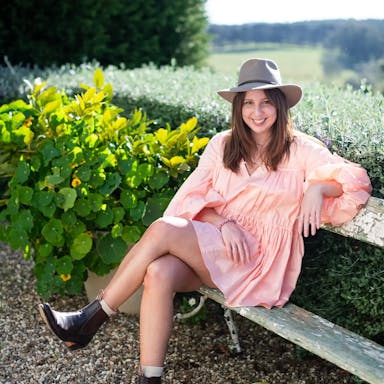
Freelance Writer
Alley Pascoe is an award-winning writer and bestselling author who has been based in Darwin for two years (meaning she has survived two cases of Mango Madness). She writes for the most-read magazines in Australia, including Marie Claire and Gourmet Traveller , and has co-written books including Heartstrong with Ellidy Pullin and Love and Pain with Silverchair band members Ben Gillies and Chris Joannou.
Published January 9, 2024
Last updated January 9, 2024
Articles you might like
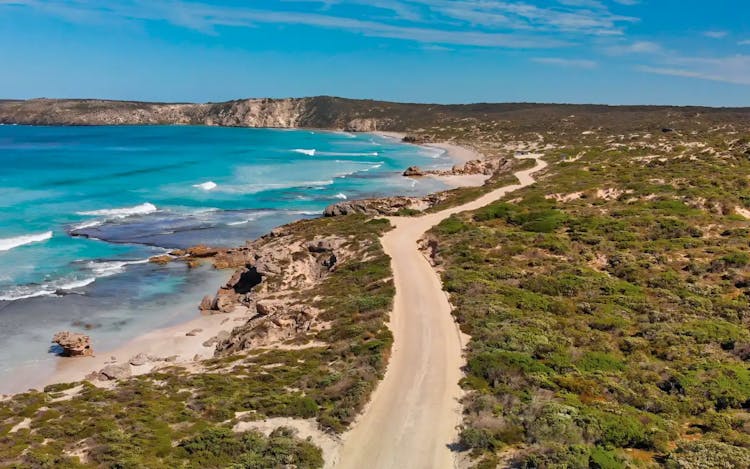
The Australian Island Home to 65,000 Kangaroos
Apr 3, 2024
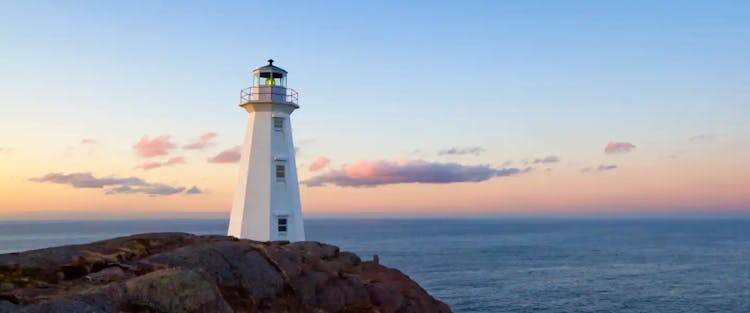
Newfoundland and Labrador: The Canadian Province of Puffins and Icebergs
Apr 2, 2024
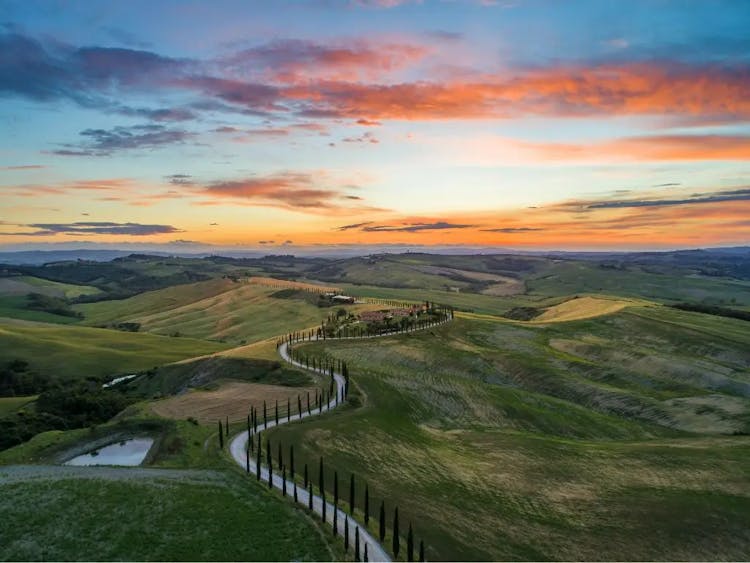
Tuscany: The Central Italian Region Where the Renaissance Began
Mar 27, 2024
Treat your travel to cheap flights
Most deals are 40-90% off normal prices with great itineraries from the best airlines. If it's not an amazing deal, we won't send it. Sign up for free to start getting flight alerts.

The Weather in Darwin, Australia What Is The Best Time To Travel To Darwin?
Darwin, australia weather stats, monthly temperatures and rainfall tables, darwin weather forecast:.
The weather of Darwin in Australia's tropics is influenced by only two seasons:
Dry season and wet season.
There is no spring, summer, autumn and winter here.
Below I have put together some information for people trying to work out what is the best time to travel to Darwin .
- Find out what the two seasons mean for the Darwin weather ,
- what that means for your travels (what is the best time to travel to Darwin ),
- check the tables with the monthly temperature and rainfall averages for Darwin.
You'll also find links to more helpful Darwin, Australia, weather information , and weather forecasts for Darwin .
Darwin, Australia - The Weather In General
A general rule of thumb for the weather in Australia's north, and therefore the Darwin weather, goes something like this:
The dry season is the best time for travel to Darwin. It lasts from April/May until September/October and brings beautiful weather in Darwin with clear blue skies, balmy nights and warm days. (If you look a bit closer you will find that especially the beginning and the end of the dry season can be quite hot.)
The wet season in Darwin starts around October/November and initially brings hot and steamy weather with the occasional spectacular lightning storm and short but intense rains. Temperatures drop a bit and rain falls increase as the new year approaches. Most of Darwin's rain falls between January and March. This is also the time of the year with the biggest risk of cyclones and floods.
Take those rules with a grain of salt. Darwin's weather during the dry season is very predictable, but real life wet seasons don't follow any rule of thumb... It may rain very early or very late or not at all for months. Wet season weather in Australia is above all unpredictable.
Return to top
How The Weather In Darwin Affects Your Travel. What is The Best Time to Travel To Darwin?
As I said, we can predict the dry season in Australia: the Darwin weather is perfect every day, no rain, comfortable temperatures, and huge tourist crowds ...
See, everybody is told the middle of the dry season is the best time to travel to Darwin and northern Australia, so everybody arrives here at the same time, which also coincides with the Australian school holidays. I'd say, disregard the standard advice about the best time to travel to Darwin. Don't go anywhere that's popular with tourists from mid June to mid August ...
In my opinion the very early dry season is the best time to travel to Darwin , followed by the late dry season. You will find slightly higher temperatures but the lower tourist numbers make up for it.
How early in the dry season ? Hmm, that depends on how much rain Darwin had in the wet season, and how late. And Australia's wet seasons are unpredictable...
It also depends on your plans. If you want to visit just the bigger and well known attractions around Darwin, go early. If you look at going bush and four wheel driving you'll need to wait a bit longer for the roads to open. I think early to mid May is a good compromise.
How late in the dry season ? It's funny. Nearly every year the Darwin weather features a few very hot days late in August or early September. All the tourists panic, hitch up their caravans and head south. And after that we get another three to four weeks of beautiful weather in Darwin, so that's a good window to catch. By the end of October it's usually too hot and sticky for the average tourist.
How about travel to Darwin during the wet season ? If you are adventurous and flexible and don't mind the warm Darwin weather, give it a go. Like most locals I love the wet season. It's spectacular and wild and exciting, and it brings life. Waterfalls are raging, all the wildlife is mating and breeding, wildflowers are blooming, and you can watch the plants grow. It's the best time of the year.
Just keep one thing in mind when you look at the temperature tables below: the Darwin weather is moderated by the ocean. As soon as you leave Darwin and head inland, say to Kakadu or Katherine, the temperatures will be much higher.
Darwin Monthly Weather Averages
Darwin temperature averages.
This table shows you the monthly temperature averages: the daily maximum, and the minimum for the night . The data was collected at Darwin airport between 1941 and 2004.
You are looking at long term averages , and averages can be deceiving. The temperatures at any given day or night can be well below or above that.
But more importantly, the humidity during the wet season is a lot higher, which makes the same temperatures just so much more uncomfortable... (To get an idea what the Darwin weather feels like during the wet season add about 7 - 10°C to the actual temperature.)
Darwin Temperature Extremes
This table shows the highest/lowest temperatures ever recorded at Darwin airport. This is where you want to keep in mind that as soon as you leave Darwin to go further inland the weather will be more extreme, much hotter during the wet season days, and much colder during the dry season nights.
Darwin Weather - Australia's North And Rainfall
This table shows rainfall amounts in mm: the average per month, the highest/lowest monthly rainfall that has been recorded, and the highest ever recorded daily rainfall amount for every month.
It shows very well the extreme variations, the unpredictability, and also how our rain often falls in a matter of a few hours or days. It's very impressive when it happens. Several hundred mm in one day is a HUGE amount of water to fall out of the sky...
Return to Darwin Australia main page
Return from Weather in Darwin, Australia to Outback Australia Travel Guide home page
Darwin Related Outback Guide Pages
- Darwin, Australia
- History of Darwin
- Darwin Weather/Climate
- Darwin Tourism
- Getting around Darwin
- Darwin's Attractions
- Kakadu National Park
- Litchfield National Park
- !! Free Outback Guide !!
- Site Search
AUSTRALIA TRAVEL
- Visa For Australia
- Work Visa For Australia
- Cheap Australia Flights
- Cheap Travel in Australia
- Train Travel in Australia
- Australian Outback Tours
- Campervan Hire
- Budget Travel
- Backpacker Hostels in Australia
- Work And Travel Australia
- Working Holiday Visa
OUTBACK ATTRACTIONS
- Kings Canyon
- Nitmiluk/Katherine Gorge
- Kimberley Australia
OUTBACK CITIES/TOWNS
- Alice Springs
- Coober Pedy
AUSTRALIAN OUTBACK
- Outback Animals
- Outback Pictures
ABOUT AUSTRALIA
- Facts About Australia
- Australian Climate
- Driving Distances
- Currency Converter
- Current Time In Australia
- Australian National Parks
- Australian Animals
[ ? ] Subscribe To This Site

When is the best time to go to Australia?

Nov 27, 2023 • 7 min read
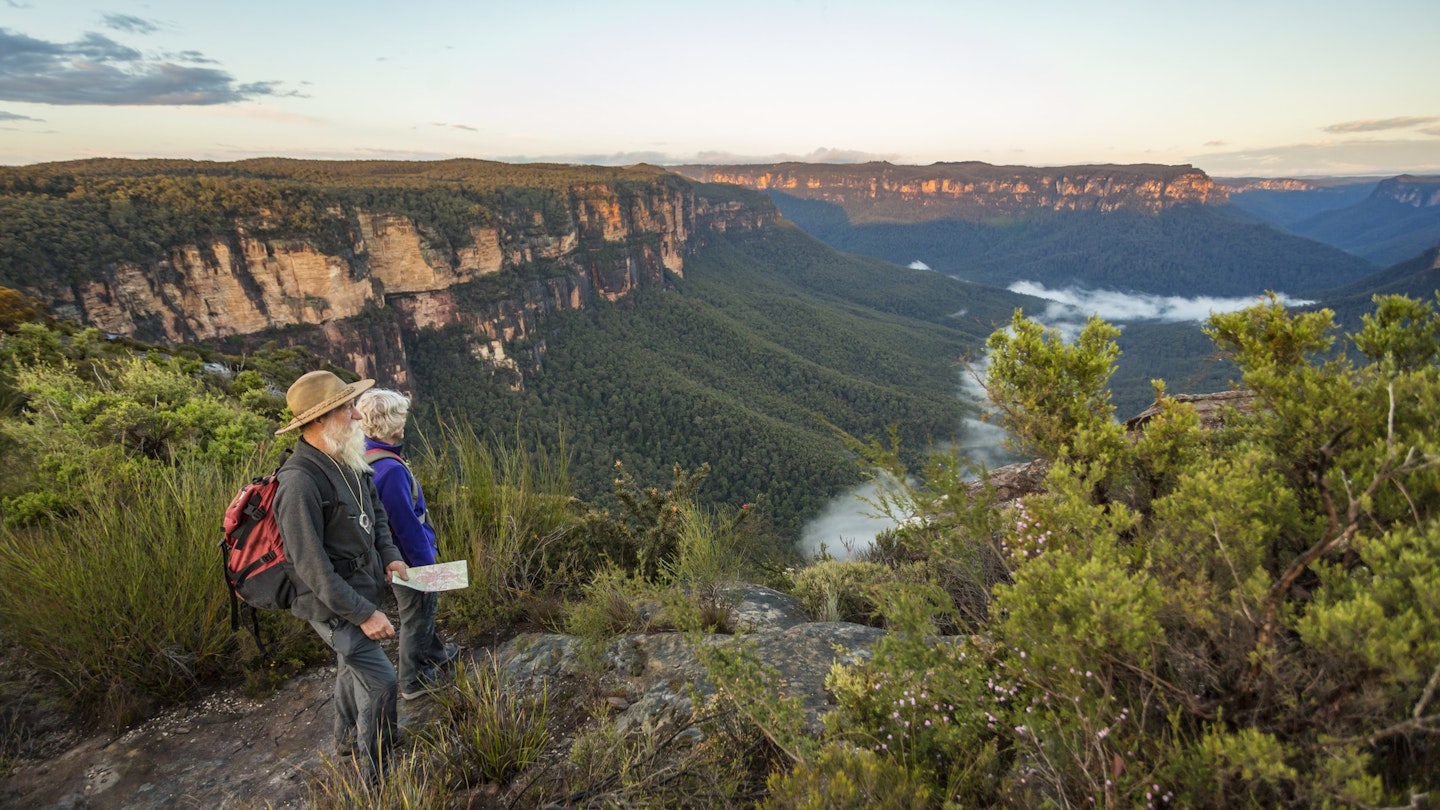
Plan the right time for your visit to Australia with this seasonal guide to what's happening through the year © davidf / Getty Images
As the sixth-largest country in the world, Australia has landscapes that range from dry savannahs and scrubland to lush tropical rainforests.
Each season brings its own magic, depending on where you are and when. Summer can either mean comfortable temperate days, blistering desert heat, or days of extreme humidity and frequent rain. Similarly, winter can deliver both snow or sunshine, depending on your location – and preference.
In short, the best time to travel to Australia depends on what you plan to do . From festivals to whale watching and wildflowers, here’s a seasonal breakdown of what's happening through the year.

December to February is the best time for beach days and festival vibes
Thoughts of Australia often conjure summer scenes of clear skies, brilliant sunshine and the sparkling ocean. December to February brings the hottest months with the longest days. This is also the peak travel season, so come prepared for crowds and premium rates on accommodation, particularly during Australian school holidays (which typically run from late December to late January).
Incredible as they are, there are plenty of ways beyond the beaches to enjoy summer in Australia. As Australia’s tropical north bunkers down for the wet season (with some remote regions such as the Kimberley all but closing up business until “the Dry” returns) this is the time to head south for festivals, sports and sunshine.
Big ticket events in January include the Australian Open tennis tournament in Melbourne and Sydney Festival , a visual and performing arts festival. Also not to be missed are quirky regional events such as Parkes Elvis Festival in rural New South Wales , timed to coincide with the King of Rock and Roll’s birthday.
In February, the world’s second-largest Fringe Festival (after Edinburgh) takes over Adelaide , while the streets are lined with glitter and rainbows for Sydney ’s version of Pride: the Gay and Lesbian Mardi Gras . There are also countless outdoor music festivals (both ticketed and free) across the country during this time, particularly over the New Year’s holiday period.

March to May and September to November are the best months for multi-destination adventures across the country
The shoulder seasons of spring (September to November) and autumn (March to May) can mean more rain in many areas, but much milder temperatures. This makes it easier to experience city and outback life in one trip.
During these periods, you'll find relief from otherwise scorching outback temperatures, making it the ideal time to visit destinations in the Red Centre including Uluru-Kata Tjuta National Park . Meanwhile hiking routes , including Central Australia’s Larapinta Trail, South Australia’s Heyson Trail and Cathedral Gorge in Western Australia’s Purnululu National Park, are a lot more manageable in the cooler months.
If you’re visiting the Kimberley between March and May, you may also be rewarded with glimpses of the waterfalls at the tail end of the wet season.
However, it pays to be aware that schools take two-week breaks, usually at the beginning of April and the end of September. Many Australian families take holidays during these periods, which can affect the availability and cost of accommodations.

June to August is the best time to snorkel on the Great Barrier Reef or hit the slopes
The winter months of June through August are generally the cheapest time of year to travel throughout much of Australia, with fewer tourists and better deals on flights and accommodations in most areas.
There are exceptions to the rule, though. The drop in temperatures and drier weather drives tourism to iconic destinations such as Uluru, as well as Cairns , Darwin and the Kimberley. (It can also be cooler than many tourists expect, with temperatures in the Red Centre dropping below 0°C/32°F overnight. Pack accordingly.)
In Queensland , jellyfish – including the infamous Irukandji – are less prevalent during winter, which also means it’s an ideal time to snorkel or dive on the Great Barrier Reef .
If you’re planning to visit these areas, be prepared to jostle for accommodation as domestic travelers from the southern states also head north to escape the cold, with most school districts taking a two-week break at the start of July.
However, it’s just as popular to head into the cold. While neighboring New Zealand is better known as a ski destination , Australia also has fantastic snow experiences to appease powder hounds. New South Wales’ aptly named Snowy Mountains – roughly 490km (304 miles) from Sydney – is home to Perisher (the largest ski resort in the country) and the nearby Thredbo resort. In Victoria, you can hit the slopes 385km (239 miles) from Melbourne in Falls Creek or take to the steeper runs of Mt Hotham.
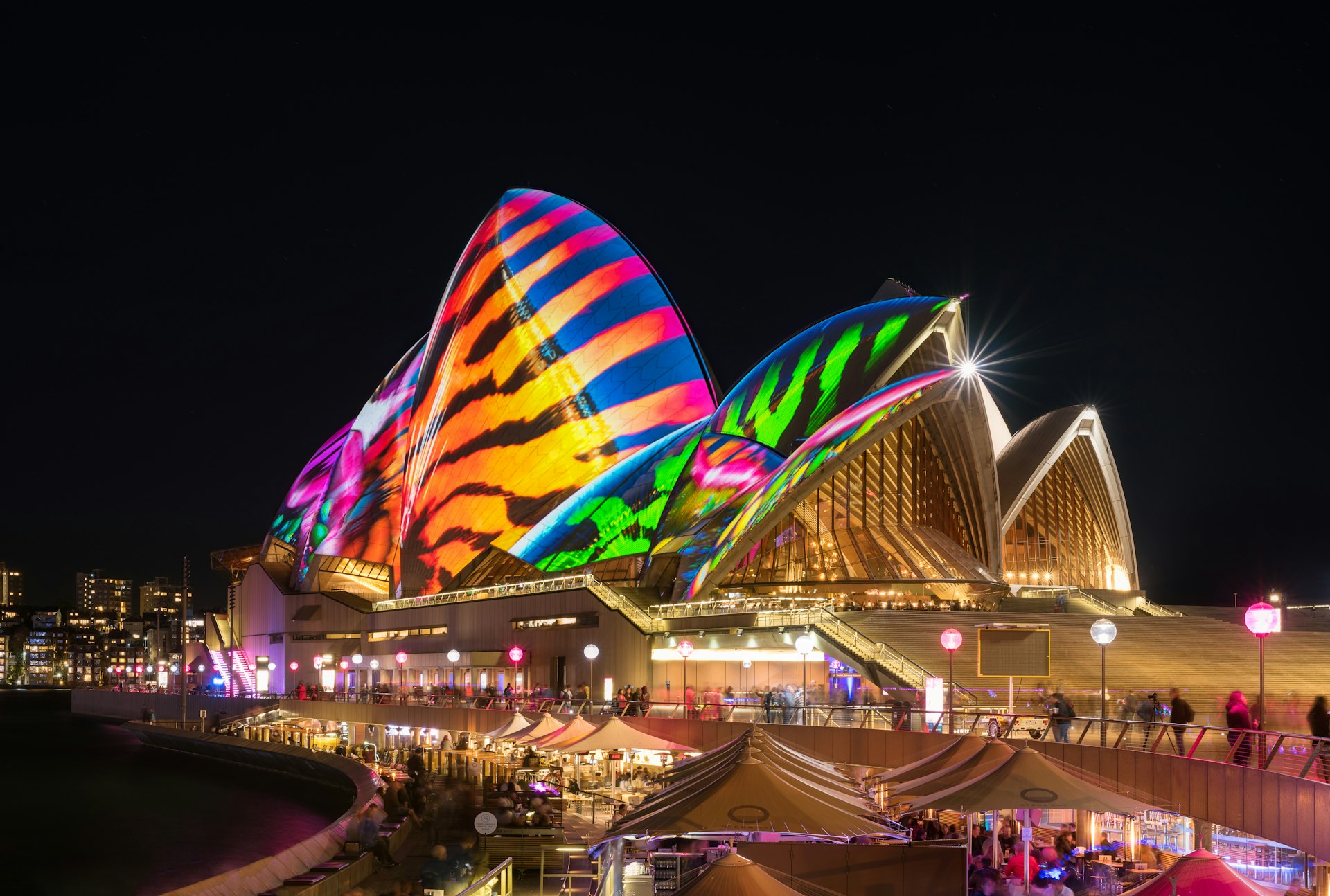
May to September is the time to experience Australia’s winter festivals
Winter doesn’t mean an end to the celebratory vibes. Instead, May to September is a flurry of activity in capital cities and regional hubs across Australia, with festivals to excite avid foodies, art aficionados, music lovers and more.
The return of shorter days is kicked off by Alice Springs ’ Parrtjima Festival in April. The free 10-night festival celebrates First Nations culture with interactive workshops and performances, and sees the MacDonnell Ranges transformed by an incredible light installation.
Next up is Hobart ’s subversive Dark Mofo festival – timed to coincide with the winter solstice in June. It’s one of the country’s most fêted off-season events, with massive bonfires, live music and performance art taking over the Tasmanian city. Dark Mofo is on pause for 2024, but daring visitors can still partake in the annual Nude Solstice Swim and Winter Feast.
Also in June, Sydney’s Vivid Festival draws visitors by the thousands for its light projections and a program of thought-provoking presentations. Similarly, Melbourne’s Rising Festival and Adelaide’s Illuminate both light up the long winter nights with bold projections and installations across the cities, alongside immersive free and ticketed events. Both are held annually between June and July.
On the other side of the country, foodies tuck into the season’s best at Truffle Kerfuffle in Manjimup, WA, followed by the Cabin Fever food and culture festival in July in Margaret River . Finally, if you’re in the Northern Territory in August, you might want to add Darwin Festival of arts and culture to your itinerary.
May to November is prime time for whale watching
If you love marine wildlife, May through to November marks the best months to glimpse whales as they make their twice-annual migration along the coast. Starting from April, tens of thousands of these majestic mammals begin their journey north from their Southern Ocean feeding grounds. They breed and give birth in warmer waters along Australia’s shores, before returning south with their young.
The coastlines of South Australia, Tasmania and Victoria are some of the best places to see southern right whales, while humpbacks and the occasional orca put on a show along the east and west coasts. Western Australia is the place to spot elusive sperm and blue whales.
Another phenomenon you may be lucky enough to see in Tasmania’s southern latitudes at this time of year is the aurora australis or southern lights. Popular places to witness the dancing colors include Cradle Mountain-Lake St Clair National Park , Bruny Island and the secluded Bathurst Harbour.
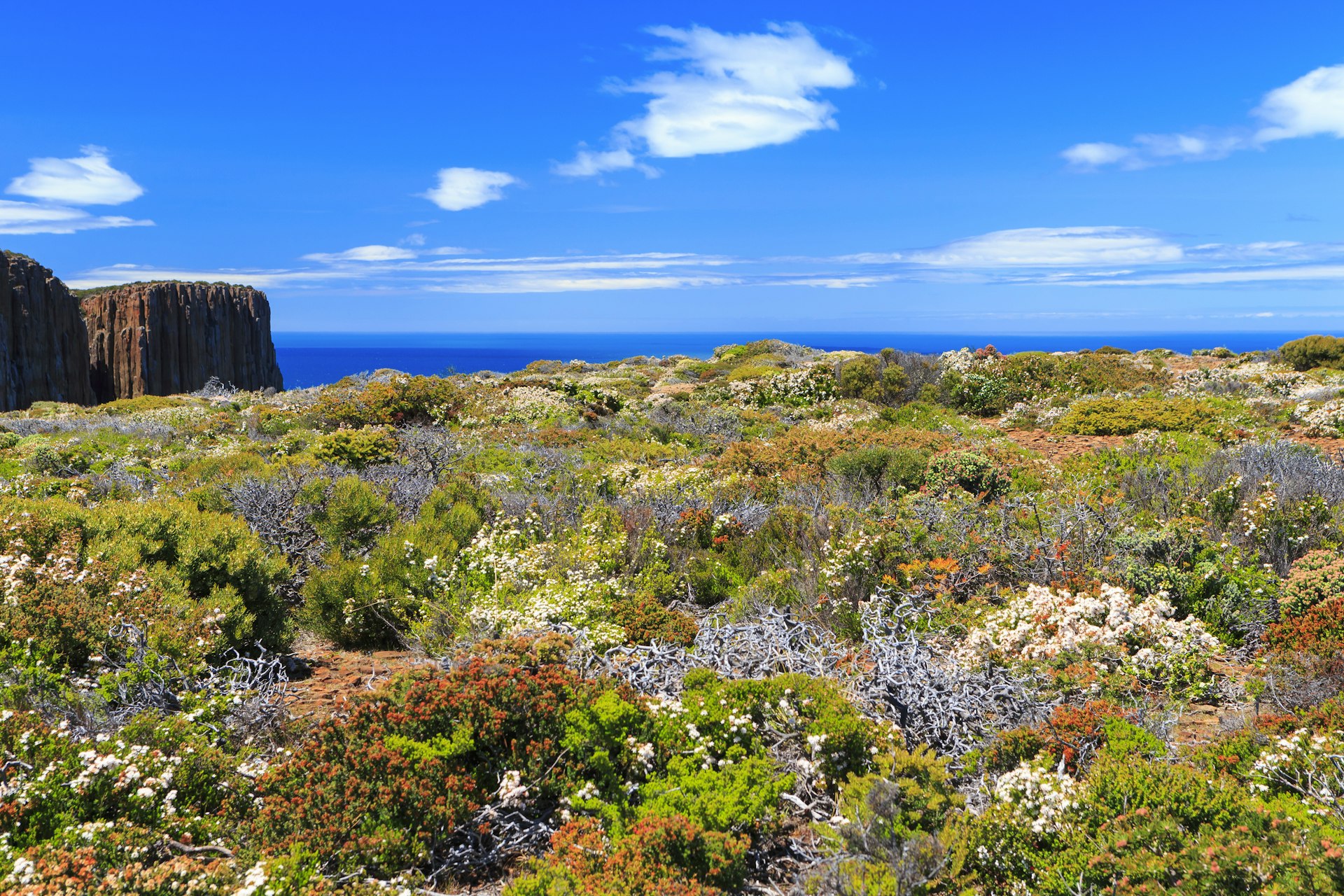
August to October is the best time to see rare and endemic wildflowers
We know what you’re thinking. Flowers, for spring? Groundbreaking. But thousands of Australia’s wildflowers bloom nowhere else on the planet. Case in point are the flowers of Western Australia’s southwest. There are more than 12,000 species, 60% of which are endemic to the region. The Indigenous peoples of this region, the Noongar, acknowledge six seasons of the year, and August to October marks the transition to Kambarang , the height of the flowering season. This is celebrated at Perth’s EverNow Festival in October.
Other notable places to experience the wildflower season include the Blue Mountains and Booderee National Park in New South Wales and Ikara-Flinders Ranges National Park in South Australia. Victoria also boasts numerous spots including the Grampians (Gariwerd) , which is home to one-third of the state’s flora and where the flowering season is known locally as petyan . The Dandenong Ranges are also a popular stop, particularly for those wanting to experience wildflowers and a winery or two of the nearby Yarra Valley .
At this time of year, you’ll find countless regional flower festivals across the country, alongside larger celebrations. Two of the biggest are Canberra’s Floriade (the largest flower festival in the southern hemisphere, hosted September to October) and Toowoomba’s Carnival of Flowers in September.
This article was first published March 2021 and updated November 2023
Explore related stories
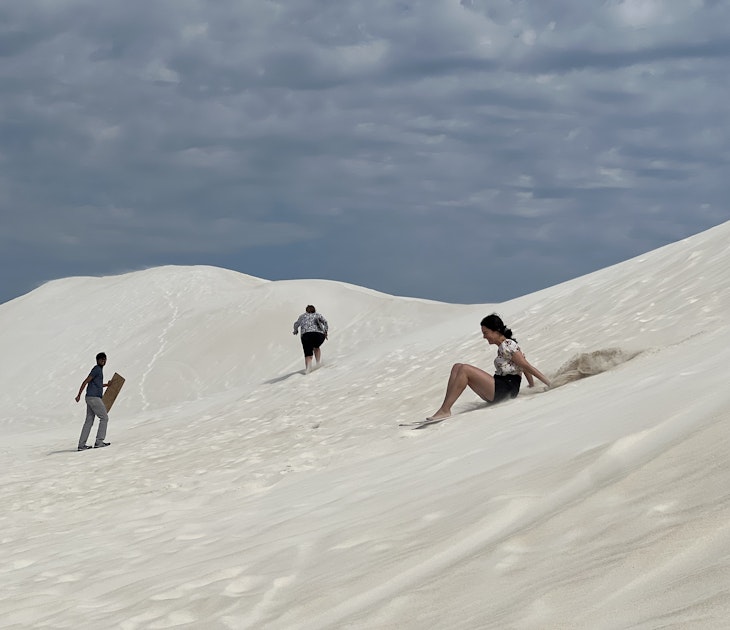
Art and Culture
Apr 4, 2024 • 5 min read
Perth’s immersive Indigenous experiences, stunning scenery and innovative culinary scene make it one of Australia's most exciting cities.

Mar 30, 2024 • 4 min read
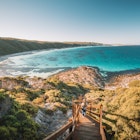
Mar 29, 2024 • 19 min read

Mar 26, 2024 • 8 min read
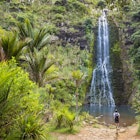
Mar 15, 2024 • 17 min read
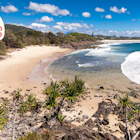
Feb 27, 2024 • 6 min read
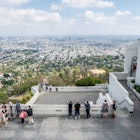
Feb 15, 2024 • 7 min read

Feb 9, 2024 • 12 min read

Jan 30, 2024 • 9 min read
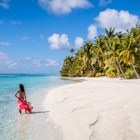
Jan 24, 2024 • 8 min read
The Best Time to Visit Darwin, NO, Australia for Weather, Safety, & Tourism
The best times to visit Darwin for ideal weather are
April 16th to October 14th
based on average temperature and humidity from NOAA (the National Oceanic and Atmospheric Administration). Read below for more weather and travel details.
Darwin Travel Guide
Temperature.
- Perceived Temperature
- Rain and snow
- Humidity and wind
- The busiest and least popular months
- Overall travel experience by time of year
Other Darwin Travel Info
Weather in darwin.
Average temperatures in Darwin vary very little. Considering humidity, temperatures feel hot for most of the year with a fair chance of precipitation about half of the year. The area is less temperate than some — in the 19th percentile for pleasant weather — compared to tourist destinations worldwide. Weeks with ideal weather are listed above . If you’re looking for the very warmest time to visit Darwin, the hottest months are November, October, and then December. See average monthly temperatures below. The warmest time of year is generally early December where highs are regularly around 93.7°F (34.3°C) with temperatures rarely dropping below 77.3°F (25.2°C) at night.
Darwin Temperatures (Fahrenheit)
Darwin temperatures (celsius), “feels-like” temperatures.
The way we experience weather isn’t all about temperature. Higher temperatures affect us much more at higher humidity, and colder temperatures feel piercing with high winds. Our perceived temperatures factor in humidity and wind chill to better represent how hot or cold the day feels to a person.
Darwin Perceived Temperature (F)
Darwin perceived temperature (c), average darwin temperatures by month.
Daily highs (averaged for the month) usually give the best indication of the weather. A significantly lower mean and low generally just means it gets colder at night.
Show Fahrenheit
Show celsius, precipitation (rain or snow).
If dry weather is what you’re after, the months with the lowest chance of significant precipitation in Darwin are July, August, and then June. Note that we define “significant precipitation” as .1 inches or more in this section. The lowest chance of rain or snow occurs around early June. For example, on the week of June 4th there are no days of precipitation on average. By contrast, it’s most likely to rain or snow in early to mid January with an average of 4 days of significant precipitation the week of January 8th.
Chance of Precipitation
The graph below shows the % chance of rainy and snowy days in Darwin.
Snow on the Ground
The graph below shows the average snow on the ground in Darwin (in).
Average Rain and Snow by Month
Show inches, show centimeters, humidity and wind.
Darwin has some very humid months, with other moderately humid months on the other side of the year. The least humid month is June (45.1% relative humidity), and the most humid month is February (76.7%).
Wind in Darwin is usually moderate . The windiest month is January, followed by February and June. January’s average wind speed of around 9.7 knots (11.1 MPH or 17.9 KPH) is considered “a gentle breeze.” Maximum sustained winds (the highest speed for the day lasting more than a few moments) are at their highest in early to mid January where average top sustained speeds reach 20 knots, which is considered a fresh breeze.
Relative Humidity (%)
The graph below shows the average % humidity by month in Darwin.
The graph below shows wind speed (max and average) in knots.
Average Wind Speeds
Show wind speeds.
All wind speeds are in knots. 1 knot = 1.15 MPH or 1.85 KPH.
Show Relative Humidity by Month
Is it safe to travel to darwin.
Our best data indicates this area is generally safe. As of Dec 04, 2023 there are no travel advisories or warnings for Australia; exercise normal security precautions. Check this page for any recent changes or regions to avoid: Travel Advice and Advisories . This advisory was last updated on Nov 30, 2023.
The Busiest and Least Crowded Months
The busiest month for tourism in Darwin, NO, Australia is August, followed by June and September. Prices for hotels and flights will be most expensive during these months, though you can save if you purchase well in advance. Tourists are unlikely to visit Darwin in November. Those willing to visit at these times will likely find it the least expensive month.
Estimated Tourism by Month
Most popular months to visit, overall darwin travel experience by season, fall (march through may).
Humidity and temperatures combine to make this season feel warm. Highs range from 91.8°F (33.2°C) and 88.3°F (31.3°C) with colder temperatures in the later months. Rain is somewhat common with 2 to 15 days of significant precipitation per month. Fall is the second busiest for tourism, which makes it a good time for those looking for things to do.
Winter (June through August)
The middle-year months have very comfortable weather with high temperatures that are quite warm. These months see the least precipitation with about 0 days of precipitation per month. June – August is the busiest season for tourism in Darwin, so lodging and other accommodations may cost more than usual.
Spring (September through November)
Spring daily highs range from 93.5°F (34.2°C) and 91.3°F (32.9°C), which will feel very nice given the humidity and wind. It rains or snows a significant amount: 2 to 9 days per month. Tourism is fairly slow during these months due to the weather, so hotels may be lower priced.
Summer (December through February)
Weather is perfect this time of year in Darwin to be enjoyable for warm weather travelers. The average high during this season is between 93.7°F (34.3°C) and 88.3°F (31.3°C). On average, it rains or snows a very great amount: 15 to 18 times per month. These times of year are the slowest with tourists.
Best Times to Travel › Australia › Darwin, NO, Australia
Similar Destinations
- Darwin City Centre, NO, AU
- The Gardens, NO, AU
- Larrakeyah, NO, AU
- Parap, NO, AU
- Fannie Bay, NO, AU
- Winnellie, NO, AU
- Coconut Grove, NO, AU
- Marrara, NO, AU
- Jingili, NO, AU
- Berrimah, NO, AU
Popular Destinations
- Sihanoukville, Cambodia
- Lake Eola Park, the United States
- Indianapolis, IN, US
Best Time to Visit
Best Time to Visit Australia: Month-by-Month Climate, Seasons, and Things to Do
Last Updated: April 6, 2024

Did you know you can celebrate Christmas in Australia in summer? The sixth largest country in the world, Australia, has 7 different climate zones: equatorial, tropical, savanna, subtropical, Mediterranean, arid, and oceanic climates. Famous for its heavenly nature, magnificent wildlife, snowy Alps, gorgeous beaches, iconic sites, sandstone formations, and lavender blooms, this colossal country requires intense planning. There are endless reasons why you can visit Australia, and its fabulous weather is one of them. It has a varied landscape, from dry deserts to lush rainforests, so expecting an array of weather comes naturally.
Each season in Australia brings its own charm. To study in depth, here is a look at the monthly weather, seasonal variations and the best time to visit Australia.
Best Time to Visit Australia

Australia is located in the south of the Southern Hemisphere, so there are a lot of weather differences compared to the Northern Hemisphere countries. Seasons are the other way around here. Depending on your list of things to do in Australia , you can plan and book the tickets accordingly. Here is a quick guide to seasonal conditions:
Winter (4°C to 18°C)

If you are used to experiencing snowfalls in December and January, get ready for a dramatic turn in the country of kangaroos. Winter in Australia falls from June to September. Temperatures rarely fall below freezing point, especially in the northern hemisphere and coastal areas. Some parts of Australia may experience extreme cold waves. Sydney receives heavy rainfall, and Melbourne is cold and cloudy. It is the right time for skiing and hiking.
Summer (23°C to 28°C)
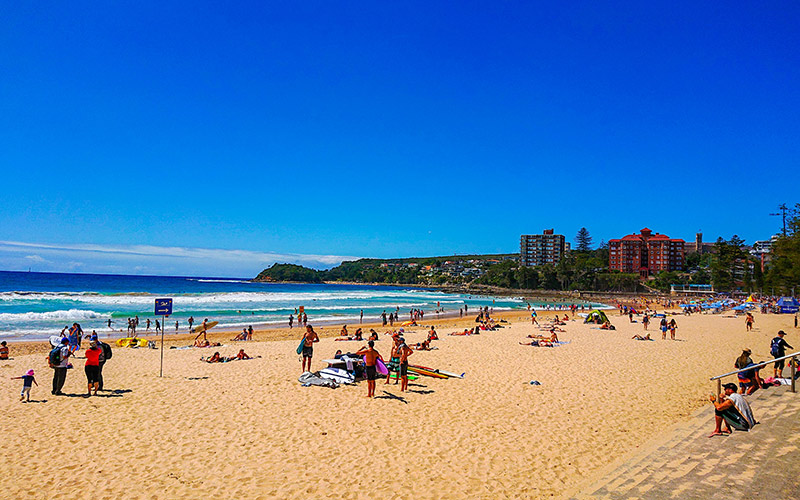
The warm, sunny days of Australian summer are ideal for beach fun and watersports. Slap some sunscreen on your face and body and drink warm-weather refreshers, such as mojitos. Attractions are packed with tourists and locals, accommodation rates soar, and the weather is in your favor. You can scape the southern heat and explore the lush rainforests of North Queensland, or dive into the colorful underwater life of the Great Barrier Reef.
Spring (20°C to 24°C)
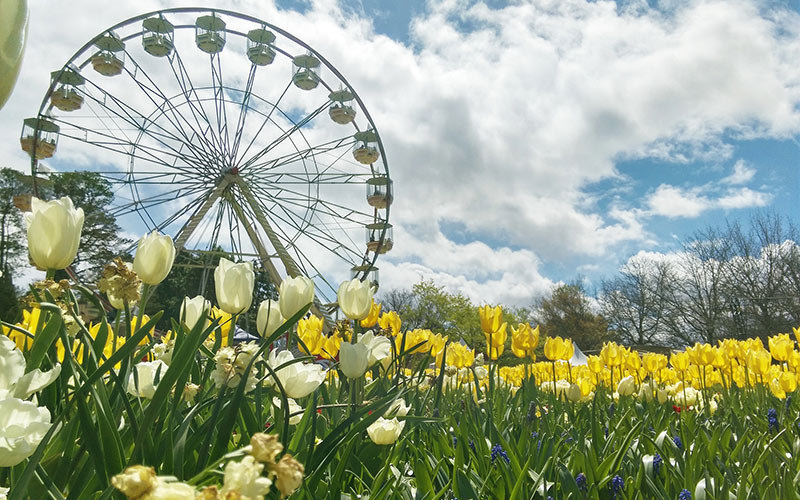
Spring is the best time to visit Australia for someone who still can’t make out between summer and winter. From September to November, you can visit national parks, such as like Kings Canyon or Uluru-Kata Tjuta National Park. Enjoy a vibrant display of wildflowers blooming across the country and go hiking without facing extreme weather conditions.
Fall (17°C to 19°C)
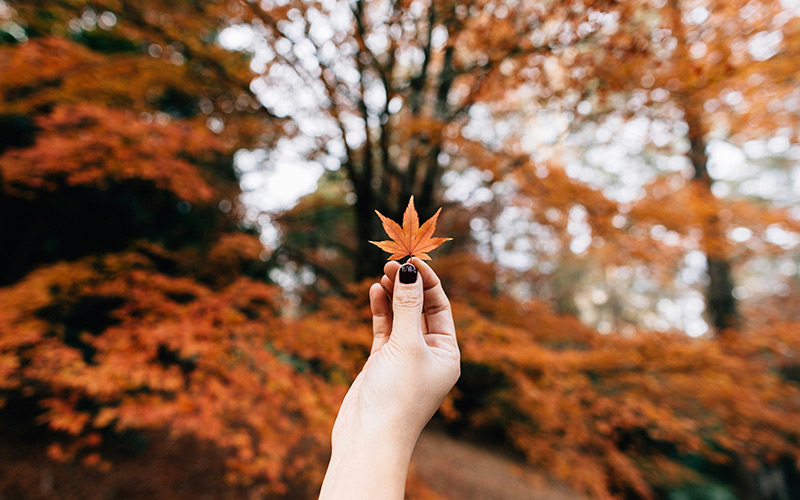
Another great time to visit Australia is the fall season. From March to May, the satisfying weather conditions and smaller crowds make touring around a comfortable experience. Fall paints Australian cities in warm hues. Enjoy outdoor dining, stroll through vibrant farmers markets, or take a scenic bike ride. During the fall, don’t forget to trek through the lush rainforests and wildlife sanctuaries.
Peak Season in Australia
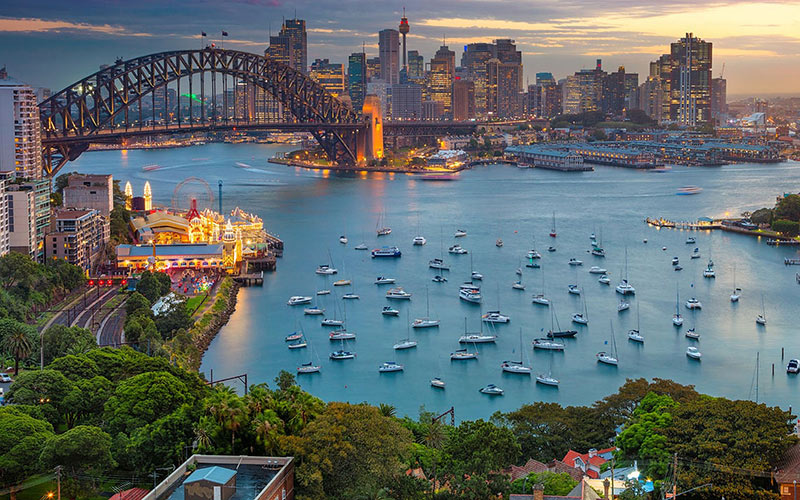
December to February experiences a rush of tourists; the decent temperatures and clear skies offer a wonderful time to indulge in city tours, road trips, beach sunbaths, and winery visits. To avoid this crowd, you can plan a trip in the winter, from June to September. It’s the tourists’ least favorite season. Other seasons to curb the mass are spring and fall, the unofficial shoulder seasons.
However, the northern coastline, home to the Great Barrier Reef, has the most pleasant daytime temperatures from April to September. At major attractions, you must book in advance; otherwise, you will have to elbow your way through the crowd. And so reversely, its low season is summer, as the city of Cairns and Red Centre can be extremely hot and humid. In case, you are traveling on a budget and prefer the summers, be prepared with your sunglasses and sunblock to take the heat.
Monthly Climate of Australia
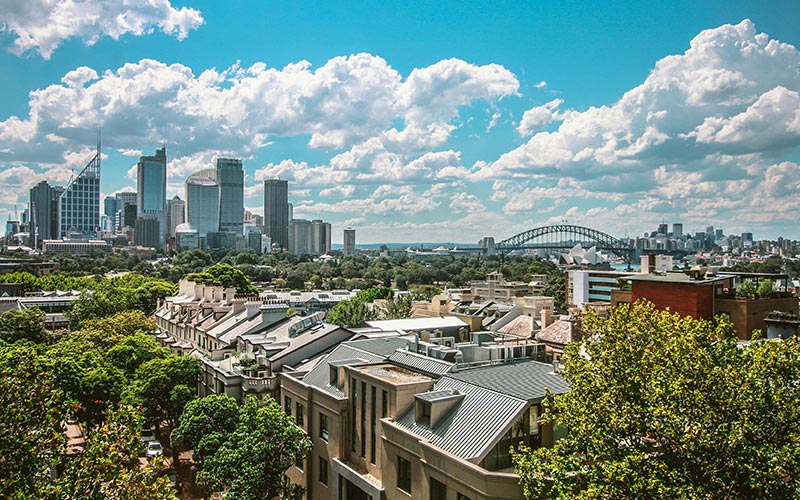
Boasting warm weather and plenty of sunshine, Australia in January is bliss. Catch the biggest New Year celebrations at Sydney’s New Year fireworks. Do expect larger crowds at popular destinations. In this hot and wet season, visit Kakadu National Park, go surfing, and witness a world-class Australian Open tennis championship.
Long summer days and cool nights highlight the weather of Australia in February. It is a wonderful time to stargaze in the Outback, explore the rock formations of Uluru, and experience evening camel riding across the sunset.
Autumn arrives, bringing a welcome cool-down across most of Australia. The North experiences the decline of the wet season, with comfortable temperatures. The South enjoys mild days and crisp nights. March through April, get ready to enjoy one of the most exciting things to do in Melbourne , Formula Grand Pix. Later, head to Adelaide for the Fringe Festival and enjoy fascinating regions like Barossa Valley.
The crowds start to thin out a bit after the summer rush, and there are still plenty of things to see and do outdoors. Go whale watching off the coast of Western Australia for a chance to see humpback whales migrating north. Explore the Ningaloo Reef, a World Heritage Site known for its manta ray encounters.
It is unofficially the entry of dry season in northern Australia, perfect for road trips. Pleasant autumn weather conditions tiptoe, allowing people to go for wine tasting, enjoy a scenic hike, and attend cultural festivals.
It is the best time to visit Sydney for outdoor activities. You can also find some good deals on flights and accommodations during this time. Head to the snowy mountains of New South Wales, Victoria, and Tasmania for some thrilling skiing or snowboarding adventures. If you’re looking to escape the winter chill, head to tropical regions like Cairns or Darwin.
One of the biggest concerns while traveling to Australia is its expensive airfares. In July, get a sigh of relief with cheap tickets. It is a great time to experience vibrant winter festivals in cities like Melbourne and Adelaide. Winter arrives in full force in the South, with average highs ranging from 10°C (50°F) to 14°C (57°F). There can be occasional rain and even snow in the mountains.
With a stronger potential for snow in the Alps, winter in Australia is a beautiful time to visit. From the calm waters of the Great Barrier Reef to Outback Adventure, August in Australia marks the near end of winter in the southern parts of the country and the peak of the dry season in the tropical north. Spring starts to peek through in some parts of southern Australia, with beautiful wildflower displays in regions like Namaqualand and Western Australia.
As the winter is about to depart, spring sweeps in. Although the sunshine keeps increasing and the temperature gets warmer, it is ideal for nature walks. Explore the remote paradise of Lord Howe Island, known for its stunning natural beauty and limited visitor numbers. Enjoy snorkeling, diving, or relaxing on pristine beaches.
October brings sunshine and warm days across most of the country. Spring is a great time to take a walk in the Royal Botanic Gardens. The crowds start to pick up a bit in spring, but they’re still not as busy as in summer. Enjoy the comfortable spring weather with outdoor activities like hiking, biking, or exploring national parks.
November brings warm days and cool nights to southern cities like Melbourne, Sydney, and Adelaide. Witness the annual whale migration along the Western Australian coast. Celebrate the arrival of spring with vibrant flower festivals held across the country, and indulge in nature at Grampians National Park.
Summer comes with buzz and festivities. While the rest of the world bundles up in layers, Australia goes for a walk along coastal cliffs. At the end of December, the country organizes Boxing Day (26th December), which is marked as an official holiday. It is also the time when schools and workplaces close, so Aussies are venturing out to popular holiday spots.
How to Visit: Australia Visa
Australia welcomes visitors with a variety of visa options depending on your purpose and length of stay. Australia tourist visa is a popular choice, allowing stays for up to 12 months with the option for multiple entries. Another choice is an Australia visit visa, which allows you to travel for family visits, medical reasons, or educational tours. Electronic Travel Authority (ETA) visas offer a simplified application process for passport holders from specific countries for shorter visits. Remember, visa requirements can change, so it’s crucial to check the latest rules and stay in touch with a local agent.
1. When is the best time to visit Australia for the beach?
From December to February, summer in Australia is the best time to visit for beach activities.
2. When is the best time to visit the Great Barrier Reef?
The Great Barrier Reef can be visited year-round. From April to October, visibility is high, and there is minimal rainfall.
3. Which season to avoid to visit Australia?
While visiting Australia, remember that the North’s wet season (November-March) can bring heavy rain and potential cyclones. Also, the South experiences its coldest weather during winter (June-August). So, plan well.
4. When is the best time to visit Australia to avoid crowds?
To avoid crowds, consider visiting during shoulder seasons such as fall (March to May) and spring (September to November). These months offer pleasant weather and fewer tourists compared to the peak summer season. Winter is the low season in Australia.
5. When is the best time to visit Australia for outdoor activities?
Outdoor activities are best enjoyed during the milder seasons of spring (September to November) and fall (March to May), when temperatures are comfortable for hiking, snorkeling, diving, and other adventures.
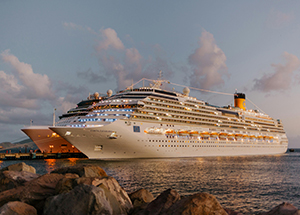
Exploring Why Cruises Are Better than Any Other Types of Vacation

Shambhavi Sisodia
Intrigued by the breathtaking beauty and unbelievable diversity around the world, Shambhavi has taken the agenda of inspiring travellers to embark on their new journeys with passion and information. She has a pen in one hand and a camera in the other. She is a food-enamoured introvert who is fond of plants, reads fiction and taps feet to Bollywood music.
Your email address will not be published. Required fields are marked *
This site uses Akismet to reduce spam. Learn how your comment data is processed .
Follow Us on :

Join The Newsletter
To Receive our best monthly deals
Get call back from us

- Ras Al Khaimah
- Kuala Lumpur
- Singapore Visa from Dubai
- Malaysia Visa from Dubai
- Thailand Visa from Dubai
- US Visa from Dubai
- Schengen Visa from Dubai
- China Visa in Dubai
- Canada Visa from Dubai
- Turkey Visa from Dubai
- Hong Kong Visa from Dubai
- Poland Visa from Dubai
- South Africa Visa from Dubai
- Web Stories
- Festivals and Events
- Romantic Destinations
- Travel Ideas
- Travel Tips
Best Time to Visit Australia
- Author david
- Date March 28th, 2024
Australia is an incredible travel destination with diverse landscapes, cities, and wildlife. However, as the world’s 6th largest country spans tropical to temperate climates, the weather and ideal travel times can vary greatly by region.
This guide breaks down the best times to visit Australia based on seasons, weather, crowds, prices, and must-see events .
Overview of Australia’s Climate and Travel Seasons
Australia has an area of 7,741,220 Square Kilometers , which is pretty huge. So, Australia’s climate varies a lot due to its size. Usually, there are 4 seasons, but the tropical north experiences both wet and dry seasons. Seasons in Australia are opposite to those in the Northern Hemisphere.
Key Takeaways
- The summer season(December – February) is hot and ideal for beach activities, while the north experiences heavy rains.
- The autumn season (March- May) sees vibrant colors, major festivals, and wildlife sightings.
- The winter season (June – August) and those months offer skiing in the south and warm days in the north.
- The spring season (September – November) features sunny days, blooming flowers, and wildlife sightings.
- The wet season ( November – April) is hot in the north, with monsoonal rains and possible cyclones.
- The dry season (May – October) in the north has clear skies and lower temperatures.
Climate Groups in Australia
Australia has 6 main climate groups: Equatorial, Tropical, Sub-tropical, Desert, Grassland, and Temperate.
1. Equatorial

The equatorial climate group found in the northern tip of Queensland is characterized by high temperatures, high humidity, and consistent rainfall throughout the year.
2. Tropical
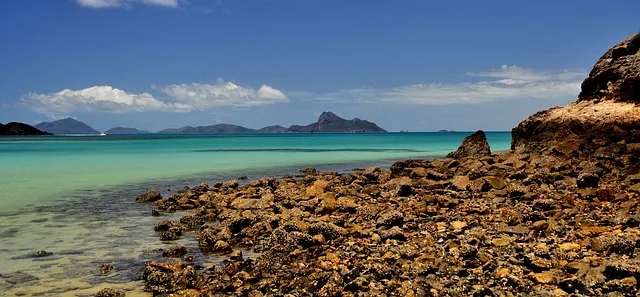
The tropical climate group covers the top end of the northern territory and northern parts of Queensland , known for distinct wet and dry seasons with heavy rainfall during the wet season and high temperatures.
3. Sub-tropical
The sub-tropical climate group is located along the Queensland coast and inland fringe ; it experiences mild winters, hot summers, and occasional rainfall.

The Desert climate group occupies arid and semi-arid areas in the center of the continent , characterized by high temperatures during the day, chilly nights, and minimal rainfall.
5. Grassland
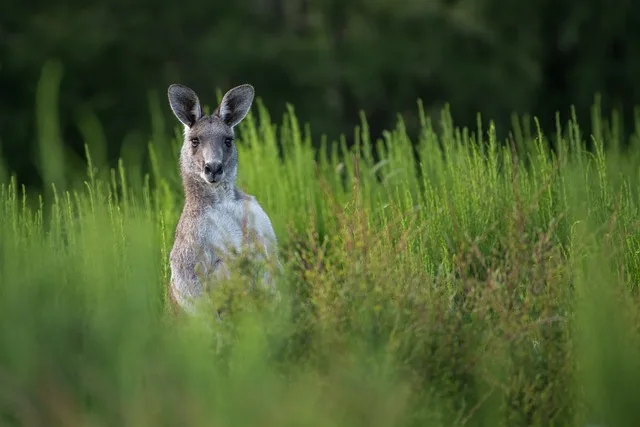
The grassland climate surrounds arid and semi-arid desert areas, found in regions like the Red Centre and Flinders Ranges , which feature moderate temperatures and sparse vegetation.
6. Temperate
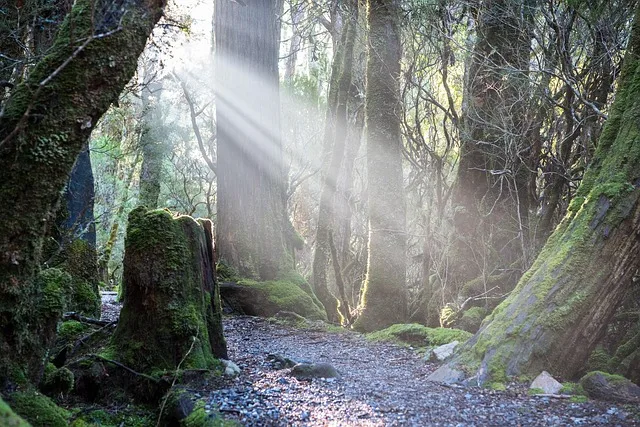
The temperate climate covers coastal regions of New South Wales, Victoria, Tasmania, and parts of South Australia, marked by 4 distinct seasons with varying temperatures and precipitation.
Weather and Temperatures by Season
1. summer (december-february).
During the summer, southern cities like Sydney and Melbourne experience warm to hot weather with lots of sunshine, becoming perfect for hitting beaches, exploring coastal national parks, and the Australian passion for water sports.
In January, temperatures typically range from the 20s °C into the mid-30s °C, with afternoon sea breezes offering relief. Inland cities can be really hot, with many consecutive 40°C+ days in Adelaide , commonly called the “oven city.”
In the tropical north, the wet season is in full swing with heat, humidity, daily thunderstorms, and heavy rainfall. The beaches may be less inviting, thanks to stingers (jellyfish, crocodiles, and other marine hazards). However, the upside is the greenery, rivers, and spectacular waterfalls, perfect for nature adventures well off the typical tourist trail.
2. Fall (March-May)
As summer’s heat mellows in fall, temperatures become more pleasant all over Australia, typically ranging from the mid-teens to 20°Cs during the autumn months. Humidity decreases while rainfall continues in the north in places like Cairns or Darwin .
Parks and gardens bloom with color from fall foliage, and seasonal produce lends itself to popular food and wine festival offerings, especially around Melbourne and Adelaide. Daytime highs can still occasionally spike, so sun protection is still essential when active outdoors.
Light layers that can be added as the occasional cooler change blows in are recommended.
3. Winter (June-August)
While the southern states endure cooler temperatures ranging from daily highs of 12°C to 15°C and below freezing overnight, the north stays relatively warm and becomes peak tourist season with clear sunny days and minimal rain.
The tropical north posts average temperatures from 25°C to 30°C with cooler evenings.
The ski slopes welcome enthusiastic powder hounds to resorts mostly located a few hours from cities like Sydney and Melbourne. Lovers of winter sports and snowy holiday vibes have their chance during the Australian version of the Christmas season in July.
4. Spring (September to November)
As the winter chill transitions to warming spring weather, passengers aboard boats spot migrating humpback and southern right whales along the eastern and southern coasts. Wildflowers emerge, carpeting huge swathes of WA’s Southwest corner, the Flinders Ranges in South Australia, and many other pockets around the country.
Mild spring weather welcomes more daylight and revives Australians’ outdoorsy passions, like sports events and music festivals. Temperatures climbing back into the 20s make for pleasant days to enjoy urban gardens and bushwalking.
However, the ocean may still make you feel full of energy for swimming beyond north Queensland until later spring.
Festivals and Events

Crowds and hotel prices ebb and flow in sync with major festivals, school holidays, and sporting events.
Here are some highlights:
January – March
- The arts scene starts with the Sydney Festival in January.
- Adelaide Fringe also livens up its namesake city through February.
- The Australian Open tennis tournament also draws hordes of spectators in January.
- March brings people to Melbourne for Formula 1’s kickoff race, which also overlaps with the Adelaide Festival season.
April – June
- April offers hippie vibes with Byron Bay Bluesfest .
- Canberra Balloon Spectacular creates picture-perfect moments against the Brindabella Ranges.
- Vivid Sydney’s brilliant light projections and performances illuminate the Emerald City in May.
- Quirky Darwin Beer Can Regatta also recycles fun in the Northern Territory that same month.
- Through the Winter months, NAIDOC Week celebrates Aboriginal and Torres Strait Islander history and culture nationwide.
- Dark Mofo’s midwinter parties brightly contrast with Tasmania’s long nights in June.
July – September
- Meanwhile, theater buffs applaud the Melbourne International Film Festival premieres in July.
- September ushers in Australian Rules football finals time with the AFL Grand Final showdown in Melbourne.
- Canberra’s Floriade Bloom Festival draws green thumbs nationwide.
- The Royal Melbourne Show demonstrates agricultural awards.
October – December
- Spring racing carnival peaks on Melbourne Cup Day in November.
- Festivities wrap up the year with the Sydney to Hobart yacht race departing Boxing Day.
Ideal Times for Different Interests
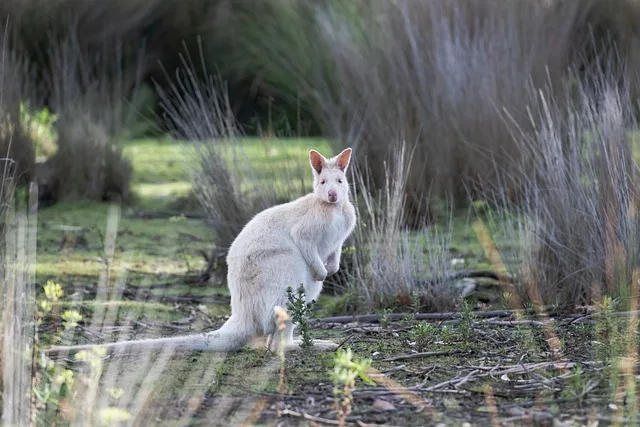
Shoulder seasons offer savings for budget-focused travelers along with pleasant weather for covering multiple regions. Peak winter brings snow adventures, spring whales, and wildflowers. Wildlife enthusiasts find fab opportunities in different locales each month.
Here is a basic idea of an ideal time based on your interests:
1. Budget Travel
Aim for April–May after the school holiday rush and September–November before the Christmas summer crowds hit. Prices and crowds peak from December to February.
2. Beaches and Outdoors
Pack the swimmers October–April to enjoy the Gold Coast, Sydney’s Bondi, and Melbourne’s vibrant St Kilda, among endless other stunning options. Summer stingers limit ocean swims in North Queensland.
3. Avoiding Crowds
Steer clear of major cities during school holidays and big events noted above. Outback destinations welcome fewer tourists, sticking to the winter months ́ more moderate temperatures.
4. Wildlife and Nature
June-November offers superb land-based wildlife sightings, especially for kangaroos and wallabies with young in tow. The winter dry makes 4WD touring easier to access remote nature preserves too. Humpback highway whales pass from November to April.
5. Skiing and Snow Adventures
Snow sports enthusiasts from overseas and Australia flock to Thredbo, Perisher, and Victoria’s winter resorts from June into September to ski, snowboard, or simply frolic in the snow. School vacation periods spike crowds and prices in July.
Australia’s seasons offer diverse weather and events, influencing tourism patterns. Peak summer sees crowds and premium prices; winter brings snow adventures. Shoulder autumn and spring periods offer mild temperatures for comfortably touring multiple regions, often with cheaper costs and fewer people.
If you don’t mind temperature extremes, off-peak summer and winter allow discounted deals. But shoulder months open more opportunities for wide-ranging adventures.
Choosing the correct timing around the seasons will ease planning and set you up for your perfect Australian holiday!
Become a member for $5/month!
Connect with me, leave a reply cancel reply.
Your email address will not be published. Required fields are marked *
Related Posts
Great walks of australia, 5 things to do in darwin, australia, top things to see and do in sydney, australia.

IMAGES
VIDEO
COMMENTS
Garramilla to its traditional owners the Larrakia people, the city lies on a peninsula at the far north of the Northern Territory and is cooled by breezes off the waters that surround it. More than any southern Australian capital, Darwin has two distinct seasons: the wet, from November to April, and the dry, from May to October.
Darwin is the capital city of the Northern Territory and the gateway to the Top End. It has a balmy tropical climate with low humidity and no rainfall in the dry season (May to September). The wet season (October to April) is when the rains come and the waterfalls are at their best. Learn more about the weather cycle, cultural attractions and wildlife of Darwin and the Top End.
Guide to Darwin. Aboriginal name: Gulumerrdgen (pronounced Golom-merrd-gen) With everything from Asian food markets and crocodile encounters to open-air movies and sunset cruises, Darwin is as easy going as it is exciting. If balmy nights, colourful characters and outdoor adventures are on your bucket list, you'll want to visit Darwin, located ...
The best time to visit Darwin is between June and September, when the humidity is lower, the weather is stable and the national parks are accessible. The wet season (November to March) has its advantages too, such as less crowds, lower prices and more wildlife. Learn more about the advantages and disadvantages of each season and the highlights of the Top End.
Kakadu National Park, a world heritage-listed area 253km east of Darwin, experiences the same wet and dry seasons as the rest of the Top End.. May to October is cooler and drier and considered the best time to travel here. From November to April is when rains roll across the Top End, replenishing waterfalls and filling waterholes to the brim.
When is the Worst Time to Visit Darwin. October to April represents the wet season in Darwin. Characterized by high humidity, heavy rainfall, and occasional cyclones, this time is regularly considered less favorable for travelers. From October to December, temperatures change drastically, averaging between 25°C to 33°C (77°F to 91°F).
Darwin, Australia's "top end," is one of the most interesting and exciting places to explore in the entire country - well, in my opinion at least. ... The best time to visit Darwin is the dry season from April/May until September/October. If you are planning to travel in the rainy season, you should know that some roads may get ...
Wondering when is the best time of the year to visit Australia's "northern capital", Darwin? We've got all the advice you'll need here! ... Best time of the year to visit Darwin. By Mel · August 2023 · 3 min read. The most populated city in the Northern Territory, Darwin is a favourite for visitors looking to explore the Top End and the ...
The best advice is not to go anywhere that is popular with tourists between mid-June and mid-August. The best time to visit Darwin is during the early dry season, and the second-best time is during the late dry season. The temperatures are slightly higher, but the lower volume of tourists make an even trade. Wet Season (October/November to April)
What is the best time to visit Darwin? it is the 'dry season' in Darwin from April/May to September/October. It brings along itself a beautiful weather with warm days and clear skies which definitely makes it the best time to visit. ... Best Time to Visit Australia. Things To Do In Darwin . Darwin Military Museum. Darwin Harbour. Mindil Beach ...
The best time to visit Darwin is winter, from June to August, as it is the least hot and the driest time of the year. Darwin - Climate data The average temperature of the coldest month (July) is of 25.2 °C (77.4 °F), that of the warmest month (November) is of 29.6 °C (85.2 °F).
May through October is the peak travel season in Darwin, characterised by sunny days and an upbeat vibe. Now the city brims with energy, best displayed at flavourful Mindil Beach Sunset Market, which draws big crowds with its wide array of stalls selling all from food and drinks to arts and crafts on Thursdays and Sundays.
Best time to visit Darwin... Unlike southern parts of Australia, Darwin and the rest of the Northern Territory's Top End (including the Kakadu, Arnhem Land and Katherine regions) don't have the traditional four seasons. Here in the tropical north there are just two main seasons - the wet and the dry - and what you'll be able to see and do during each season is as markedly different ...
The best time to visit Darwin Considering the weather conditions, the period between May and September emerges as the ideal time to visit Darwin . The temperatures during this span remain comfortably warm, ranging from 21.8°C (71.2°F) to 31.7°C (89.1°F), with humidity staying at the lower side of the scale, from 57% to 64%.
Best Time to go to Darwin. The best time to go to Darwin is typically during the dry season, from May to October. During this time, the days are warm and dry, with little to no rainfall and lower humidity than during summer. This time of year also compares favorably with southern Australia, which is in the grips of winter and is typically cold ...
Visit in May or early June to avoid the crowds. If you want to visit both regions, the best time to visit the Northern Territory is from May to October, thanks to the lower humidity levels and the ability to access most parts of this incredible destination without the risk of flooding. The biggest town in the Red Centre is Alice Springs, which ...
Western Australia offers wonderfully remote outback experiences: from spectacular national parks to sandy deserts, pristine beaches to working cattle stations. This itinerary allows you to explore the way from Perth to Darwin in depth and at your own pace, in your own rental car. view trip ⤍. 14 days / from10070 USD.
Best time to visit Darwin. The dry season, from May to October (Australia's winter), is the best time to visit, when the weather is warm—but not stiflingly so—and the days are sunny. Most of the city's main events and festivals are held during this time so there's plenty to see, do, and revel in.
Best Time to Visit Darwin. If you're wondering when to go to Darwin, you're not alone. It's a legitimate question considering the tropical climate. There are two distinct seasons in Darwin, wet and dry. Luckily, my trip occurred during the dry season. However, I've been to a few places in Australia during the wet season, and it's not fun.
A general rule of thumb for the weather in Australia's north, and therefore the Darwin weather, goes something like this: The dry season is the best time for travel to Darwin. It lasts from April/May until September/October and brings beautiful weather in Darwin with clear blue skies, balmy nights and warm days.
December to February is the best time for beach days and festival vibes. Thoughts of Australia often conjure summer scenes of clear skies, brilliant sunshine and the sparkling ocean. December to February brings the hottest months with the longest days. This is also the peak travel season, so come prepared for crowds and premium rates on ...
Here's some information to help you in your decision: The best months for good weather in Darwin are April, May, June, July, August, September and October. On average, the warmest months are January, February, March, April, May, August, September, October, November and December. Darwin has dry periods in June, July and August.
Summer (December through February) Weather is perfect this time of year in Darwin to be enjoyable for warm weather travelers. The average high during this season is between 93.7°F (34.3°C) and 88.3°F (31.3°C). On average, it rains or snows a very great amount: 15 to 18 times per month.
To avoid crowds, consider visiting during shoulder seasons such as fall (March to May) and spring (September to November). These months offer pleasant weather and fewer tourists compared to the peak summer season. Winter is the low season in Australia. 5.
Australia is an incredible travel destination with diverse landscapes, cities, and wildlife. However, as the world's 6th largest country spans tropical to temperate climates, the weather and ideal travel times can vary greatly by region.. This guide breaks down the best times to visit Australia based on seasons, weather, crowds, prices, and must-see events.